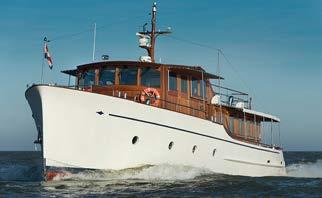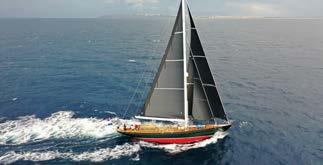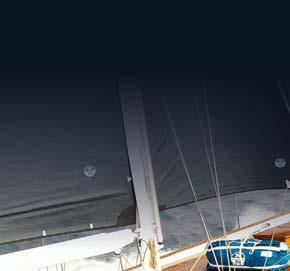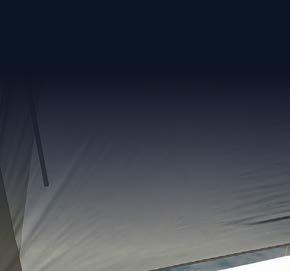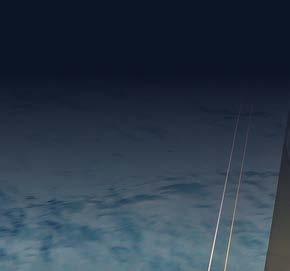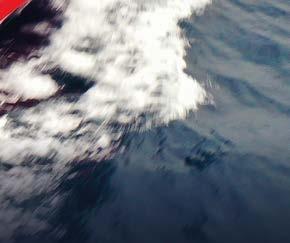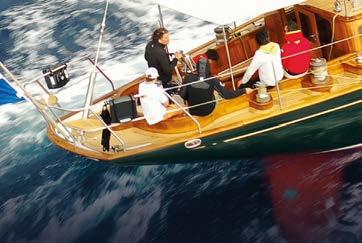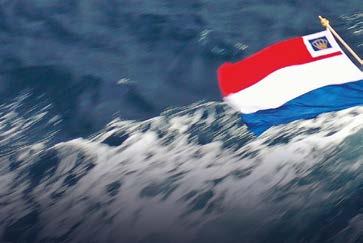



















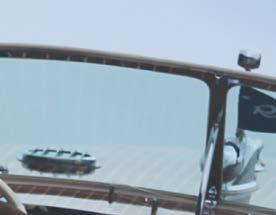





























































There are sailboats, and there are Skerry Cruisers. With their spectacular elegance and with a peppered history as only boat types that tend to extremes can have. This also applies to this unique SK30 Tre Sang. The legendary Englishman Colonel “Blondie” Hasler, for example, bought her in November 1945 and sailed the ship from the south coast west wards around Land’s End into the Bristol Channel in a ‘mild if wet November’. Between November 1945 and August 1946, Tre Sang left more than 2,600 nautical miles in her wake on the open sea without any significant difficulties, winning race after race. Tre Sang was built in Sweden in 1934 according to plans by Harry Becker, but certainly not for this purpose. How
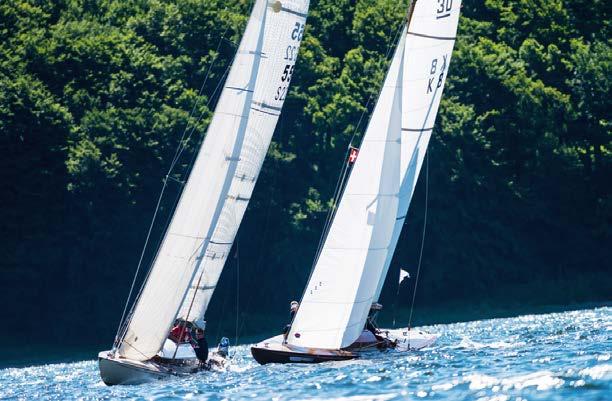

ever, even in her early years in Sweden, she was one of the fastest and most successful 30’s until she was sold to England in 1938, the first ever Skerry Cruiser to do so. She sailed with various owners in Sweden, Eng land and Wales as well as with her current owner, first on the Bavarian lakes, then in Uruguay and, since 2009, on the Baltic Sea with her home port in Flensburg at Robbe & Berking Classics. This boat was never renamed; the name means something like “a particularly good hand at cards” in Swedish. Even as developments in yacht building continued, the “Skerry Cruiser” remained as they were: long, narrow, elegant, wet and fast. Timeless and always popular, even today.
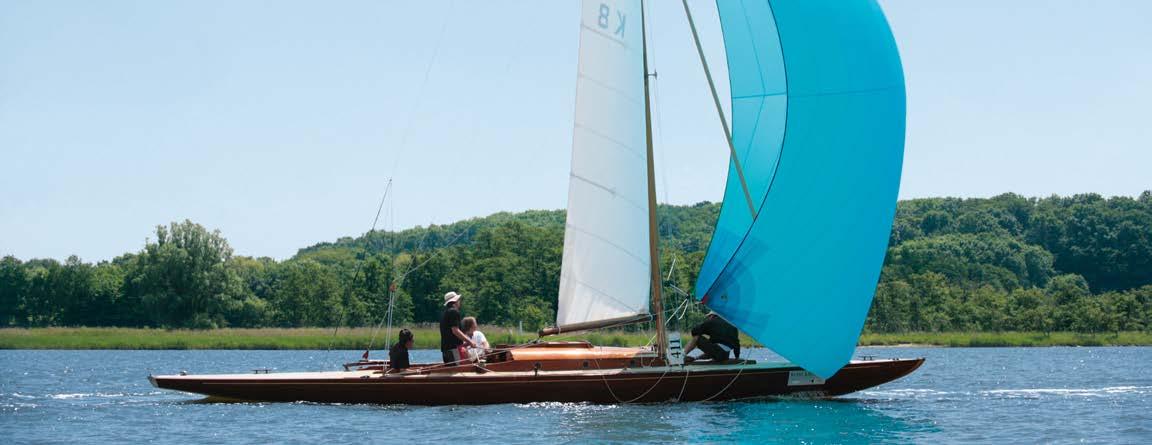
It seems unbelievable that we have never to my knowledge – in 35 years of publishing – really tackled the subject of yacht interiors. There have been interviews with designers over the years and we once gave an award for the best interior as part of our annual awards in 2015, to the schooner Altair. Given that the interior of a seagoing yacht is by far its largest liveable space, contains nearly all the boat’s volume and is the place where a crewmember will spend at least half his or her time at sea, and given how much effort and expense goes into creating a good interior, and how much sailors love them, this seems quite an amazing omission. Just as amazing is the fact that no reader has ever asked us to tackle the subject of yacht interiors. Not one! Well, like it or not, we’ve dived into it this month, with a brief look at the history of yacht interiors, and a list of guiding principles from experienced bluewater sailor Roz Cunliffe. And on the subject, you might like the cosy below-decks of our lead yacht this month, Constance (page 4). A cosy bolthole for when autumn skies thicken...

COVER STORY
. CORNISH NEW BUILD
new 34 wooden yacht in the manner of a Falmouth quay punt

. 12-M CLASS CLASH

from Flensburg, Germany
. CORK WEEK
yacht racing in Ireland
. YORKSHIRE ROSE
19th-century Voluta, once the cock of the eet in Yorkshire
. KEEPING THE HERITAGE
Gail McGarva and her mission to preserve working boat history
. BOSUN’S BAG
the diesel
. POLYMATH OF POTTERING

story of Victorian yachtsman and






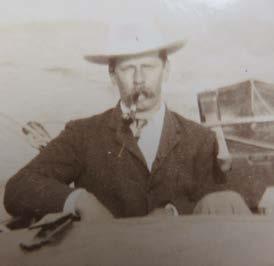


the proli c FB Cooke
STORY
. RIVA CENTENARY
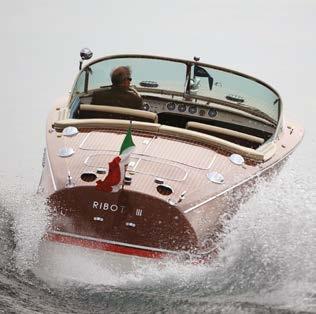
legacy of Carlo Riva and his fabulous boats, a century a er his birth
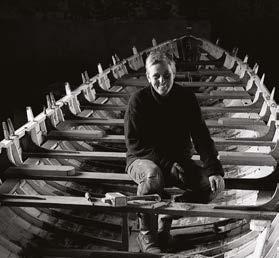
STORY
. YACHT INTERIORS


inside story
TOM CUNLIFFE
. PARTY TIME
rum to stun a bu alo, followed
a WW2 commemorative sail
. FATHER-AND-SON TEAM
Riva’s yard in Maldon, Essex
TELL TALES
SALEROOM

OBJECTS OF DESIRE
CLOSE QUARTERS

 WORDSAND PHOTOS NIGEL SHARP
WORDSAND PHOTOS NIGEL SHARP
have to have a passion for wooden boats and be slightly mad to commission a brand-new one these days,” said Simon Wisker, owner of the new gaff cutter Constance. “You are making a personal investment in preserving traditional skills without getting it back in financial terms.”
Simon began sailing in the early 1970s when his father built a Mirror dinghy. For several years he and his family sailed this boat, and then later a Wayfarer, in Poole harbour near their home, and also on family holidays on the Percuil River, near St Mawes in Cornwall. Having continued to sail a bit at university in Exeter and then in Aberdeen, he built a 14ft (4.26m) clinker dinghy and took his own children sailing in the Lake District and on the west coast of Scotland. Ten years ago, retirement brought him back to Exeter, from where he went on holiday to St Mawes, which is where his interest in gaff cutters began.
Seeing the 1895 Falmouth working boat Florence on the harbour beach having a scrub in readiness for Falmouth Sailing Week about 10 years ago, he chatted to one of her skippers, Bill Handley. Florence belongs to a syndicate, and when it became apparent that there was a share available, Simon agreed to buy one. This resulted in frequent journeys between Exeter and St Mawes, and Simon often found himself leaving his crew mates to enjoy a post-race beer or two in St Mawes Sailing Club while he drove home.
He and his wife Kay briefly considered buying a small holiday cottage in St Mawes until he began to think that the answer might be to have a boat, maybe even to build a new one. He initially envisaged a boat small enough to sail on his own, something like a 20ft (6m) Mevagissey tosher, and camping on board under a boom tent. “But Kay said that she didn’t really want to camp on a boat,” said Simon. “She wanted something bigger that was really comfortable for her and the dog.” Although he started to look at the possibility of buying a secondhand boat – including, at one stage, a Bristol Channel pilot cutter – it wasn’t long before he found himself going in a different direction.
Below: Constance under construction at Gweek Classic Boatyard

Facing page: Constance under sail o St Anthony’s Lighthouse
Inset: Ben Harris making the point that Constance can sail herself
For some time Simon had been following the career of boatbuilder Ben Harris, and might have been interested in his appeal for volunteers to help build the Ed Burnett gaff cutter Panacea (CB366 to 372) were it not for the distance between Exeter and his workshop near Falmouth. Simon contacted Ben who told him that Alva, the gaff cutter, which he had built for himself in 2011 (CB286) was for sale. “We went to look at her and could see that she was a lovely boat,” said Simon, “but Ben convinced us that she would be no use to us at all and what we really needed was a brand-new boat, which he could build.”
Some time ago Ben took the lines off Curlew, the Falmouth Quay Punt made famous by the ambitious exploits of Tim and Pauline Carr, and had made no secret of his desire to build a boat to these lines. But at 28ft (8.5m) LOD she was quite a bit smaller than the boat that Simon and Kay now envisaged – it was becoming apparent that their accommodation needs would necessitate a hull more like 34ft (10.4m) – and so naval architect Jack Gifford was brought in to help with the project. Jack put Curlew’s lines on his computer, and analysed some of her key parameters such as her shape, ballast ratio, and centre of buoyancy coefficients “just to try to see why this boat had proved herself as such a well-behaved sea boat, and to try to characterise her shape,” he told me. When he initially scaled up the lines to 34ft he found that this resulted in too heavy a boat. “So she required a bit of pairing down in the mid body section to bring her back to around 12 tonnes, which is what you would want a non-working gaff cutter of that size to displace,” he said. He also used various characteristics of Alva and the Ed Burnett Ivy Green, which were reference boats that Simon admired. Jack drew the sail plan but with input from both Simon and Ben, “with no particular reference yachts but just trying to pull in ideas from various rigs we had seen.”
The question of where to build the new boat soon resolved itself when Ben found out that the shed at Gweek Classic Boatyard, in which he had been temporarily storing Alva, was available for a longer term.
During Simon’s earliest discussions with Ben, he made it clear that he would like to play a hands-on role in the build of the boat. It took a little while before they agreed how that should work, but then Simon’s involvement began at the very beginning, with the lofting. Initially Jack thought that he would provide CAD drawings for the moulds and so on, and so it wouldn’t be necessary to do any lofting, but Simon was particularly keen to do much of this himself, albeit under Ben’s close supervision. As it turned out, it was of great benefit, because Ben, Jack and Simon were able to look down at the full-size lofted lines from a mezzanine floor, from which they could see some small imperfections and from which they all agreed that it would be advantageous to make small modifications to the sheer and the freeboard. “It was definitely a collaborative process of design, which was very enjoyable,” said Ben. “It was a real pleasure to do that,” added Jack. “It isn’t always possible but, as Ben must be


the absolute closest boatbuilder to my house, it was quite easy to do so!”
Constance’s hull was built from oak and larch. Oak was used for the keel, stem, sternpost, deadwoods, sawn frames, steamed timbers, the garboards and the next four planks up, and the sheer strake and next plank down; the remaining 14 planks are larch, all of them full length.


Ben had sourced the oak for the keel (max width 22in x 8in) about three years previously from SH Somerscales in Grimsby, and much of the other oak had been sourced even earlier than that, locally from the Tregothnan Estate on the banks of the Truro River. About three quarters of the sawn frames are in single futtocks. “We had exactly the right shapes to be able to do that,” said Ben. “So that makes her lighter as well as stronger.”
Throughout most of the length of the boat there are three steamed timbers (2in x 1¼in) between each pair of sawn frames but in the mast area, where there is a greater concentration of sawn frames, there is just one. Simon remembers going to Somerscales “with a tape measure and rough drawings on the hottest day in 2019” to select the larch to be used for the planking. The majority of planking is 1¼in thick and the sheer strake is 1½in. Everything was fastened with aluminium bronze bolts or copper clenches.
Ben and his team cast the five-tonne lead keel themselves, pouring the molten lead into a wooden mould bound with steel “to make sure it wasn’t going to burst open or anything – it looked like some kind of Gothic horror sarcophagus buried in the ground.” They happened to do it on a really hot day and Ben said “it was like being in the pits of hell.” Afterwards they complied with a long-standing boatbuilding tradition by rewarding themselves with a barrel of beer. The ballast keel was bolted to the wood keel with 10 x ¾in aluminium bronze bolts into galleries in the lead.
The beamshelf (6in x 2in amidships and tapering at the ends) and the deck beams (laminated for the coachroof and solid for the foredeck and side decks) are all oak. The deck itself consists of two layers of ½in yellow cedar (the lower one fore-and-aft, the upper one at 45 degrees, and glued together with resorcinol), sealed on top with glass and epoxy, and then with a 5/16in
Above: Fitting the shutter plank
Below: Finishing the deck details
Facing page, clockwise from top left: The teak for the decking was reclaimed from a 1920s cruise ship; Ben Harris’s builder’s plate; Traditional teak skylight over the saloon; The Fife rail around the mast; The forepeak; View of the galley from the chart table; Mainsheet block; Goosenecks
thick laid teak deck with oak covering boards. Ben favours this sort of subdeck rather than plywood as cedar is “more or less impervious to rot, and if you have any water ingress, it is always localised. It doesn’t spread through the solid wood, unlike plywood which tends to wick moisture through its many layers.”
The teak for the decking, the 1½in thick coamings and for the traditional skylight on the coachroof, had been reclaimed from a 1920s cruise ship which had been scrapped. “I chanced upon a local chap who had been bequeathed a load of it by his dad,” said Ben. “He had used most of it to floor his entire house and I offered to remake his floors in oak in return for the teak, but he said it was too much hassle.” But he still had a number of unused 15ft x 5½in x 2½in boards, which Ben was able to buy from him, albeit with some former fastening holes and ingrained iron stain in them, some of which is now visible in the skylight. “But I think that’s fine,” said Ben, “because it tells a story of where it came from.”
Although Jack produced comprehensive drawings for the interior design, “quite a few alterations were made in situ with Simon just holding up bits of wood in different places and just sketching it out on bits of wood,” said Ben, “to make sure that everything would be comfortable just for them.” The layout from the companionway going forward consists of the chart table to port (with an oilskin locker aft of it) and galley to starboard; seating to port and starboard with a folding table between, a pilot berth outboard to port and bookshelves outboard to starboard; a wood-fired heater to starboard and then a passageway with the heads compartment to port; and then the fo’c’s’le with a berth to port and a wide shelf to starboard. All of the interior joinery is made up of oak and white painted tongue-and-groove larch, and has a light airy feel to it. Constance’s interior generally feels surprisingly spacious for her length and has comfortable standing headroom throughout.
The engine is a Beta 35hp diesel; the engineering and electrical installation was done by Andrew Cox Marine, the instrumentation by BT Marine (Electronics); the stainless steel water and fuel tanks were fabricated by Keefe Engineering, and the Hobbit stove was supplied by Salamander Stoves in Devon.
Ben and his team also made the spars, all in Douglas








fir with a hollow gaff and the others solid. John Albrecht made up the rigging and many of the stainless steel fabrications; Colin Frake supplied much of the galvanised hardware and the blocks; the self-tailing winches are from Australian company Hutton Arco and many other deck and rig fittings came from Davey & Co and Toplicht. The sails are by Ratsey & Lapthorn. Throughout the build of the hull, Simon spent two or three days a week working with Ben and his core team of Pete Paxton, James Pardo and Josh Neely “doing whatever I was told to do”. But 11 days after the shutter plank was fitted the first Covid lockdown began and, as Simon’s circumstances then put him in a medically vulnerable category, that forced the end of his hands-on involvement. “As I am a perfectionist I was initially concerned that I would be frustrated not being involved in the build,” he said. “But whenever I managed to visit I was never disappointed with the workmanship or the decisions Ben had made. I completely trusted the way he and his team worked.” With the intention of remaining at least remotely involved, Simon planned to build Constance’s clinker tender but, after losing his workshop when he and Kay sold their house, he was unable to do so. The tender was then built by Josh, alongside Constance. Constance’s build started in September 2019 with an original plan to launch sometime in 2021. However, Covid restrictions and consequent increases in lead times for materials and equipment held things up, and


Above, left: Launching at Gweek in the rain
Above, right: Early sea trials
Below, left: Simon (grey tee) on the helm with son George (yellow tee) and boatbuilder Ben

Below, right:
Under way in light winds
so a decision was made to “slow down and get her done properly,” said Simon. She was eventually launched on a rainy day in May 2022.
When I asked him about his plans for Constance, Simon seemed embarrassed – and unnecessarily so – to admit that he hasn’t got anything particularly ambitious in mind, at least not in the immediate future. He sensibly realises he has little experience handling a boat of this sort – Florence is about half the size in displacement terms and, although he regularly crews on her, he only occasionally takes the helm on the way to and from races – and so he sees the first season or two as a time to slowly get to know Constance before he starts thinking about going further afield. He is mindful of the fact that Kay “isn’t a super keen sailor” and so, in addition to sailing plans, he is looking forward to “just being aboard – with the wood burner on it is fabulous to be in that cabin,” he said.
What will be of great benefit in getting to know Constance is that Ben has gone to great lengths to make her as easy as possible to sail shorthanded. She is a well-balanced boat and so it is possible to carefully tie the tiller to a windward winch and then leave her to sail herself in a straight line for significant periods. Tacking singlehanded is relatively straightforward with a little practice and Simon’s confidence with that is already growing. One thing is for absolute certain, and that is that wherever he takes her, near or far, he can hold his head high – very high – with pride.
















A total of 10 of the best 12-Metre yachts on the Baltic circuit, including nine classics and one modern 12-M turned out in Flensburg for the annual Robbe & Berking Sterling Cup recently.

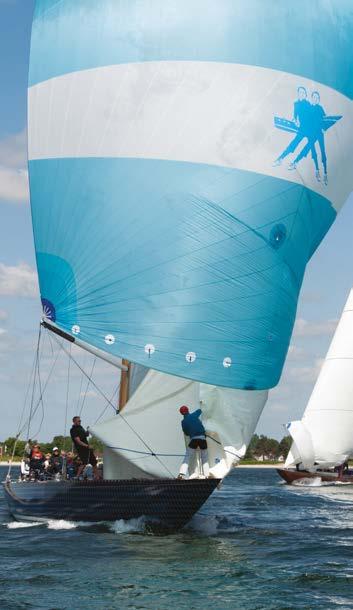
Besides the 12-Metres, the organisers always invite a selection of other yachts such as Dragons, 6-Ms and 8-Ms but this year in addition, thirteen 5.5-Ms sailed the class Open German Championships, and a dozen classic Rivas provided an extra classic atmosphere.
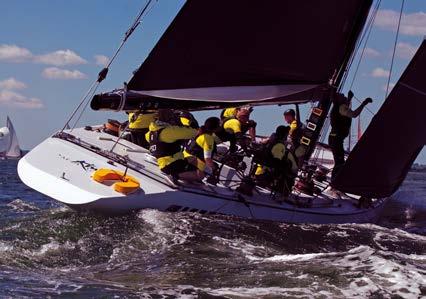
For years, the top five or six of the Baltic 12-M fleet has been a fairly evenly matched group but with the Olin Stephens-designed Vim from 1939 regularly topping the list as the winner. However, this year newcomer Northern Light not only shook up the competition but has also given fresh impetus to the already immensely popular 12-M scene in the Baltic.
Together with the tune-up races in Dyvig, Denmark the weekend before, no fewer than 16 races were sailed. With so many closely-matched yachts in this class, the lead changed constantly throughout the races, but over the course of the event it became clear that Northern Light had somehow found an edge in boat speed and tactics, resulting in four firsts, two seconds and one third.


Like Vim, she was built by Nevins in New York and designed by Olin Stephens. She is a year older than Vim, but clearly already steeped in Stephens’ design genius. She was only the second 12-M designed by Stephens, the first being her almost identical sister ship Nyala. Another newcomer that performed well was Nini Anker, formerly known as Siesta and built in 2015 by Robbe & Berking to a design by Johan Anker.
Part of the strength of the growth of the Baltic 12-Metre fleet is because racing is mainly done with amateur sailors and the owners helm the boats themselves. The support of Patrick Howaldt (the owner of Vim and vice-president of the International Twelve Metre Association) and Oliver Berking over the years in various projects has of course contributed significantly to the growth of the class.
The racing for the Sterling Cup was much more exciting than the Low Points Scoring System indicates. In the final results for example, four of the nine yachts had scored a first place. In many races the di erence between first or second place was a matter of seconds. But there is no doubt that Northern Light was the deserved winner with only 13 points over nine races. Nini Anker was on her heels with 17 points and Vim in third place with 28 points. It should be mentioned that Vim’s end result was seriously hampered by the fact that a crew member was injured in race two and she withdrew and did not start the third race that day.
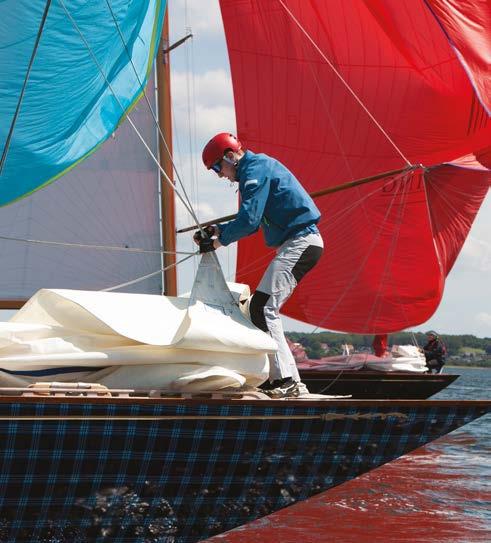

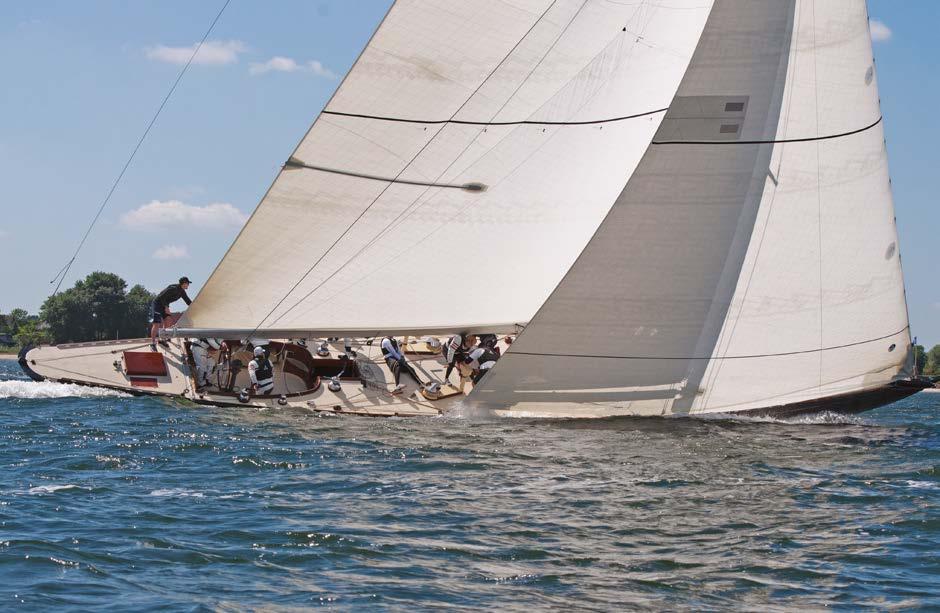
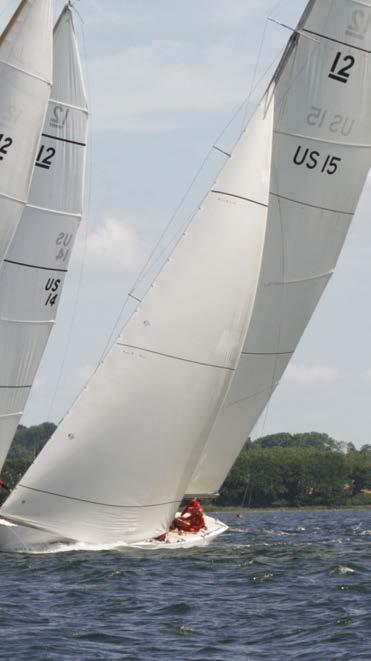

The 2022 edition of Volvo Cork Week held in July in Crosshaven saw 192 boats taking part in a full five-day programme of racing inside and outside Cork Harbour.
Racing took place on five separate courses with 14 di erent classes taking part, including the Classic Class, which enjoyed tremendous sailing in Mediterranean conditions on a series of windward/leeward courses o Roaches Point. A total of 18 classic yachts attended the regatta with nine entering the racing including two Cork One-Designs: Elsie owned by Patrick Dorgan and Jap, which was helmed by Harold Cudmore for the week.
The 2022 classics regatta was the result of the postponed Cork 300 event, which had been scheduled for 2020. Colin Moorhead the Admiral of Royal Cork Yacht Club at the time felt there was an opportunity to capitalise on a burgeoning classic scene in southern Ireland. “The Atlantic Yacht Club in France had committed to a ‘Go to Cork’ initiative for 2020 and were keen to finally make it happen in 2022. “Our event in 2022 was very much a toe in the water but it was a great success and certainly bodes well for the future. We hope to make an announcement soon about a stand alone Cork Classic Regatta for 2025.”

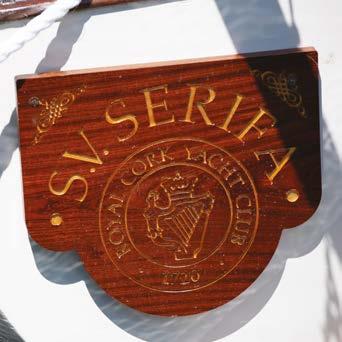
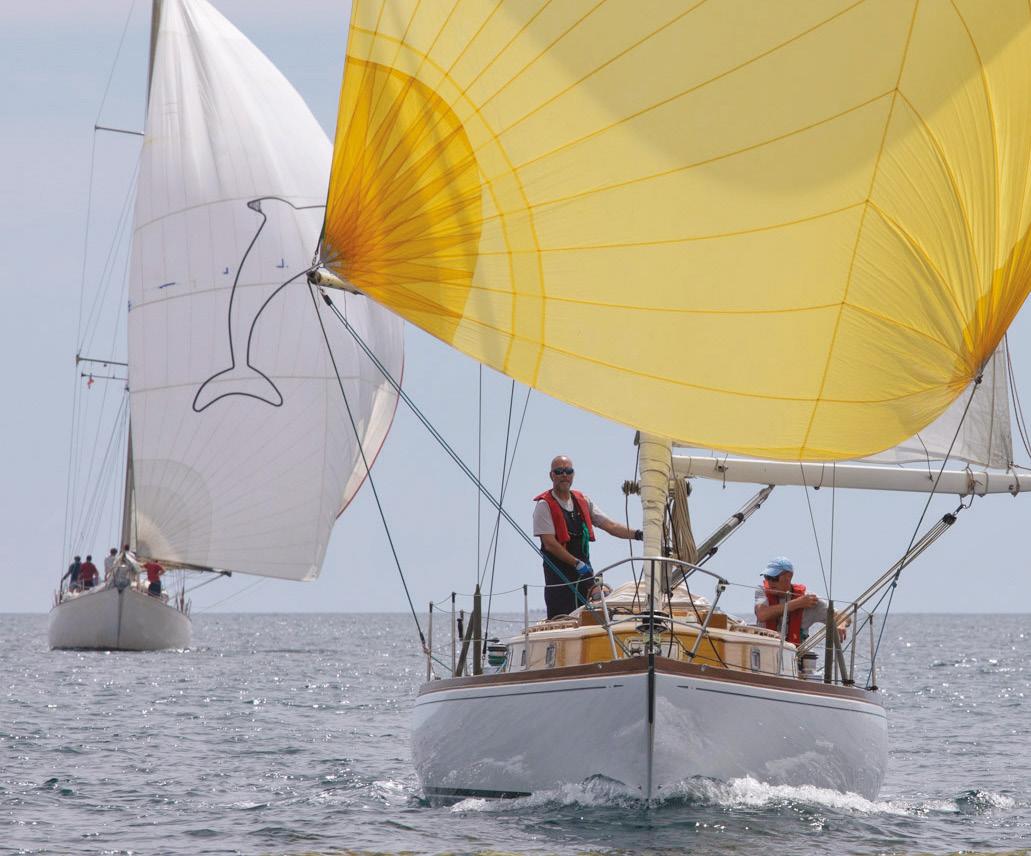

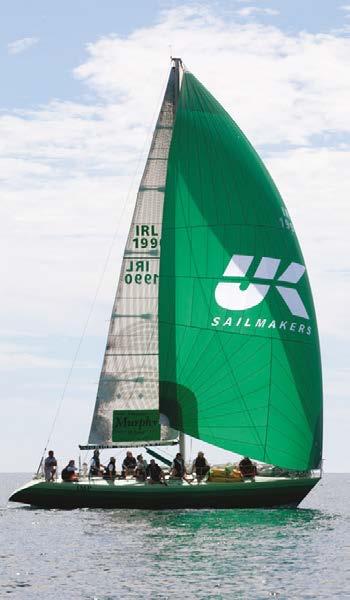
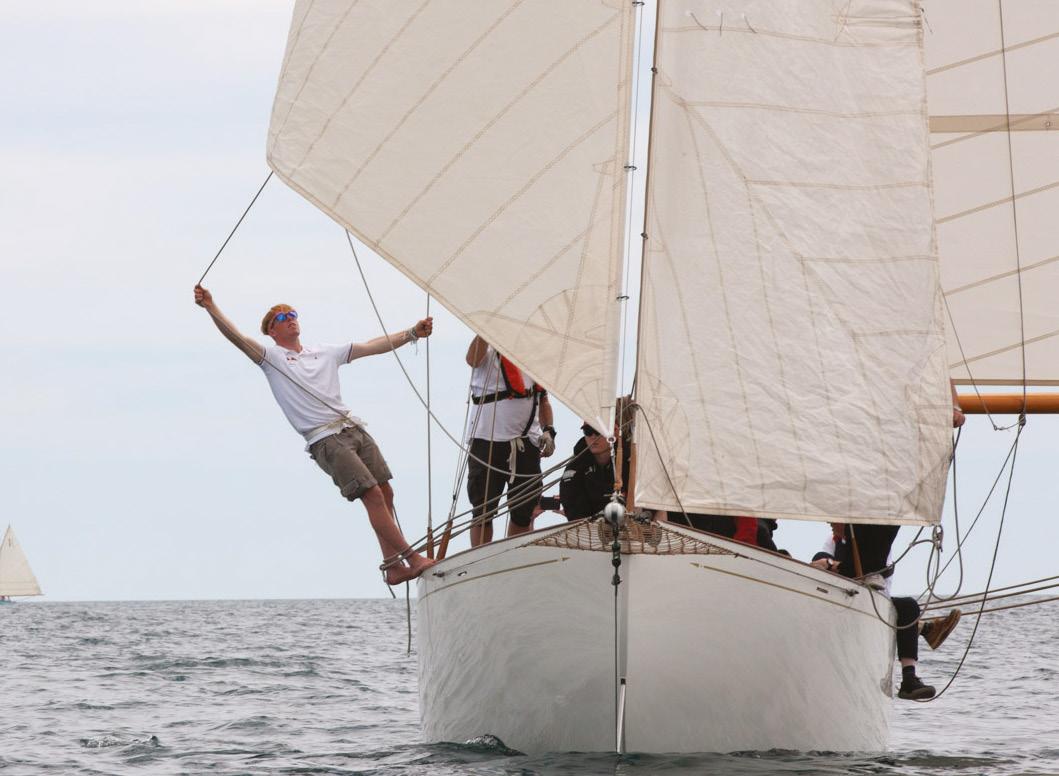
JJ Ollu’s French classic Bilou-Belle, from Atlantic YC, won the Classic Class by just two points from Patrick Dorgan’s Cork Harbour One-Design Elsie. Third was Dafydd Hughes’ Welsh S&S 34 Bendigedig, which also won the Prince of Wales 300th Anniversary Trophy. “The Prince of Wales Trophy is going to Wales!” commented Dafydd Hughes. “If the weather systems allow me, I will be racing Bendigedig around the world in the 2023 Global Solo Challenge.”
Other notable yachts at the regatta included local boat Lady Minn from Schull Harbour Sailing Club owned by Simon O’Keefe and Erin from the Royal Cork Yacht Club owned by Terry Birtles. Although not o cially in the Classic Class, the imperious Ron Holland-designed IMP looked glorious all week.
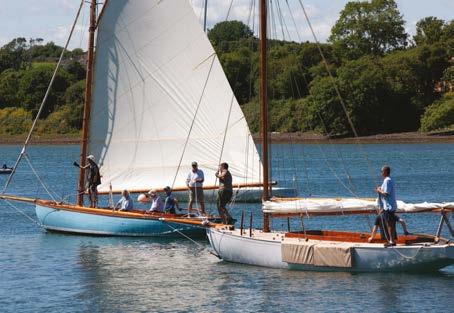
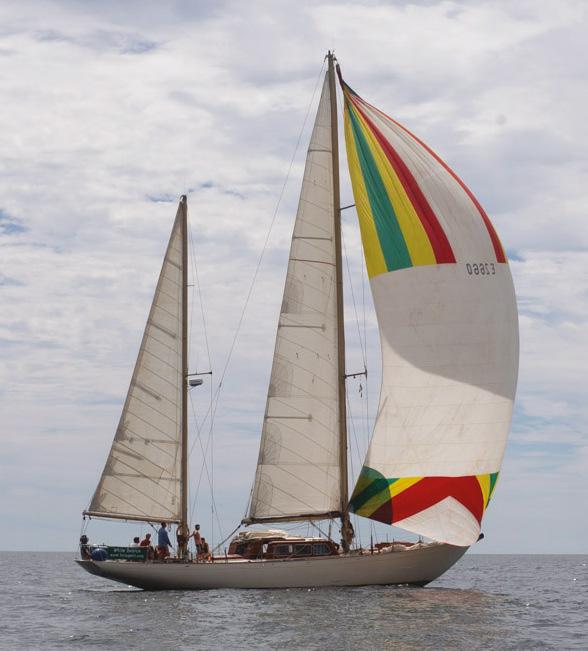


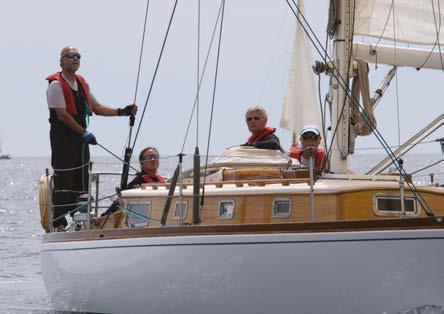
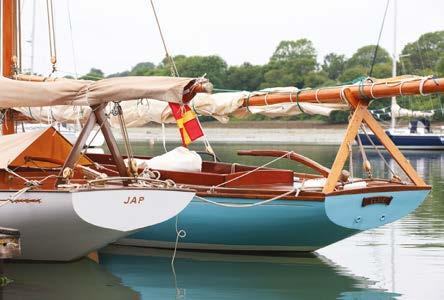
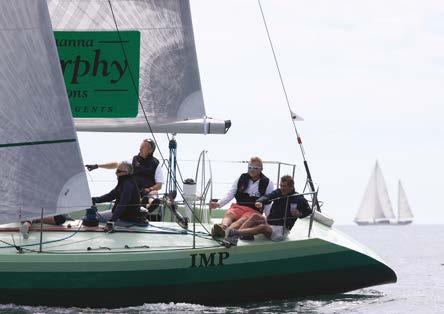
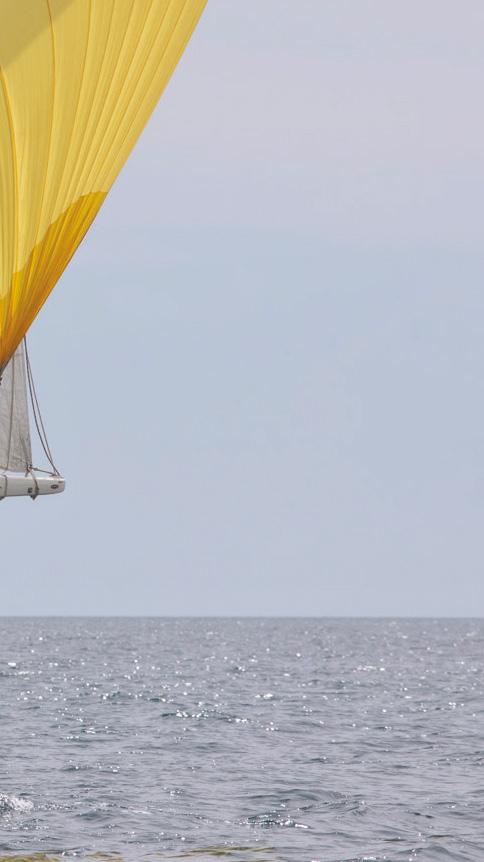

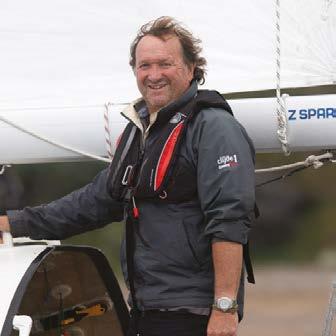

The first Richard Mille Cup will take place in 2023, with racing for classic yachts on both sides of the English Channel.
Entry will be open to “invited owners and charterers of yachts built before 1939 or faithful replicas of such yachts. The minimum size of any yacht eligible to enter will be 10m length at the waterline”.
It will be raced under the CIM handicap system, one of the first times CIM has been used on the English side of the Channel. All yachts entering will have to provide a valid CIM certificate.
There is also a new cup being prepared for the event. The Richard Mille Cup is a perpetual trophy standing a metre high. The winner will be presented with a 40cm high replica also made by Garrard.

The announcement comes after the setting up of a classic boat hub in Brest, France, earlier this year, with impetus coming from the new owner of Moonbeam IV (1920), Richard Mille, the owner of Mariquita (1911), Benoit Couturier, together with the owner of Moonbeam III (1903), who have all moved those boats to the Breton port, with French sailor Jack Caraes as team manager. William Collier, managing
director of GL Watson & Co, who was instrumental in the boats changing hands, is consulting on refit and restoration issues.
Luxury watchmaker Richard Mille sponsored the Fife Regatta earlier this year and this new event was inspired by the port-to-port nature of the Fife Regatta, as well as by the 'Fife at the Squadron' event that followed it, with spectacular racing in the challenging conditions of the Solent.
“The driving motivation is to create a challenging sporting event with competition through a range of inshore and o shore races," organisers said. "It is being created by a classic yacht owner for qualifying yacht owners. It is recognised that the di ering racing formats will provide very di erent challenges for the yachts and the Cup will recognise all-round performance through the whole series."
This inaugural series is being organised with the Royal Yacht Squadron, the Royal Cornwall Yacht Club, Royal Dart Yacht Club and the Société des Régattes du Havre. Entry will be by invitation and expressions of interest are welcome. richardmillecup.com
Falmouth, inshore racing: Royal Cornwall YC reception on Sat 10 June, with three days of inshore racing.
O shore race, Falmouth to Dartmouth, 65nm: depart Wed 14 June, Dartmouth dinner on Thurs 15 June.


O shore race, Dartmouth to Cowes, 90nm: depart Fri 16 June. Break in racing in Cowes. Cowes: Royal Yacht Squadron reception Mon 19 June, then three days' Solent racing, possibly with a race around Isle of Wight.
Cowes to Le Havre, 100nm: Société des Régattes du Havre welcome + prize-giving.

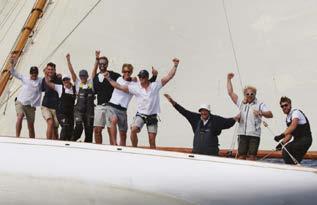
British-flagged Kismet (pictured above) won the 11th edition of the Gstaad Yacht Club's Centenary Trophy, the rendez-vous at Les Voiles de Saint-Tropez for classic yachts aged 100 years or more. Kismet, built in 1898 and famously one of the houseboats pulled from a mud berth on the English east coast, was skippered by owner Richard Matthews. The boat is the first Fife design to have won the race, having entered twice before, each time making the podium. Second was the Herresho Bar Harbor 31, Scud (1903), owned by Patrizio Bertelli, with Torben Grael calling tactics, while third was another Herresho , the NY30 Oriole (1905), sailed by a Spanish crew.
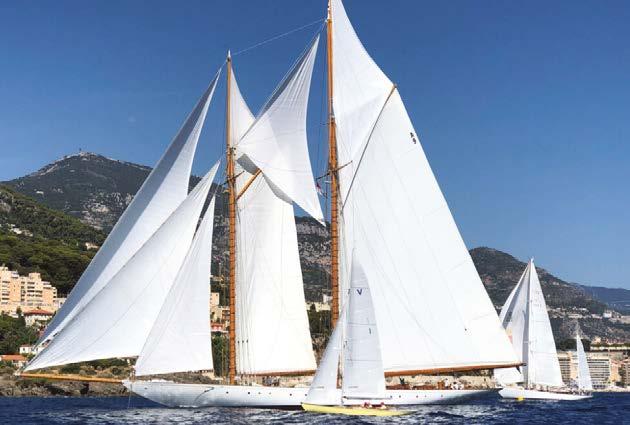

An elated Matthews said: “We are very happy. The boat went perfectly we never had her going so fast windward. The course was perfect and we had enough wind. It was just a perfect sail. We were looking back and kept saying: ‘Where are they?’. We saw Scud coming up fast but we thought we had enough time. The key moment was when we decided to change the small jib to a bigger one. We have got a great crew, very good sailors.”
Kismet is coming up for her 125th birthday next year and Matthews said he would love to return to defend the title.
The Centenary Trophy is raced in a pursuit format, with the
'slowest' boats setting o first. Consequently the finish is often close. However, this year Kismet, after starting seventh out of 22, was ahead of the rest in three minutes and remained so for the 9nm course.
The Gstaad Yacht Club event welcomed some newcomers this year, including: the oldest boat on the water at Saint-Tropez, the pilot cutter Madcap, built in Cardi , Wales, in 1874; a German ketch from 1920 designed by Herbert Wustrau, Wiki; and what is almost certainly the Mediterranean's only regularly competing Solent Sunbeam, Dainty, from 1922 (see below).
The 22 entrants also included the two boats that enjoyed an epic tussle for first last year, the William Gardner-designed P-Class, Olympian, of 1913, and the Herresho , Spartan, of 1912, the last remaining NY50. The biggest participant was the the 177ft (54m) three-masted topsail schooner Shenandoah of Sark launched in 1902. Further centenarians in this remarkable fleet were the P-class, Chips, of 1913, the Fife ketch Sumurun of 1914, the Fife Jap of 1897, the Liljegren design for the 1912 Olympics, Marga, and the Thomas Rabot-design, Lulu, from 1897.
Participants saw a film celebrating the first decade of the Centenary Trophy, comprising images by Juerg Kaufmann, as well as a new film about the race, made by Shirley Robertson and Vertigo films.
A newcomer to the Gstaad Yacht Club’s Centenary Trophy in September was the Solent Sunbeam Dainty, qualifying for the race as she turns 100 this year, along with the class that she spawned – Dainty was the first Sunbeam designed by Alfred Westmacott in 1922. Bosham-based Peter Nicholson has owned Dainty since he was 19, racing and winning in many Cowes Weeks as well as countless other regattas. The boat is maintained at Haines Boatyard in Itchenor, where the classic wooden Sunbeam keelboat fleet is now being bolstered by GRP replicas, 11 so far. Dainty has been trailed to the Mediterranean regattas each summer for the last 17 years, and although she has been refused entry to some events for her 27ft (8.2m) LOA, when entered she has raced against the most famous classics afloat – Anna Boulton's shot here shows her passing Elena of London. At the Gstaad Yacht Club’s Centenary Trophy this year Peter Nicholson was presented with a commemorative book by Bruno Troublé. solentsunbeam.co.uk
JUERGThe wooden boat area at the Southampton International Boat Show in September proved a highlight of the event, with craft displayed by members of the Wooden Boatbuilders Trade Association and others.



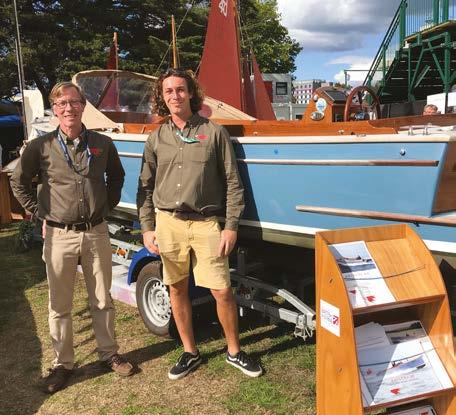


A centrepiece of the area was Jubilee, pictured above centre, one of only 17 Deben Cherubs designed and built by Woodbridge Boatyard on the Deben River in Su olk. She dates from 1935, the year of King George V’s silver jubilee, hence the name, which had added poignancy during the boat show week. Woodbridge Boatyard joined many exhibitors in marking the death of Queen Elizabeth II by flying Jubilee's flag at half mast (right).
Woodbridge is trialling a biocide-free antifoul on this and other boats it looks after, and Jubilee’s topsides are coated with organic linseed oil-based paint, tinted with natural pigment to a custom colour – aiming for an environmentally friendly and a low-maintenance way of coating the boat.
A century ago, a Deben Cherub would have cost £160. Today the yard has other Cherubs and similar dayboats and small cruisers, waiting for the right owner to instigate a revamp.
Another boat built by Woodbridge was being proudly displayed by owner Vicki, pictured below right, who commissioned her to the lines of a clinker dinghy that used to be built by Everson & Son, the famous yard from which Woodbridge grew. Vicki said: “To own a clinker dinghy like this is a childhood dream come true.”
Among other new wooden boats on show was the lug-rigged Mystery 14 (above right), which Nic Compton wrote about in our April issue. The boat is built by Colin Evans of Evans Boatwork in Pembrokeshire, Wales.
Meanwhile the International Boat Building College in Lowestoft and the Boat Building Academy in Lyme Regis were both fielding enquiries
from interested punters. IBTC Lowestoft put on a well-attended demonstration of how to steam-bend a piece of oak.
Boat Building Academy director Will Reed was showing o the first student-built boat at BBA that was also designed by a student (below left), as well as examples of what BBA students have made in the college’s short furniture-making courses.
The award-winning work of Star Yachts in Bristol is a Southampton Boat Show staple. Pictured below centre is yard owner Win Knoops with colleague Olly and the Bristol 6.0, an electric launch that we featured in our March issue.
Over on the marina, Spirit Yachts' all-electric Spirit 44CR and Spirit 30 were on display, easy to spot among the many GRP yachts on the pontoon. The 30ft (9.15m) Spirit 30 is the first Spirit hull to have flax lay-up and bio resin incorporated into its build, the hull constructed from responsibly sourced, FSC-certified sapele ringframes and Douglas fir planking. The boat has a Torqeedo Cruise 4.0 FP electric drive system powered by lithium ion batteries and a Torqeedo 650W battery charger, giving a range of around 16nm at five knots.
Older, and also attracting a steady stream of visitors, was the Nicholson 31, with the class association keen to celebrate 'the original bluewater cruiser', first built in 1976 by Camper & Nicholsons in Gosport.
Meanwhile the masts of the tall ship Morgenster (top left) towered over the show. Visitors could tour and book evening sails on the 157ft (48m) clipper brig, a sail training ship built in 1919.
Making its world premiere was the Dale Classic 37 motorboat, based on the widely respected Arthur Mursell semi-displacement Dale 40 design, this boat fitted with a wealth of modern features.
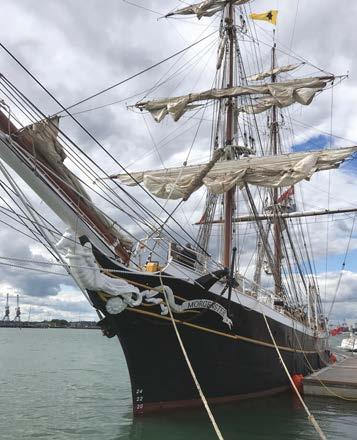
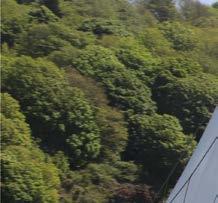



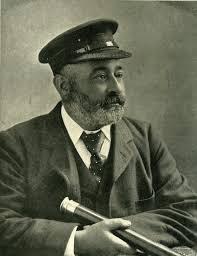

A design by Charles Sibbick from 1899, and launched in April 1900, SAUNTERER has understated beauty and simple pre-WW1 elegance, which hides her immensely strong and original construction, being an extremely seaworthy, fast and very English vintage yacht. A wooden yawl of 47’ on the deck, SAUNTERER has undergone a substantial, well recorded and complete restoration undertaken by people who know and have a deep understanding of this vessel, maintaining the atmosphere of a 1900’s yacht. Now for sale a er several years cruising on the South Coast, she is ready to be enjoyed as a contemporary classic yacht by her next owner. Her previous owners include Captain Oates of Antarctic fame, who owned her when he died in 1912, and for whom she is a living memorial.


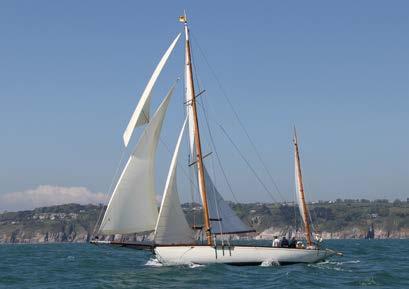
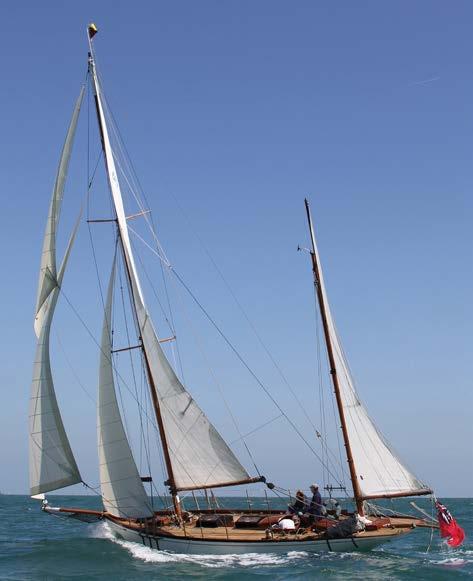
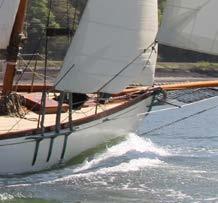
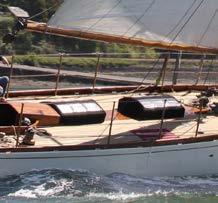

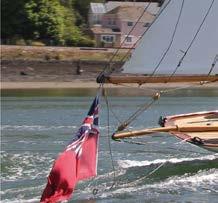




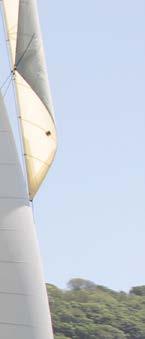

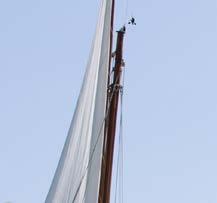
The OGA (Association for Ga Rig Sailing) is planning its 60th birthday party next year, with a series of events around Ipswich and the River Orwell as well as a Round Britain cruise. Hosted by the East Coast OGA, up to 150 boats are expected at the River Orwell events from 2-6 August 2023.
The four days will encompass class racing, cruising in company, shoreside excursions and entertainment for all ages. The celebrations will be held in Ipswich Dock and Su olk Yacht Harbour, both on the Orwell.
The event will include the first Ga ing 4.1 Championships for the Andrew Wolstenholmedesigned OGA dinghy, followed by the East Coast Areas’ Annual Cruise, to which all are welcome.
Coordinator Alison Cable said: “Between them, the River Orwell, Stour and Walton Backwaters provide sheltered sailing in most weathers and for the larger boats there are the open waters of the Harwich approaches. A range of sailing events will be organised to suit the di erent groups of boats and the conditions."
For those without a boat, the OGA is aiming to provide cruises on a local smack or Thames Barge.
The Round Britain Cruise fleet is scheduled to finish at Su olk Yacht Harbour just before the celebrations. Registrations are being taken and skippers are encouraged to o er crew spaces on one or more legs of the trip. Email oga60@oga.org.uk.
The idea was successful for the OGA’s 50th anniversary in 2013, when more than 200 boats took part in at least some of the round Britain challenge.
Alison said: “In 2023 we hope to repeat that success. We already know there will be celebrations in Cowes, Plymouth, Milford Haven and Dublin, as the fleet sails clockwise round the coast. Other gatherings will be decided as the event takes shape, culminating with a final party at Su olk Yacht Harbour on the first weekend of August 2023. We intend to make this final event suitable for all OGA members and boats from yachts to dinghies, and everything between.”
The round Britain fleet will assemble in Ramsgate on 27-29 April, ready to set o towards Cowes, to be there for the early May bank holiday. Then the fleet will head on to Pymouth for 10-12 May. There will be 10 days to get round Land’s End before arriving in Neyland Marina in Milford Haven for a gathering on 20-21 May.
Dublin Bay will be hosting an OGA party the following weekend. The Scottish area OGA will host a party on 17-18 June, probably at Kerrera Marina or Oban.
At this point the fleet will probably split to go through the Caledonian Canal or round the top of Scotland, before rejoining to travel down the English east coast towards the jubilee party on the River Orwell.
The OGA is looking for partners and supporters for the Ipswich and Orwell events. Interested companies can contact Pete Thomas on pete.m.thomas@btinternet.com.
For further information see oga.org.uk
Light winds greeted a varied fleet of wooden boats for the August edition of the Albert Race, held in Rossö, a seaside town south of Strömstad in Sweden, writes Erik Norlander.
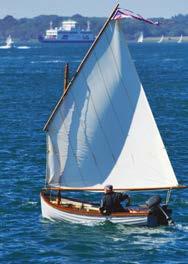
Sixteen boats started in northern Bohuslän’s classic wooden boat meeting, but none of them could threaten the course record of 54 minutes.
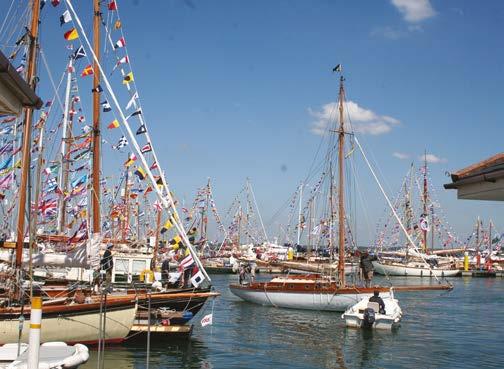
The boats sail to a local handicap, called RYS, which loosely interpreted means Rossö Yard Stick. Regatta organisers set a boat's RYS number arbitrarily, largely basing it on last year’s results.
The start at Killingholmen was taken elegantly by Bengt Jansson who, with his Tango, an Olle Enderlein-drawn Ballerina, had
the pleasure of leading the field out through Rossöhamn. There the wind dropped and so did the boat, allowing more easily powered boats to pass.
Race tactics include choosing the best route at Vadbodskäret – sometimes it pays to lead the fleet through, but if you stall in a wind hole, they will sail around you!
The winner was a former fishing boat, Frifararen, recently restored to working condition by owner Johan Goksöyr, and probably the only boat of its kind left.
Albert Olsson, after whom the Albert Race is named, was a fisherman and chairman of SVC, the Swedish Fishermen's Central Association.
Not many sailing clubs can claim to be 150 years old, but the Sydney Amateur Sailing Club celebrated its 150th birthday with more than 60 boats on display, plus a family fair and regatta, on its home waters of Sydney Harbour. sass.com.au

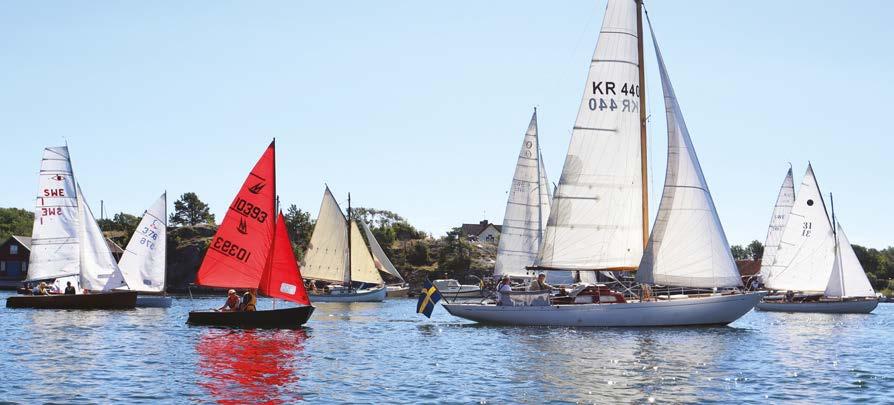
1962. Refit 2022. Designed by the Scottish naval architects G.L. Watson & Co. and built along traditional lines to Lloyds class by Ailsa Shipbuilding, Scotland. She has a top speed of 11 knots and boasts a maximum range of 4,000 NM, thanks to her twin Gardner engines. She has cruised extensively in all latitudes including a circumnavigation. She was also a support vessel for the filming of Luc Besson’s Atlantis. Her interior has been rebuilt using varnished mahogany, in a timeless style, with modern details for comfort.
2010.
After owning, restoring, rebuilding and recreating a number of famous yachts, her owner built her with his vast experience, and has once again constructed a yacht that no-one thought would ever sail again. Her original lines were honoured to the finest detail, and her sail plan is identical to that of her victorious 1905 Transatlantic Race, which immortalised her in yachting history. Above all, she is again breathtakingly beautiful, turning heads wherever the wind takes her.
Her dimensions are simply incredible; 65 m overall, 56 m over deck and 42 m at waterline. Thanks to her spars, which tower some 45 meters above the waterline and support a staggering area of 1,750 m² of sail, she performs at unmatched speeds under sail.

1952. Designed & steel built by Koser & Meyer in Germany. She is a very nice ketch with a special character. She is ideal for long cruising periods while easy to manage, even with just one crew member. She accommodates up to 6 guests in 3 cabins and up to 3 crew members in 2 cabins.
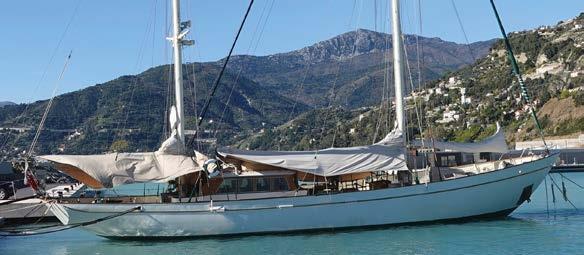
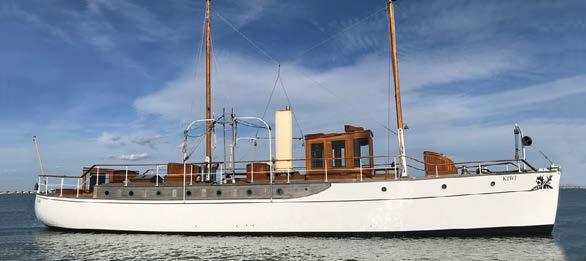
2004 From a Joubert Nivelt Design, LAZY DAYS is a new classic jewel, of which only 5 units sail across the oceans. She is spacious, comfortable and luxurious with a special character. The interior is built around a spacious saloon with beautiful dark woodwork and a galley to starboard. She offers 4 double cabins and two shower rooms, both with electric toilets.

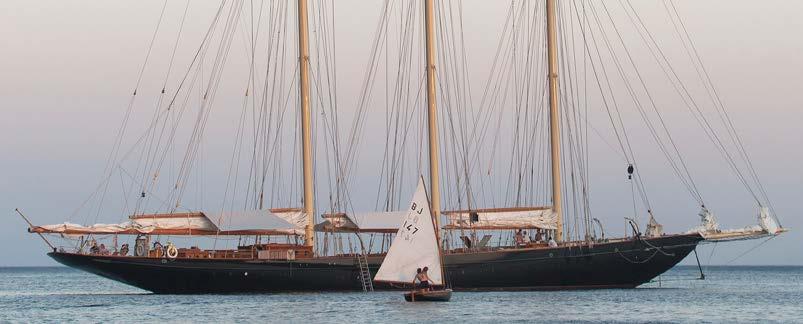


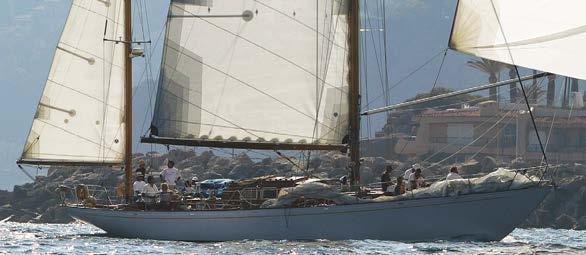
1930. Refit 2017. Built as Falcon by George Lawley & Sons (Boston, USA) and designed by famous naval architect Mike Paine. She is optimised for racing. Since she became JOUR DE FÊTE in 2011, she has campaigned very successfully in the Mediterranean classic circuit, earning a name for herself, due to her immaculate level of maintenance and outstanding beauty on the water, as well as her ability to win.


Thestory of Voluta begins with her first owner
George MacAndrew, a businessman who took his holidays at Seaview on the Isle of Wight and who wanted a boat that could be moored close inshore. MacAndrew was a serial boat owner and astute yachtsman who had already commissioned boats and yachts from several Solent boatbuilders. In his notebook ‘Notes Relating to my Sea Boats and Yachts, 1886-1902,’ he describes his adventures in said craft and his dealings with the boatbuilders, in a charming glimpse back into a distant age, when yacht cruising was still a fledgling sport. A yachtsman could walk into a boatyard through the wood shavings and sawdust, see the craftsmen at work and stop and talk through his conception for a new yacht build with the boatbuilder and/or designer, who would then add his expertise to those ideas to create a unique new yacht.
In 1886, MacAndrew commissioned a 15ft (4.6m) open centreboard boat from Picket of Southampton, before taking on and finishing to his requirements Snowbird, a 35-footer (10.7m) in 1890. That same year, he commissioned Lukes of Hamble to build a 17ft (5.2m) “scientifically designed miniature yacht” –Cyproea. He was very taken with Cyproea’s sea keeping and speed, and it led to the conception of Voluta. In 1893, with his family of an age to take more involvement
with his yachting, he commissioned Ianthina, a 34ft (10.4m) yacht, choosing Stow and Sons of Shoreham over Paynes of Southampton to build her, the quotes given being £300 versus £450 respectively, leading him to conclude that “one has to pay for contracting a fashionable firm!”
He had no regret in choosing Stows, as he was highly impressed with their quality, and even more so with the boat’s punctual delivery – compared to the “vexatious slackness” of other boatbuilders! In 1898 he commissioned a Redwing from Camper and Nicholsons, and in 1899, he contracted Stows again to build him Voluta.

“I had often thought when sailing the Cyproea, what a fine cruising yacht would result from multiplying each dimension of her by two; this was my guide in deciding dimensions, but the waterline length was increased 4ft 6in (1.4m) beyond twice the Cyproea and, above water, the length was further extended by a long counter – on the whole, the model and characteristics seemed very similar to the smaller boat with all her excellent qualities.”
By early June 1900, Voluta was first under canvas in Shoreham Harbour, before leaving on 9 June for her summer base at Seaview on the Isle of Wight.
“Though the Voluta was of rather light draft and fitted with a centreplate, she was very far removed from
the ‘skimming dish’ type of boat usually associated with this contrivance and which is neither suitable nor safe for open sea work. On the contrary she was an excellent hard weather yacht, of great initial stability, and a constantly increasing righting power as she heeled to the pressure of the wind, having sufficient draft of water and ballast to make her a powerful sea boat; indeed she never showed to better advantage compared with other yachts we met sailing, than when beating against a strong wind and hammering into a sea. Of course, when on the wind, the grip of the centreplate was a great aid, but it was not an absolute necessity, as she beat to windward very fairly without its use, and we often did not lower it for short spells of this point of sailing. Indeed during our first season we sailed the ship constantly for about six weeks without the use of the plate, having by mismanagement had to spend two or three hours at low water upon a gravel bank, when the slot became jammed with small stones, and the plate could not be lowered.” The MacAndrews used Voluta for three seasons in all, laying her up at Lukes yard after the 1902 season and offering her for sale.

“My contract price with Messr Stow for building this vessel in 1900 had been £900, and I spent some £40 more on her full inventory. I sold her, after being laid up for over a year in the beginning of 1904, for £480, times then being rather unfavourable for selling.”




Clockwise from top left: Captain Sharpe seated and Dr TC Jackson in suit at Bridlington; Capt JF Sharpe –picture from RYYC centenary handbook, 1947, (although photo would have been pre-war); Commodore’s flagship at the Bridlington Regatta (note bunches of flowers at bowsprit end and mizzen boom)
The remarkable survival of MacAndrew’s notebook paints Voluta’s early years in beautiful vivid colour, fleshing out hazy details and bringing to life the Solent sailing community at the turn of the last century. In the days when yacht sailing was still a new sport, and great diligence had to be applied to every part of the craft sailors ventured forth in, MacAndrew had conceived and had a yacht built, which through her peculiar and unique qualities, would still be sailing 120 years on.
Voluta was bought by a yachtsman who was to go on to be one of the leading figures of Yorkshire yachting over the next 40 years. Dr TC Jackson, Royal Yorkshire YC member, along with his skipper of over 20 years, JF ‘Pez’ Sharpe, would race Voluta consistently until World War Two, making her probably the best known yacht in the area – I have found more than 200 articles mentioning her in the local press from this era – and after his rise to commodore of the club in 1922, Voluta was the RYYC’s flagship. After the RYYC’s move to Bridlington in 1901, its prestige grew. Large yachts like L’Esperance, Rosalind, Cariad and Adelaide sailed the waters of Bridlington Bay competing for valuable trophies, and spectators would line the quays for Regatta Week. Voluta competed every year, winning many prizes, and presiding over the annual
Regatta Review, when the fleet would sail by the town dressed overall in what sounds like quite a spectacle. Dr Jackson was a great yachtsman, commodore of the RYYC for over 20 years, a leading member of the Humber Yawl Club, member of the Yacht Racing Association and, it seems, a passionate supporter of all things sailing and all things Yorkshire! Skipper Sharpe was a respected skipper, having crewed in the Shamrock II America’s Cup challenge, and he kept Voluta in top order.
Here is an excerpt from a letter by the late Commander Robert Blythe OBE, formerly of the RYYC. “I met Capt John Frederick Sharpe a few times when he was skipper of Voluta. He was known locally as Pez Sharpe (but not by me), lived on board Voluta with a youth as paid deck hand during the summer and sailed Voluta back to the Crouch where she was laid up by him and fitted out in the spring and sailed back to Bridlington. At that time, the 1920s, practically all the yachts at Bridlington had paid skippers or paid hands even the one designs. Voluta was then the largest yacht in the harbour and was kept in immaculate condition although, apart from Regatta Week, she did not often go to sea. You might say she set the standard of what a gentleman’s yacht should be.”
As the years passed towards World War One, the number of large yachts making the annual trip up to Bridlington for the regatta dwindled, and as yachting restarted after the war they had stopped coming altogether.
After losing her rig in a fire while laid up ashore in World War Two, it seems Voluta was re-rigged as a bermudan yawl, as attested to by photos taken in the 1950s under George Miller’s ownership. She shows up in the race results a few times after the war at the RYYC, but then is mentioned in an intriguing newspaper article describing her imminent trip from Goole to North Wales! She was then bought by Sir Hugh Bell and I M Pease in 1959, and in 1964 she drops off the Lloyds register. The trail goes cold now for 10 years or so when it comes back with various accounts of her being in the Falmouth and Helford area under the ownership of Frank Lang, a local character who owned and kept Voluta going, in what seems an ageing state of repair during the 1970s and 80s. She appeared in the BBC documentary ‘Under Sail - A Lady of Leisure’ in 1986, by which time she was working out of Newton Ferrers as a charter boat. The trail goes cold again then for a while.
I found her on the hard in Rhodes, Greece, where she’d been baking under the hot sun for five years and was in a poor state. I made a low offer reflecting her condition, which was refused. I thought no more of it until two years later when the yard manager Giles got in touch to say she was going to be on eBay that month. I bit the bullet and flew out for a look. She was a strange sight, with an ugly doghouse, massive gaps and splits in the planking, a failing keel repair and filthy inside. Despite all that you could see that this was an old lady of great character who had lived a life and was still holding her head up, although the end could have been perilously near. Little did I know when clicking ‘bid now’ how much influence this boat would have on my life, but also what a story, which has come slowly to me in bits and bobs, this lady of leisure had to tell.
Facing page, clockwise from top left: Carrick Roads; Original Reids of Paisley capstan windlass; Florence towing the boys; A fine bow wave; Lots of varnish
My own 17 years of ownership have involved more rebuilding than sailing! The initial delivery trip from Rhodes to La Ciotat, where I was to start the renovation, was when I properly fell for her. I got a crew together including my brother Graham and best mate Kevin Burns to refit, launch, and sail her the 1,200 miles to France.
Overleaf, page 28, clockwise from top left: Fastening planks in La Ciotat; Finishing the counter in Gweek; Voluta doing what she does best; Fair topsides and a great paintjob in Gweek
Through three full gales in a windy November Mediterranean, she performed superbly: seakindly, fast, biddable, and like all my favourite boats, one who looks after you rather than vice versa. In more moderate winds she kept up good speeds with a very kindly motion. As MacAndrew said back in 1900, she is a boat of great initial stability, slow to spill the G&T!
In La Ciotat, over three years, I embarked upon the first large refit I did. In 2007 I moved back to Cornwall, so launched Voluta in a part-finished state, and she came home up the Rhone, through Paris and into the Channel at Honfleur. The French canals are beautiful and make a wonderful trip, this certainly highlights the advantages of a shallow draught vessel – you would be pushed to get another 50ft (15.25m) classic to the Med by this route.
In 2009 I had my second big push at restoring her and was lucky be helped by Nathan Puttock, a fantastic shipwright who really boosted the project. My old ship mate Andy Mongan, along with Matt and Chris, also helped out doing an incredible job of fairing and painting the topsides: a shinier boat never came out of Gweek.
During these years, the family lived aboard and we sailed in severall Falmouth Classics, winning our class twice, although it was while racing in a good breeze one year that I contrived, by mismanagement, to snap the bowsprit and topmast. Although catastrophic at the time – I had not the time nor finances to rectify this damage, so we didn’t do much sailing for a while – it turned out for the best, as the topmast rig, which I had put on her believing it to be close to the original, turned out to be completely wrong. When I bought her I received two historical photos, one showing her in Shoreham sporting a topmast. I copied this rig to be close to the original, but as my research advanced and I unearthed more and more historical photos of her pole-masted, it became clear I had made an error. To correct it, Ashley Butler built a mast to dimensions similar to the original, and Jay Redman-Stainer worked his magic splicing up the traditional standing rigging.
Anyone who knows wooden boats will agree it does not take long for problems to arise if you take your eye off the ball. During the period I was busy sailing another gaff yawl home from Canada (Anne Marie, CB passim), Voluta’s 30-year-old plywood subdeck rotted, another blow to time and funds; but in November 2019 I hauled her out in Flushing and started the third, and last, big stage in her renovation. I redecked reusing the old teak, so once again she is looking pretty, structurally sound, and in a state I hope MacAndrew and Jackson would approve of!
In my journey with Voluta, I have been constantly amazed by the wealth of her history, of which there is doubtless more to learn, and the physical survival of this boat that was built with the best materials available at the time, by wonderfully skilled craftsmen, to a unique design, one that has proved so very successful for so very long.





Removed rusted solid steel centreplate and steel centreboard box which was leaking badly
Fixed the keel issue, at the same time closing the centreboard slot in a way that it is a simple procedure to open again and restore the centreboard, if so desired Replaced the stern post Replaced the stern knee

Did large hook scarf repair to the stem Replaced the rudder Started rebuilding the counter Repaired the horn timbers Removed doghouse, lowering it to original height, tied it in with the rest of the coachroof by laminating 18mm ply on top of the existing tongue and groove pine Removed the engine and replaced it under a new part of raised deck at the front of the cockpit with a V drive box, improving interior space
Removed, cleaned up and replaced all the original wrought Iron floors, replacing a couple where it was necessary, and refastened with bronze bolts Replaced one dozen or more frames
Replaced the garboards, stealers and half a dozen more planks, (iroko) Refastened the boat entirely under the water with silicone bronze screws Refastened the boat where necessary above the water with silicone bronze screws Replaced all centreline bolts with new bronze bolts Removed and restored the original Reid and Sons capstan windlass New forehatch matching historical photograph
Replaced one dozen or so frames
Rebuilt counter stern

Fitted new bulwark stanchions, bulwarks and cap rail Installed rudder trunk tube
Fitted coaming cladding and deck margins
Built new topmast rig
Built new boom
Built new bumkin
Renovated existing spars

Took boat back to wood and repainted – traditional paint below waterline and Awlgrip above
Re-formed scarf at front end of lead keel by cutting and recasting Replaced approximately 50 per cent of bilge stringer each side and refastened with copper bar riveted and silicone bronze screws
Refaired and repainted coachroof top with non-skid Awlgrip
Fitted samson posts
Fitted new stem ironwork incorporating lifting bowsprit system with twin forestays New ironwork for masts and booms (MINOR) FLUSHING REFIT 2016
Replaced oak mast step
Replaced 1in bronze keel bolts
Refaired and replaced forward deadwood
Repaired forward knee
Fitted new mast built by Ashley Butler, standing rigging by Traditional Rigging of Bristol

Removed plywood subdeck and replaced with 2 x 9mm Robbins marine plywood epoxied together and glued and screwed to deckbeams
Re machined and replaced 17mm thick teak deck epoxied and screwed to ply subdeck, caulked with TDS to full depth of planks. Screws plugged to give minimum 10mm wear
New aft king plank
New bronze rudderstock bearing New tiller
New cockpit ply and teak
Fitted 4 Gibb 9CR sheet winches
Repainted Awlgrip topsides
Revarnished everything at least 10 coats Le Tonkinois and Epifanes
Repainted and decorated interior
Rewired and serviced engine
New water pump for engine
Fitted new 200 Ah batteries x 2 and new wiring for DC panel
Fitted new 12v submersible bilge pump
Fitted Taylors para n 30 cooker
Fitted restored antique tip up sink in head New Jabsco head and pipework
Fitted diesel heater – Eberspacher ducting, copper exhaust
New mainsail made by Katie Allan and Simon Palmer
New hatch and sail covers by Katie Allan New fuel tank
New flexible water tank New mizen ga
Many new elm blocks with bronze bindings
Nearly all new running rigging
New interior upholstery by Katie Allan
37’ Percy Crossley Bermudan Sloop built by the Ponsharden Shipyard, Falmouth in 1934. Pitch pine on oak hull with a Kauri pine laid deck. Major refit in 2018 including all new keel bolts and strap floors plus a new interior, rigging and sails. Superbly elegant yacht in good structural shape, full of pedigree and charm.
Hants £49,500
39’ Looe Lugger built in 1907, now dandy rigged with gaff main and lug mizzen. Detailed maintenance records since 2016, a well cared for and up together yacht. Recent sails and rigging, new keel bolts and recent hull repairs. The last of the sailing fishing boats from Looe, a yacht with a long and rich history.
Devon £75,000
62’ motor yacht designed by Archibald MacMillan and built by the Fairlie Yacht Slip Ltd in 1968. An elegant yacht built for a wealthy Scottish couple. Mahogany hull with solid teak decks. Aluminium superstructure. 4 sleeping cabins with 10 berths and 7’ headroom. Twin Gardner 6LX diesels with new 2021 generator. An excellent yacht with plenty of pedigree and class.
25’ Itchen Ferry design built by Berthons as a yacht in 1926. Pitch pine hull with all bronze and copper fastenings. Major rebuild in 1990’s, very nicely maintained since. Vetus 16hp diesel installed 2009. Very smart boat with varnished teak interior and 2 single berths plus heads and galley.
Hants £19,750
25’ Laurent Giles Vertue built by Elkins of Christchurch in 1954. Teak and mahogany planking with lead keel and bronze keel bolts. Yacht laid teak deck and varnished teak coamings. Nanni 21hp diesel new in 2015. New rigging in 2014 with a full sail wardrobe. Very nice quality yacht with recent survey and detailed history.







35’ Sole Bay motor sailer ketch designed by Francis Jones and built by Porter and Haylett in 1968. 2021 refit by Harbour Marine Services. BMC Commodore 66hp diesel. 5 berths with 6’3” headroom and 2 heads with a shower. Comfortable saloon and very nice wheelhouse for sailing in wet weather. Ideal cruising boat for UK sailing.
Suffolk £32,000
36’ Kim Holman Bermudan Sloop built by Kimber and Blake in 1961. Successful offshore racing boat in her day with numerous Fastnet finishes and survivor of the infamous 1964 Santander Race. Fallen on hard times in recent years she now needs a full refit but he delightful lines and sailing provenance mean she is a yacht well worthy of the effort. Cornwall £10,000
16’ Paul Gartside rowing skiff built by Adrian Morgan in 2019. Used only a handful of times, she comes with 2 pairs of oars, as new road trailer and a fitted all over cover. Planked in Vendia, a processed timber board, she weighs only 60kg in total. A delight to row and in superb condition.
Suffolk £6,500





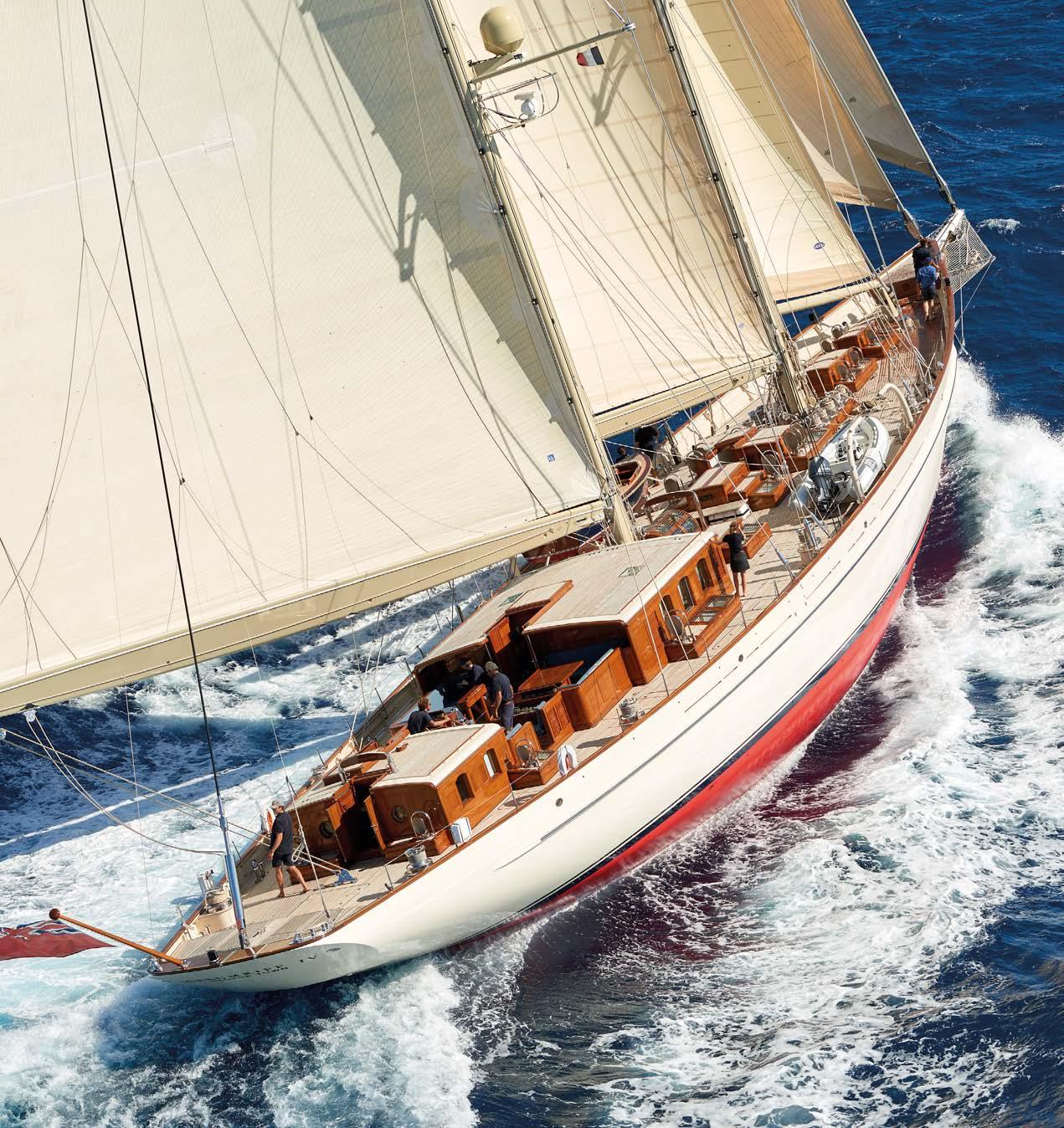
As the glassfibre revolution gathered momentum companies like Chris Craft and Riva entered a transitional period, still producing vessels in mahogany but making them look like glassfibre so as not to appear behind the times.
The 40mph 1966 Riva Junior, billed as “the young people’s rocket,” was on that very cusp. Though its white-painted hull mimicked polyester, the entry-level 18ft 6in (5.7m) sports boat was the last all-new Riva model


to be built of mahogany in the traditional way. And while the immortal Aquarama endured into the 1990s, when Carlo Riva sold out in 1969 all new models introduced by US owner Whittaker were of glassfibre, including the 1972 Riva Rudy, which was basically a revamped Junior.

Pretty much the only mahogany element of the Rudy was the grab rail. But it also lacked something else: glamour. Brigitte Bardot and actor Peter Sellers were among
More than 150 years of British yachting history –much of it with royal associations – is coming on to the market on 1 November as Portsmouth’s combined Royal Naval Club and the Royal Albert Yacht Club closes its doors for good.

Approximately 100 lots, o ered on behalf of the administrators, trace a path through the pantheon of yachting from 1864, including: silver trophies named in memory of Charles Nicholson; mementos from GL Watson’s 1892 Britannia, which was so beloved by King George V that on his death in 1936 the famed racing cutter was stripped and sacrificed to the sea o the Isle of Wight; photographs, books and historical archive material.

For collectors and historians it’s a rare opportunity. For those lacking in history it’s an opportunity to line a library or den with all the ephemera you need to suggest that your family has pedigree and once achieved something.
A circa 1800 naval tin and horn lantern might command a low four-figure sum on a good day, but when its provenance confirms that it was on the gun decks as Nelson fought and died at Trafalgar, that considerably ups the ante.
Not only is the lantern accompanied by a letter confirming it was on board HMS Victory in

the run-up to Trafalgar and was later presented to Admiral Sir Roger Keyes in 1929, this exact form of lantern is depicted in a celebrated early 19th century painting by Arthur William Devis, who was given access to the exact location where Nelson was treated. The result at auction was £47,880.
the jet-set Junior owners, but you’ll find no such A-list roll-call for the Rudy.
This 2014-restored 1967 Junior, fitted with 5.7-litre Riva Crusader 190hp V8, recently sold for £41,400; that’s considerably more than a comparable plastic Rudy would fetch. And here’s another pleasing irony. The hand-built Junior notched up 626 sales from 1966 to 1972, while the “mass-produced” Rudy found only 364 customers over its 14-year life. Wood, it seems, won the day.
Perfect provenance: (above) A racing flag from George V’s Britannia comes with a letter from Buckingham Palace stating “I am commanded by The King and Queen Mary to send you these flags” Top left: a Beken of Cowes photograph of Charles Nicholson at the helm of CandidaBottom left: a circa 1910 yachtsman’s pocket dispute set adds a touch of decorum in di erences of opinion about who rammed whom

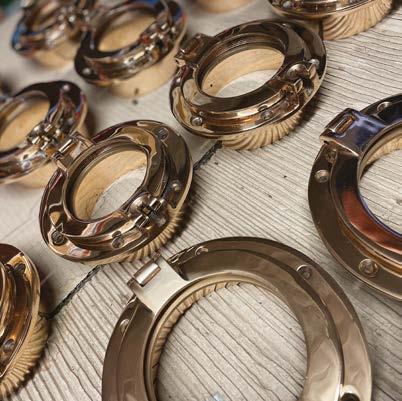
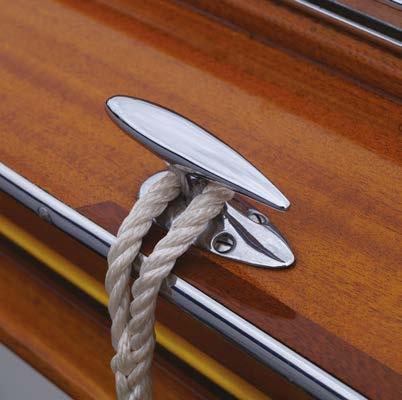

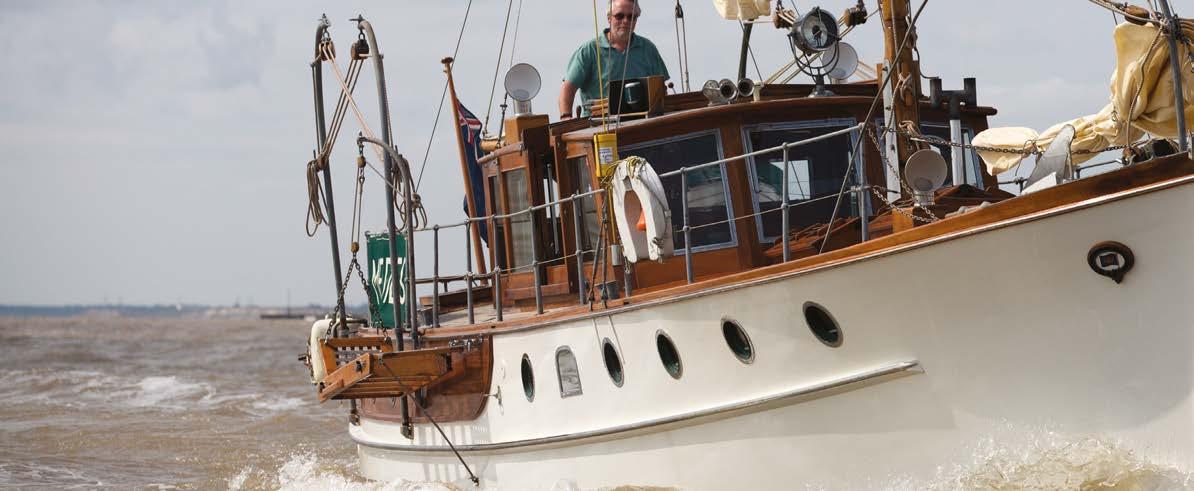




“The world belongs to those who enjoy it,” says the Robbe & Berking brochure and we’re sure we wouldn’t disagree, especially after knocking back a shot from these fine silver receptacles, which you can find in the German silversmith’s Dante Bar Collection.
“The high thermal conductivity of the silver allows every drinking vessel to immediately assume the temperature of the beverage,” they say. Reason enough to pour another. €248 (around £212) for the 90g silverplated model; €357 (around £305) to have it gold-plated inside

Built to go anywhere, they say. Fully waterproof, best in class optics and coming with a lifetime warranty. US binocular manufacturer Nocs make some bold claims. They also make the point that these compact binoculars are undeniably stylish. Nocs say: “We began our search for the perfect travel binocular: great optics in a compact, rugged housing, at a price that didn’t break the bank. They didn’t exist, so we built them.”
models available, from $95 (around £80)
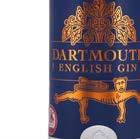

We’ve had a number of requests as to where sailors can find this fine gin, which has been spotted at various English south coast regattas this summer including British Classic Week and the U a Fox 50 event. Both events, indeed, have been supported by Dartmouth Gin, with finishers at a very hot British Classic Week rewarded by a fresh bottle as they crossed the line – the bottle presented by the distiller himself, Lance Whitehead, shown here. Lance is a lifetime sailor and the owner of the Cockwells pilot cutter, Merlin. His Dartmouth Gin was named Craft Gin of the Year 2020 and is distilled in Dartmouth, Devon, “very slowly” to produce a remarkably smooth, full-flavoured spirit. It comes in a handsome bottle, carved to depict a replica of the wrought-ironwork on St Saviour’s Church door in Dartmouth. Also available to US and other non-UK readers.



This chunky ocean blue chronograph from Hugo Boss is made with sailors in mind, water-resistant, and complete with a rugged fabric strap and solar-powered movement.



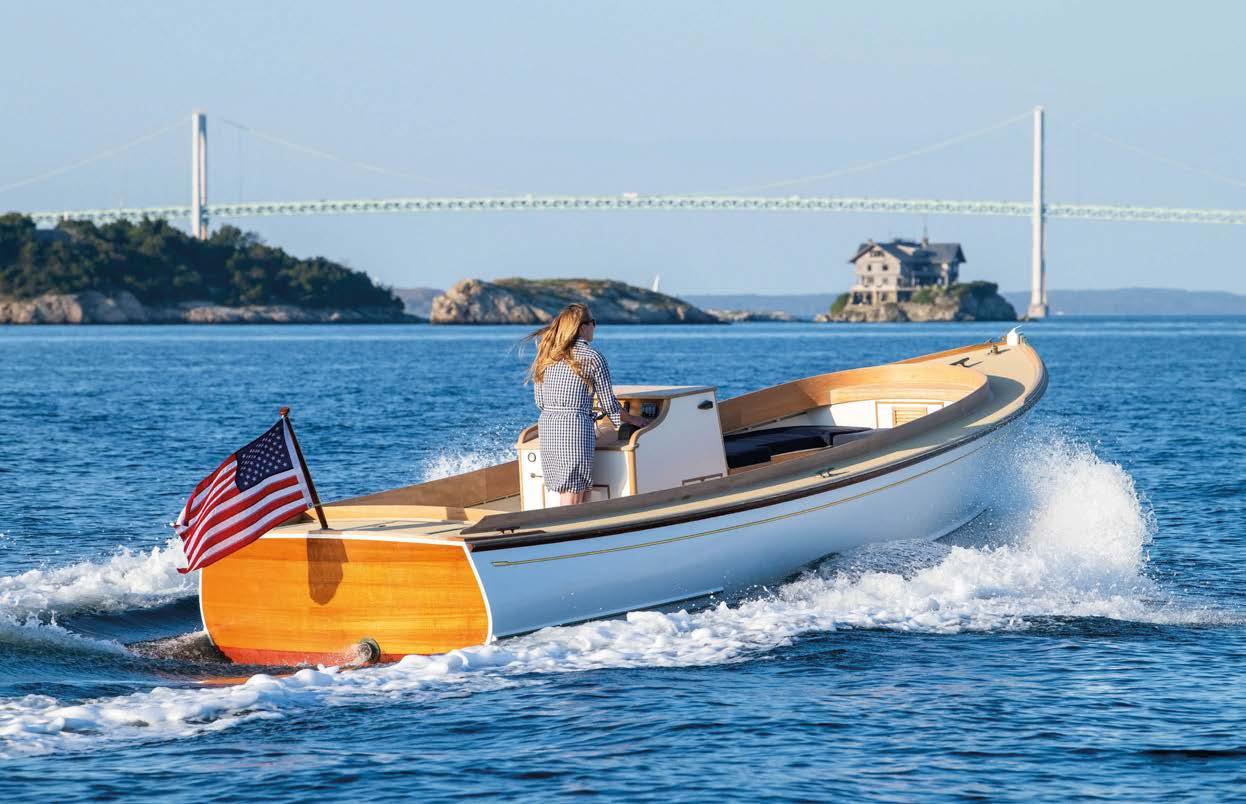





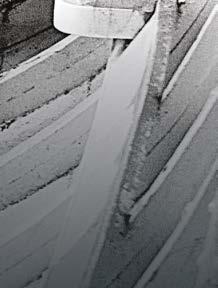





Building rare and near-extinct traditional wooden working boats may seem a niche and isolated occupation but when Gail McGarva takes on a new project, she likes to get everyone involved.

Rowing crews are involved in the riveting and oiling of their Cornish pilot gigs; workers from the sawmill join the launch of her replica Shetland boat; and the elderly men who once went to sea in the original lerret boats she replicated, share their memories as oral histories.
“I have a very strong philosophy that if you involve people in the building process, they will have a connection with the boat and then they will ultimately become custodians of it,” she says.
These days Gail also shares the skills, history and stories of regional working boats by touring museums and heritage centres with her programme called Disappearing Lines. Participants learn the key processes of boatbuilding and are taught how to steam-bend oak ribs, creating what Gail calls ‘ghost ships’.
“They’re a symbol of the craft that is disappearing,” she says. “I hope to raise awareness and help prevent boats from being lost, reigniting people’s passion for their local maritime history, and for the sea.”
Gail’s own passion for traditional clinker craft was sparked at the outset of a nine-month course at the Lyme Regis Boatbuilding Academy in 2004. She’d had no formal experience of woodwork and was changing direction after careers in theatre and education, and as a sign language interpreter. Having lived on boats for many years, she felt now was the time for them to be her focus. Gail was 39 when she gained a City and Guilds bursary to do the course and “knew immediately as soon as I walked in the door that this is what I wanted to do,” she says.
Her initial project was to create a replica of a Shetland fishing boat she’d read about in an article in this magazine –Classic Boat. The Gardie dated back to 1882 and was housed in the Boat Haven Museum in Unst. Willie Mouat had been responsible for its conservation so Gail asked him to be her guide for the build.
Having completed the boat, she made the enormous journey back to Unst with the boat (a 14-hour ferry from Aberdeen) to launch it among the community from where it originated. It was an emotional moment and confirmed for Gail that she wanted to specialise in creating replicas of boats in danger of extinction.
“Working boats are rarely given a status or profile,” she says. “They’re not so well documented as other boats, with no designer drawings or construction plans. The skills to build them would have been passed down from generation to generation.”
In order to preserve these craft, Gail takes the lines of an existing endangered ‘mother’ boat and replicates it, calling it a ‘daughter’ boat. She speaks of them with fondness and
reverence, as if they are living, breathing entities each with their own particular characters.
“Working boats have a strong sense of the weaving of form and function and, alongside the oral history attached to a craft,” she says, “you can look at the shape of the boat and it tells you its past, its job, its shoreline, the way it’s launched. Every working boat has a different story to tell in the shape of its hull.”
Although Gail is commissioned to build boats by individuals, groups or heritage organisations, she hopes that they aren’t static museum pieces. Her goal is for them to find a place in the modern context. The revival of the building of Cornish pilot gigs shows how this can be possible.
“I was very fortunate that when I completed my training there was an explosion of interest in Cornish pilot gigs and clubs were commissioning new boats,” she says.
These 32ft (9.8m) clinker craft were formerly used to guide ships into harbour, but are now popular as racing boats, rowed by six oarsmen and a cox. Around 160 vessels line up at the Scilly Championships.
As Gail’s passion for her subject grew, she learned more about the history of boatbuilding and the different types of working boats, and started to give talks on the subject.
“I’ve been invited everywhere from the WI to the V&A,” she says. “People realised I wanted to communicate the stories, sharing the narrative of the boats and where they sit in our cultural heritage, as well as showing how they have been created.”
She constructed a ‘story boat’ to host events for children, transforming Vera, a 100-year-old lerret she had been given, into a mobile maritime museum – upturned and mounted on wheels – to travel around schools.
“It was common in island communities, when a boat is no longer seaworthy, to use it as something constructive on land,” Gail says. “On Unst, I came across an upturned boat used as a sheep shelter. I’d crawled inside and the structural ribcage of the boat as the roof was enchanting.”
Her passion and commitment are infectious, and Gail has been recognised with several awards including the British Empire Medal for her services to clinker boatbuilding and heritage crafts. She’s a trustee of the Boatbuilding Academy and is also working with the Heritage Craft Association to heighten awareness and gain support for traditional boatbuilding.
“It’s not only the vessels that are teetering on the edge,” she says, “it’s the skill base that’s available to do it.”
It all seems very different from Gail’s earlier life and career but she believes her skills and experiences all come together in this new role.
In her concluding note, Gail says: “Working with communities, focusing on heritage, writing songs and stories, I feel there’s an integration of all the past threads interwoven in the work that I do as a boatbuilder.”
“Working boats are rarely given a status or profile”
Gail McGarva
When a boat stays in the water all winter, there are two choices for preparing her engine for long periods of rest. The obvious solution is to make a pact with oneself to visit the vessel at least once a fortnight and run the motor under load for an hour or so every time. Running it in neutral gear is bad news because it will take ages to warm up and diesels love to work. Too much of this will cause deterioration to the cylinder bores among other things so, if she’s alongside, make sure the stern line and the head spring are well set up, then select ahead and give it half revs. The engine will enjoy its outing and the batteries will love a good old jolt from the alternator.
The downside of this policy is that it’s easy to put off until the spring doing the basic engine service we all can manage. After a diesel has run for a season, or 100 hours, or whatever you’ve decided is to be the oil-change interval, the oil absorbs undesirable extras that worry away at the metal parts inside the engine. Changing the oil and filter removes the lion’s share of these. If you’re content to leave them doing their nasty work all winter long, that’s up to you, but an oil change at lay-up time is by far the better solution. Since you are going to that trouble, why not change the fuel filters at the same time, and do what needs to be done with the gearbox oil too. Even if you plan on the fortnightly run to keep things working, fresh oil will be a bonus. The guarantee of clean fuel will be another, and there’s also the psychological advantage that you’ve done the jobs already when fit-out time comes around.
Whether the boat is stored ashore or afloat, if she’s outside, or even inside, in an unheated shed, the fuel in the tanks will be subject to big temperature and humidity changes. Any air above the fuel will carry moisture in it, replenished via the tank breathers. An abrupt fall in temperature condenses this and that’s a few more drops of the dreaded water in your diesel. Pressing the tanks up full at lay-up time is the best way around this. The less air in the top of the tank, the less water in the diesel next year and, of course, you’ve taken the hit in the wallet six months ago when you’re having to stump up for antifouling, a new sail and all the rest of the new-season commitments.
Whether a boat is going ashore for the winter, or staying afloat but will be left alone for months, there’s one more job that will save you a lot of money in the end. Corrosion in the heat exchanger, exhaust elbow and piping in general are going on quietly all winter long if they are left full of salt water. Here’s what to do.
The engine’s internal system is already full of coolant with the required concentration of antifreeze – or it should be. It’s the raw water system we’re interested in. First, buy a gallon or so of
eco-antifreeze. Mix 50/50 with fresh water in a watering can with no rose on the spout. Warm up the engine. Diesels don’t like being left after running for only a couple of minutes. Now, stop the engine and close the inlet seacock. Open the top of the water strainer and stand by with the watering can. Start the engine and watch the level in the strainer. As soon as it drops, top it up with the antifreeze and go on until you’ve none left. Shut the engine down immediately and replace the lid on the strainer. Leave the seacock closed. All the parts that count are now protected against frost, but equally importantly, the anti-corrosion and lubricating qualities are beyond price. Come spring, open the seacocks and start up. The eco antifreeze will do no harm as it’s ejected, and away you go.
When is a halyard not a halyard?
Answer: When it’s a gantline.
The last rope left aloft when stripping a rig is always called a gantline. It’s best if this has its turning sheave as high as possible so that anyone in a bosun’s chair bringing the halyard blocks down for the winter can reach them all without stretching. A gaffer’s topsail halyard is favourite for this because it is set in a sheave on a pin through the mast and has no block of its own that would otherwise have to be left aloft. On a bermudan mast it will be the main halyard or a topping lift.
Blocks left aloft in the weather all winter long suffer horribly. By spring, they are always the worse for wear, with cracks appearing in the wooden joints as well as having their varnish wrecked by the wind, rain and snow. It’s so much better to bring them home. Then you can service them in comfort instead of slumping on the sofa to study the latest grim tidings from Albert Square.
If muscle for getting aloft is a problem and you have a power windlass, try this: lead the halyard that will become the gantline through a turning block at the base of the mast and take it to the windlass. You may need a second block near the hauling drum to ensure a fair lead. Otherwise riding turns may follow, which you don’t want with little Jimmy halfway up the stick. Sitting on deck with the heel of a boot on the windlass switch is the best way to operate the system, because you can watch what’s going on. And when the job’s done, take off all the turns except the last two so you can surge the rope smoothly. Nobody enjoys a jerky ride down to the deck.
 MARTYN MACKRILL Son of a marine engineer and grandson of a trawlerman, Martyn is Honorary Painter of the Royal Thames Yacht Club and the Royal Yacht Squadron. His depictions of classic boats, from clinker rowing boats to Edwardian schooners, have made him one of the most sought-after marine artists, and his work forms part of major collections worldwide. He and his wife, Bryony, sail the restored 1910 ga cutter Nightfall (Classic Boat 328).
MARTYN MACKRILL Son of a marine engineer and grandson of a trawlerman, Martyn is Honorary Painter of the Royal Thames Yacht Club and the Royal Yacht Squadron. His depictions of classic boats, from clinker rowing boats to Edwardian schooners, have made him one of the most sought-after marine artists, and his work forms part of major collections worldwide. He and his wife, Bryony, sail the restored 1910 ga cutter Nightfall (Classic Boat 328).
Francis B Cooke owned 19 boats which spawned 34 books, hundreds of articles, and the founding of a sailing club and a yacht insurance business. He counted Uffa Fox, Thomas Lipton and Major Wykeham-Martin among his friends. Now, 150 years after his birth, Dick Durham takes a look at the unpublished autobiography
Hewatched Britannia sail her first race in the Thames Estuary in 1893; observed Kaiser Wilhelm II board Meteor off Cowes in 1906 and reported on the challenge for the America’s Cup by Sopwith’s Endeavour in 1934. Yet Francis Bernard Cooke never sailed a boat bigger than what he himself described as a ‘pocket cruiser.’
FBC, as he signed off his 100s of articles, pontificated on ocean passage-making; deep sea cruising and the Fastnet Race, yet he spent his 76 years cruising mostly between Harwich and the Thames and competing in handicap races on a few miles of the upper Crouch in Essex.
Cooke wrote with great authority on the evolution of the modern yacht; singlehanded cruising and the luffing rule yet was equally at home advising on how to poach an egg on board, preventing a dinghy nosing your stern and placing a pig of ballast in the right place.
Above left: Portrait of FB Cooke with pipe

Above right: Tiercel is dismasted by a Thames barge

If ever anyone epitomised the valuable training that sailing on the East Coast provides the small-boat novice, with its shoal waters; fast-running tides and shifting sandbanks it is Francis B Cooke.
Apart from the yachting press and every national newspaper in the UK, and some from the USA and Europe, editors from every journal in Britain called upon FBC’s expertise. From The Tatler, Country Life and The Spectator, to the Pall Mall Gazette, Sporting Life and Blackwood’s Magazine, they kept his Blick typewriter ribbons rolling.
It is no wonder his late son-in-law, Sandhursttrained Lieutenant-Colonel Peter Miller, said of him: “He lived a sort of cocooned life; he spent his day in his study writing into the small hours. He made periodic visits to the post box at the end of the road and he appeared for meals. He indulged in no social life… and he seemed to erect a wall of isolation.” And, as an unpublished typescript handed to Classic
Boat magazine by his granddaughter, Faith Egan proves, Cooke kept writing well into his centenary.
My Early Years At Sea, which FBC describes as a 10-year ‘apprenticeship’ was, Faith tells me, bashed out in his 100th year.

FBC was born, one of seven children to Alfred and Harriette in a Georgian house on St George’s Terrace in London’s Regents Park on 12 June 1872. His father was a lobby correspondent for the Daily News and a devout churchgoer.

A self-taught clarinetist and composer of music, FBC attended a concert in London by the global phenomenon Franz Liszt in 1886, but it was sailing that captured his soul.
The young Francis swapped a broken rollerskate, catapult and pet mouse for a model schooner that he sailed on Kensington’s Round Pond until it sank. He had little better luck with his first boat, Fat Boy, a 12ft (3.6m) lugsail dinghy which he and a school pal capsized off Kingston-Upon-Thames, when he was 17.
His first cruise was in March 1890 aboard a pal’s boat, Tiercel , a 30ft (9.1m) converted ship’s lifeboat moored at Hole Haven, Canvey Island in Essex which, in those far-off times was connected to the mainland only by ferry which was ‘rather like an enlarged shooting punt.’ Once on the island side of Benfleet Creek, they had a three-mile walk to Hole Haven carrying stores over an ice-bound road. They did not reach the Lobster Smack Inn until after closing time, but the landlord had left bread and beer for them on his doorstep.

“Hole Haven struck me as a curious place, strongly reminiscent of Holland. It was bounded by massive sea walls, from the top of which could be seen several little round houses built in the Dutch style. Small windmills on the marshes buzzed round merrily in the breeze, pumping water off the land. To heighten the illusion, several Dutch vessels, with long streamers flying from their mastheads, lay at anchor in the creek… laden with eels for Billingsgate Fish Market.”
Above left: Francis Bernard Cooke, aged five
Above right: FBC marooned on a ship’s mooring buoy while trying to get a turn from Five Sisters
Below: Hole Haven as it is today
The first cruising boat FBC owned was Two Sisters, a converted Faversham oyster smack that he shared in a syndicate with three others.
It was aboard her that he realised “events” – in the form of small calamities – provide the best fare for yachting yarns and he recounted groundings, a collision, severe leaks and becoming marooned on a ship’s buoy while trying to moor up.
These escapades mostly took place in just a few miles from The Swale in Kent and into the London River which he described thus: “In those times, sailing vessels were still much in evidence and the waters of the estuary were flecked with the canvas of little collier brigs, coasting schooners and barquentines. Sometimes, if lucky, we saw some great full-rigged ship, or four-masted barque proceeding up the river in the wake of a fussy tug, while the crew, aloft on the yards, put the finishing touches to a harbour stow.”
FBC wanted a ship of his own and so bought the Euryanthe next, a 24ft (7.6m) gaff cutter. She was as rotten as a pear, sank three times in his six-week ownership period and was finally run down and sunk permanently by an unknown steamer. He then bought the
PHOTO: DICK DURHAMaforementioned Tiercel and in her was dismasted when he collided with a sailing barge and then partly dismasted for a second time when he collided with a moored barquentine.
Tired of hiking across Canvey Island to his Hole Haven mooring, FBC moved Tiercel round to Burnham-on-Crouch.
“In those days Burnham was a little waterside village, of which the staple industry was the cultivation of oysters dredged from the bed of the river by a small fleet of smacks – handy little cutters of about 12 tons. The old-world quay, with its red brick buildings, mellowed by the hand of time, was extremely picturesque. As the branch line from Wickford had not long been opened few yachtsmen had discovered Burnham and there were not more than a score of yachts in the anchorage.”
He joined the Royal Corinthian Yacht Club, “one of the most palatial in England” and managed to beneap Tiercel up river near Bridgemarsh Island for four months where the “cows stood on the sea wall gazing at her” until a trench was dug, a kedge laid out and ballast removed before, on a spring high water in February, they managed to float her once more.
Then in the summer of 1894: “We ran up to Fambridge, with the idea of spending one night there. I stayed there for more than 50 years.”
“The journey from town [London] was shorter than to Burnham and the fare rather less. It was a straggling little village with a population of less than 200 and the only buildings consisted of the old Ferry Boat Inn, a few small timber-built cottages and an old barn.”
In 1898, FBC founded the Fambridge Yacht Club, which organised four handicap races and whose flag officers met in the Ferry Boat Inn.
The club suffered a tragic blow in its early months when the first commodore, George Beavis and his three crew, were drowned when Beavis’ powerful 10-ton cutter, Vesta, was run down and sunk in the vicinity of West Rocks off Harwich.

Cyril Ionides, who became famous for his book, A Floating Home, (Chatto & Windus 1918) about living aboard a sailing barge, became the next commodore. Tenure at the Ferry Boat Inn was short-lived: “Our
Above: Euryanthe is holed and sinks under FBC’s feet
1889: Fat Boy, 12ft centreboard, balanced lugsail dinghy
1890: Two Sisters, 25 ton Faversham Oyster smack.
1895: Euryanthe (left) 24ft gaff cutter
1897: Tiercel, 30ft converted ship’s lifeboat
1897:Sleuthhound, 15ft DIY built yawl
1897: Wild Duck, six-ton cutter
1898: Wave, 16ft converted ship’s lifeboat 1899-1901: Snipe, 18ft canoe-stern sloop
1900: Irex, part-owned 1902-1904: Seabird, 28ft canoe-sterned, gaff-rigged
converted ship’s boat
1905-1906: Arrow II, 15ft sloop
1907-1908: Maid Marion, five-ton yawl 1909-1910: Opal, five-ton cutter
1911-1914: Coryphee, two-ton sloop 1930-1931: Spray, five-ton cutter
1932-1934: Forsitan, five-ton cutter
1935-1937: Fancy, Falmouth Quay Punt 1938-1939: Iolanthe, Blackwater sloop
He also raced Mynah, a 9ft one-design dinghy.
room was frequently invaded by trippers, who became such an intolerable nuisance that we had to look for other premises,” and a corrugated iron shack was erected on the marshes.
The coming of World War One saw the demise of the club as many of its members failed to return from the hostilities. It was not until 1973 that the club was reconstituted as the North Fambridge Yacht Club – as by then the ferry between North and South Fambridge had ceased to operate. Founding member and trustee of the club, Richard Walsh, well known as the publisher of Chaffcutter Books and himself a classic boat sailor who with wife Mary sailed Cirrus, a centre-board Alan Buchanan design and who later re-rigged the sailing barge, Kathleen, kindly loaned me FBC’s sailing logs and the biography written by Peter Miller.
FBC’s seventh boat was a piece of flotsam washed up on the East Coast: the 16ft (4.9m) skiff from a collier brig wrecked on the notorious Gunfleet Sand.
On one of his first passages in Wave, FBC continued his experiences of narrow escapes when a sailing barge berthing alongside the grain wharf at Stambridge Mills at Rochford one night failed to spot the fact that the berth was taken by two sleeping yachtsmen aboard the cockleshell ship at the head of the River Roach and almost crushed them.
Then, one February night sailing alone, FBC lost his bearings and put Wave ashore in a snowstorm on the Buxey Sand. It shook him badly and he sought a more seaworthy craft than a “rise-on,” a converted dinghy, and he bought Snipe, a 2.5-ton canoe-sterned sloop built at Teignmouth in 1895 by Pengelly and Gore. She proved to be the boat he loved best and provided three years of exploring all the creeks and rivers between Lowestoft and the Thames.
During one of these cruises, he sailed into
Clockwise from top left: FBC in characteristic pose; Fambridge with Fambridge Yacht Club HQ left; Wave





Maid Marion; Fortisan
Snipe
Photos this page: Courtesy Faith Egan

Felixstowe Dock and finding no room to moor, rafted up against a 35-ton yawl, Zayda, which proved to be pilot book author Frank Cowper’s latest boat.
“After dinner he invited us on board and told us of his adventures in Lady Harvey, cruising round the British Isles collecting data for his Sailing Tours.”
The next day, Snipe followed Zayda towards the Walton Backwaters. Zayda grounded on the Pye Sand, and ‘Mr Cowper rowed in his dinghy to warn us, a sporting gesture which was hardly necessary, as Zayda was already sufficient warning.”
Invariably FBC’s yachts were not fitted with an engine and row-towing his boats in and out of port, or using a sweep, was all part of the ‘corinthian’ – unpaid or amateur – experience afloat in his time.
Occasionally he came unstuck like the time he left Felixstowe Dock in his next boat Seabird, a converted ship’s boat, when the tide pinned him against the entrance pier.
Seabird proved to be the last boat of his ‘apprenticeship’ and the final craft mentioned in My Early Years At Sea, but as you can see from the list on page 40, he still had eight boats to own and sail. None of them ever matched the boats he coveted, including those drawn by Harrison Butler, Norman Dallimore, Gilbert Laws, Albert Luke and Harry Smith among others the line drawings for which he included as end papers in his books.
Above left: Iolanthe
Above: FBC in later years

Above right: Peter and Anne Pye’s Moonraker
???????????;
???????????;
???????????;
He ends his autobiography, thus: “Having completed 10 years as an owner, my apprenticeship to yachting was, I considered, at an end. I do not suggest that I had no more to learn, but I had at least acquired the rudiments of seamanship.”
And he did go on, founding the East Coast Mutual Yacht Insurance Association, being elected an honorary member of the Cruising Association, reviewing books.
In 1948 he sold his last boat Iolanthe, a Blackwater sloop, but his final sail was with the well-known ocean sailors and authors Peter and Anne Pye aboard Moonraker, their 29ft (8.8m) Fowey-built gaff cutter.



FBC spent his last years reading Somerset Maughan and his own yarns “which not infrequently caused him to indulge in fits of laughter.” He still dressed in collar and tie and tweed jacket every morning until the age of 102. He died on 3 November 1974.
Dick Durham has sailed in FBC’s wake for the last 55 years to and from every river and creek on the East Coast. His current boat, Betty II, a 25ft (7.62m) centreboard ga er was built in 1921 at his home port of Leigh-on-Sea on the Thames Estuary and designed by one of FBC’s most admired naval architects: Harry Smith of the Burnham Yacht Building Company. “It’s been quite eerie reading through FBC’s unpublished memoir,” he says. “At times I felt as though I was reading about myself!”
During visits to his home, FB Cooke’s granddaughter Faith Egan remembers him as ‘desperately Victorian. He was austere, distant and rather grumpy.’
Faith explained to Classic Boat that his obsession with writing was to pay the medical bills for one of his four daughters, Kathleen, who su ered from osteoarthritis, and also to meet the school fees for his other children.
Faith recalls her mother, Barbara’s daily warning: “Be quiet, father’s working.” He had interests in bone china, motorcycles and photography as well as sailing and wrote about those, too. As a result of his self-imposed workload, he was a man of strict, ritualistic discipline.
“My bed was made up in the front room and he would come and wind the grandfather clock up at the same time every night, and I dreaded the peals as they woke me up,” Faith said.
Faith has a large archive of her grandfather’s work, which is kept in her home in the Derbyshire Dales where she lives with husband, Colin.

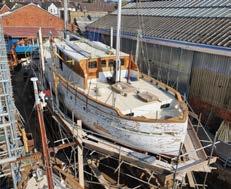
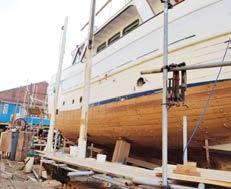




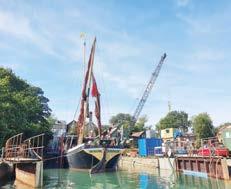
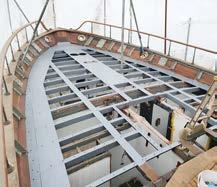


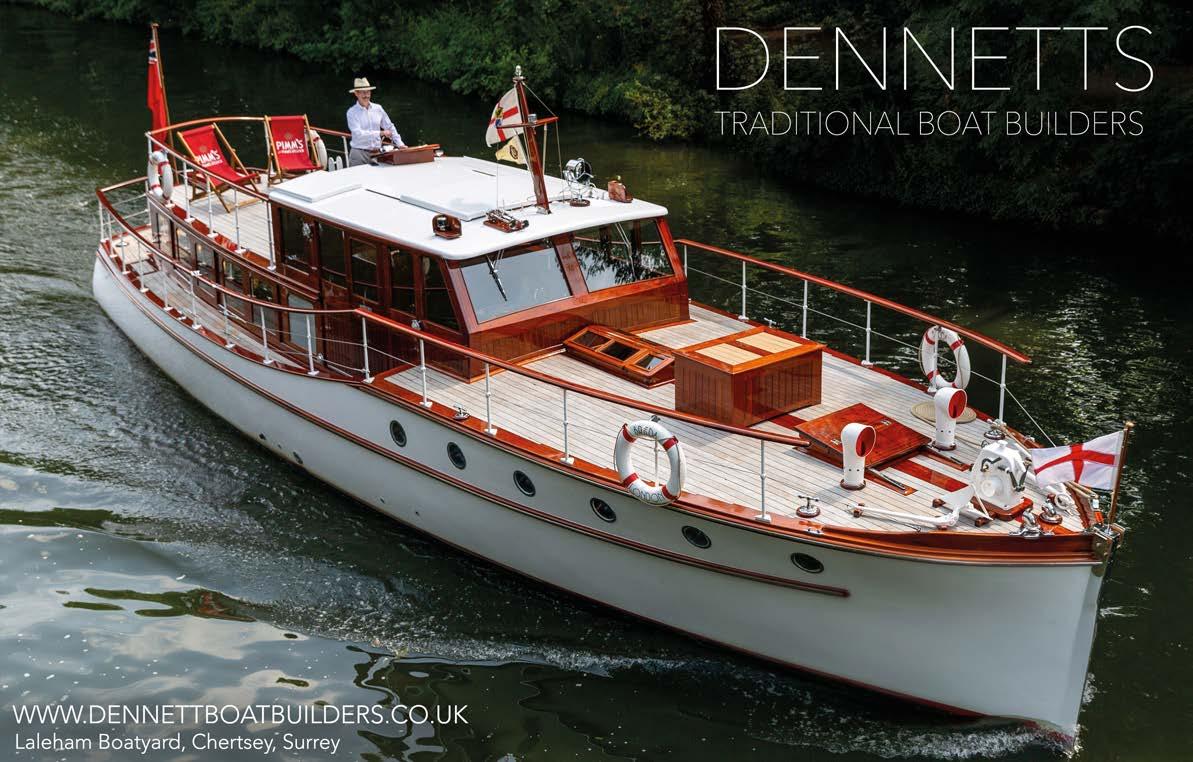
most
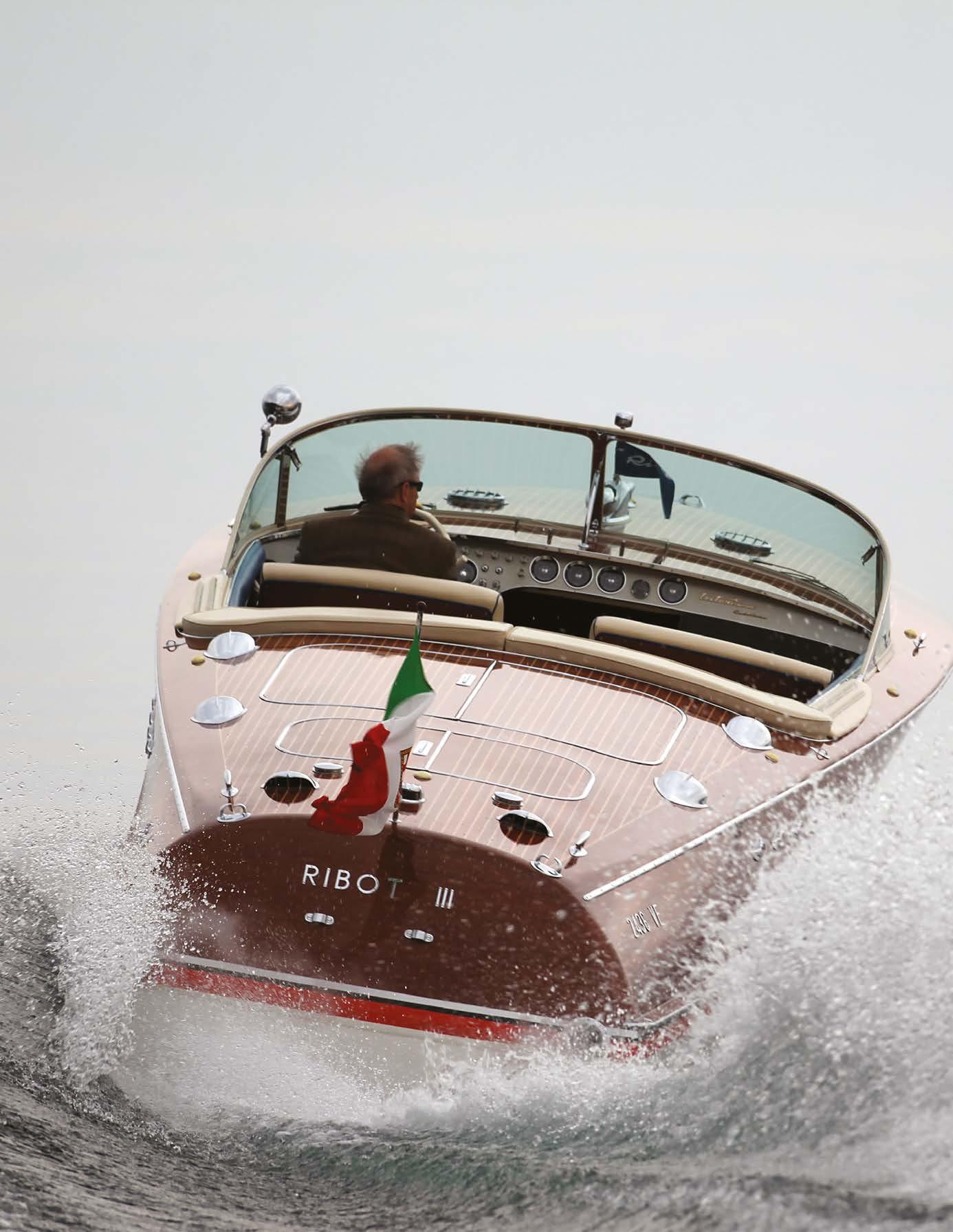
who
Creator of a brand symbol of luxury and quality, Carlo Riva would have been 100 years old this year. Each letter of his name recalls the outlines of an exceptional pioneering journey.
The genesis of so many success stories is often in the family environment. Carlo Riva was no exception to this, founding a world-famous brand as the heir to a long line of builders of transport and work boats originating from Lake Como. His father Serafino took the helm in the early 1920s, building himself a solid reputation in competition, both as a driver and as a craftsman. His speedboats won numerous trophies, attracting orders including from the Italian government for a small series of service boats destined for overseas operation. Located in Sarnico on Lake Iseo, the small Riva boatyard produced one boat at a time with rigor and consistency, a stream of vessels built with the traditional shipwright’s methods.
When World War II ended Carlo, then a young engineer, was destined to continue the family business. But the precariousness of its daily economy always dependent on a few wealthy sponsors fond of racing, and the working conditions still in the 19th century, did not fit the vision of a son who had his eyes locked on a far distant horizon.
Carlo’s name starts with a ‘C’ and ‘courage’ seems to be the right gauge to measure his first steps in the business world. Many feats would illustrate that audacity, but one early describes them all: his trip to the United States in 1952 to meet the then world masters of the motorboating industry, Chris-Craft, in Algonac, Michigan. Carlo, who had to borrow the money to make this trip, was trying to obtain the exclusive import contract of Chris-Craft engines for Italy. Having barely enough cash in his pocket to pay for a handful of these reliable powerplants to be the basis of his future serial boat range, our man invented a tall tale about new import limitation in his country. Believer or not, the
Facing page: The lines of a Riva are unmistakable. This one, the Cadillac-engined Tritone Ribot III is perhaps the best Riva in the world today
Above: Carlo Riva happy at work
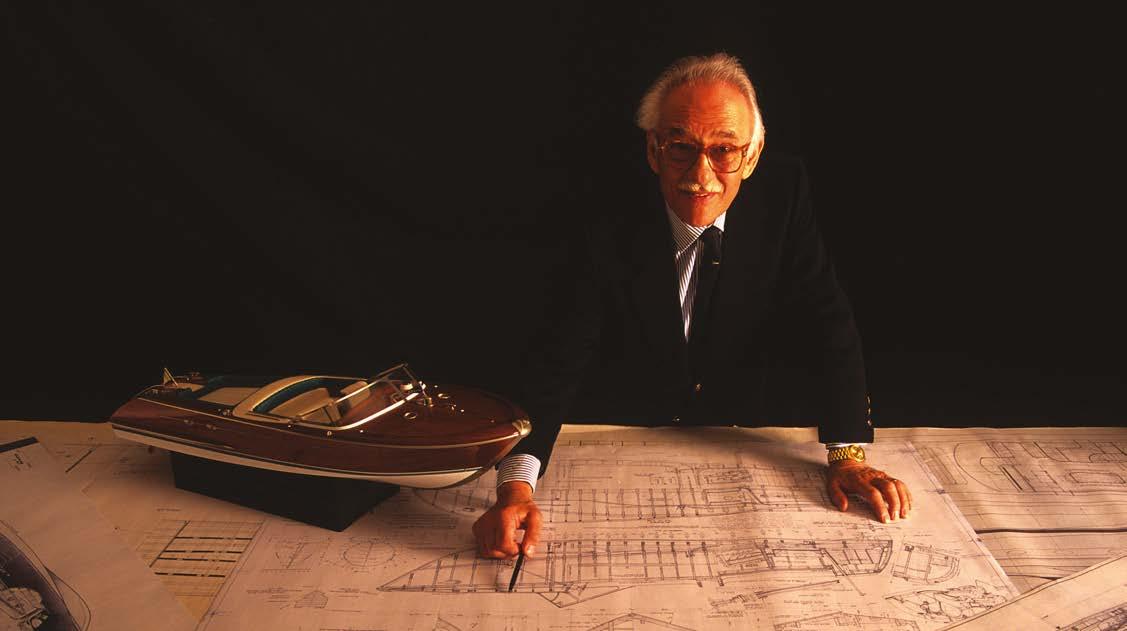
Below: Carlo Riva’s passion with boats and the water started at a young age
Americans played along and signed the contract, no doubt fascinated by the determination of the young Italian. The same apparent self confidence was displayed several times including in 1953 when it came to financing the new ultra-modern Sarnico boatyard, and in 1960 when his Dutch friend and customer Freddy Heineken introduced him to the De Vries shipyard where the famous brewer had a large steel yacht built. At the time, yachts over 20m were a scarce breed. Carlo, the pioneer, seized the opportunity and returned to Sarnico having added a partnership with Feadship to his business portfolio.
Until the mid-1960s, wooden construction still dominated high-end motorboat production. To keep ahead of demand, Carlo annually bought a large load of sought-after exotic species of wood from a highly reputed Genoese importer and piled up enviable stocks of mahogany from Honduras, then from Africa, from which his carpenters of Sarnico came to draw like sommeliers in a cellar of great wines. These woods were then magnified by the application of 19 coats of varnish that made the Riva’s impeccable finish jump out. The long-term development of Carlo’s high-quality products has been one of the keys to the success of Riva. Tireless researcher of the best in every detail, Carlo, the engineer with an artist’s eye, did not omit any development,

whether it be technical, scientific or psychological via advertising and marketing.
To move from the traditional double planking construction and improve durability and production efficiency, Riva partnered with a firm specialising in high-performance plywood in the mid-1950s and developed the Marine Plywood brand.Later, in the early 1960s, Carlo joined forces with Pirelli to develop a unique mould that allowed the hull to be attached to the structure of the Aquarama in one piece. It was in effect the start of composite technology. The thinking now was to seduce a rich clientele by offering powerful, twin-engine, glitzy launches for the sunny Med. To do this, Riva transformed the twin-engine Tritone Aperto by equiping some of them with rear sunbathing bays like the Florida model. It also replaced its wide front seat with two beautiful separate seats to improve movement around the cockpit.All that remained was to christen this glorious pleasure craft with a fantastical name taken from the three-screen Cinerama movie theatres of the time.Although it was just an ingenious adaptation of an existing model, in 1962 the Aquarama conquered the top spot on the podium among Riva’s glittering boat range, widening the gap with its competitors and stablemates.
By some, Carlo Riva, like many of his generation, could have been mistaken for a ‘macho man’. However, he always paid much attention to female sensitivity in his styling research, especially with his wife Licia. Carlo remembered their walks on Paris’s Champs-Elysées during the Paris Boat Show, where he would follow her recommendations on colours and patterns during pleasant window-shopping sessions. Thus was born the ‘Aragosta’ (orange/coral reef) shade applied to the upholstery of some of his models. Their eldest daughter Lia, magnetised from childhood to the hum of the large boatyard of Sarnico, today runs Monaco Boat Service, the number one Riva distributor in the world with the passion and much of the same imperatives as her father.
As a customer-orientated builder, Carlo Riva worked a lot on supply, never forgetting the demand side with some pioneering approach to the clientele. In 1957, the
Above: Taken during a cruise of the Aegean in the 1970s aboard the family Aquarama
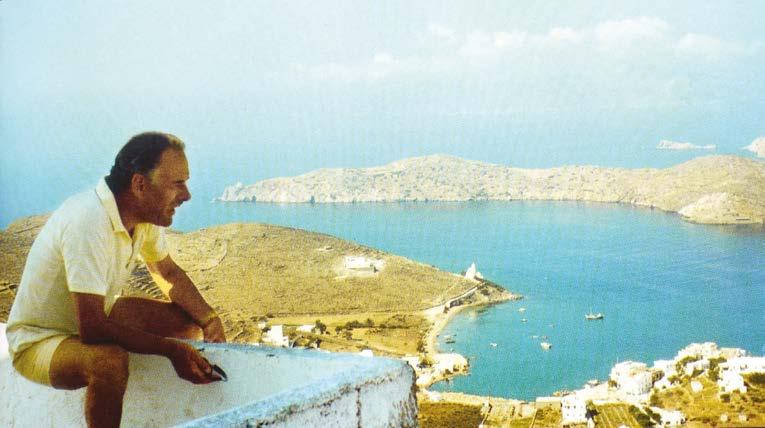
Below: The zebra pattern seats on Anita Ekberg’s Tritone was o ered on some Riva models in 1960

creation of RAM Revizione Assistenza Motoscafi in Sarnico would be the prototype of the Riva Boat Service chain that would proliferate internationally, mostly in Italy and France. All these initiatives were supported by advertisements that barely showed the product, choosing instead to focus in on a lifestyle espoused by the boats.
Carlo Riva, very early on, knew how to make good use of the social position of his clients but was also proud never to have made a product placement, or to have had to offer a discount or even a special favour to anyone, even a king or the president-in-office of a country. He was very rigorous when it came to collecting bills and would occasionally field a call from the Italian Department of Foreign Affairs. An embarrassed voice would ask him to avoid a diplomatic incident for an unpaid balance on delivery. Carlo, having blocked the shipment of a runabout bought by some potentate or other eager to receive it for his holidays, would always offer the same reply: “If it is so urgent and important, the Italian Republic should cover the overdue balance on behalf of the recipient!”
For several years, Carlo Riva went to explore the Greek archipelagos from Puglia with his Aquarama, escorted by Dick Bertram’s 38ft (11.6m) personal cruiser ceded by his American friend and boatbuilder colleague in the early 1970s. His admiration for the homeland of the Olympics made Carlo write: “Greece of my happy years, your ever present memory, tints my life with a sweet nostalgia. Two colours dominate the rainbow of my thoughts: the intense blue of your sea and the immaculate white of the clusters of small houses clinging to the hills of your islands.”
As someone born on the shores of a peaceful Alpine lake, Carlo Riva had a complex about boatbuilders on the salty coast, and their reputation for building more rugged and seaworthy craft. From the start of the 1950s, Carlo put his first boats to the test of the Mediterranean Sea in Santa Margherita, a seaside destination prized by the Milanese gentry. While there, he made sure to seduce
Clockwise from top left: Carlo’s father’s yard at Lake Iseo; The new factory that enabled serial production; Boat storage tunnel built under the Princely Palace of Monaco in 1959; Good advertising was part of the secret of selling more than 4,000 boats between 1950 and 1971; Boat hoist at the modern yard at Lake Iseo; Young Carlo (second from right) on his visit to Chris Craft

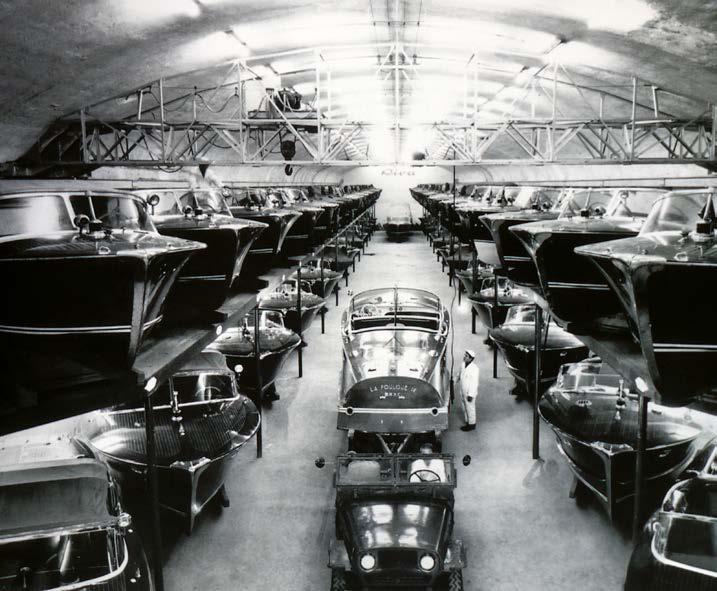
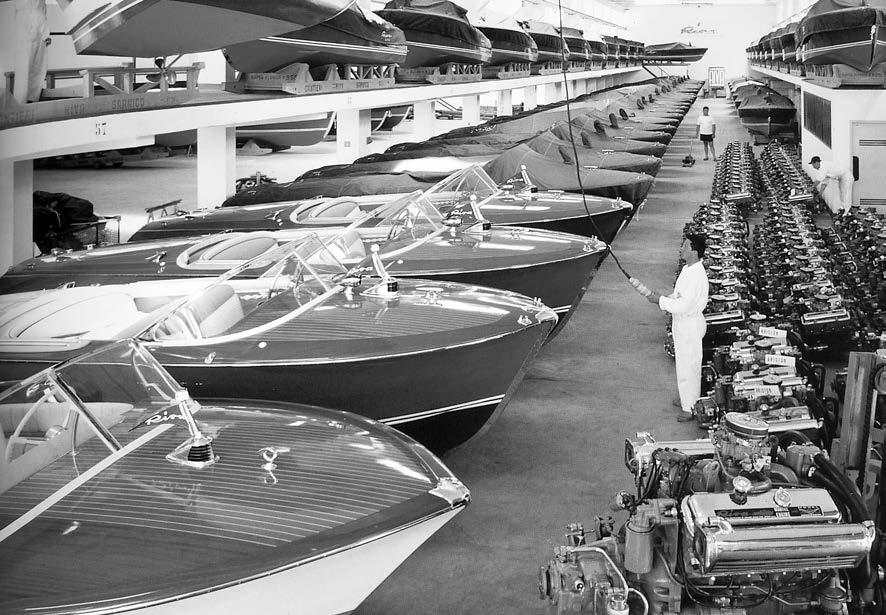
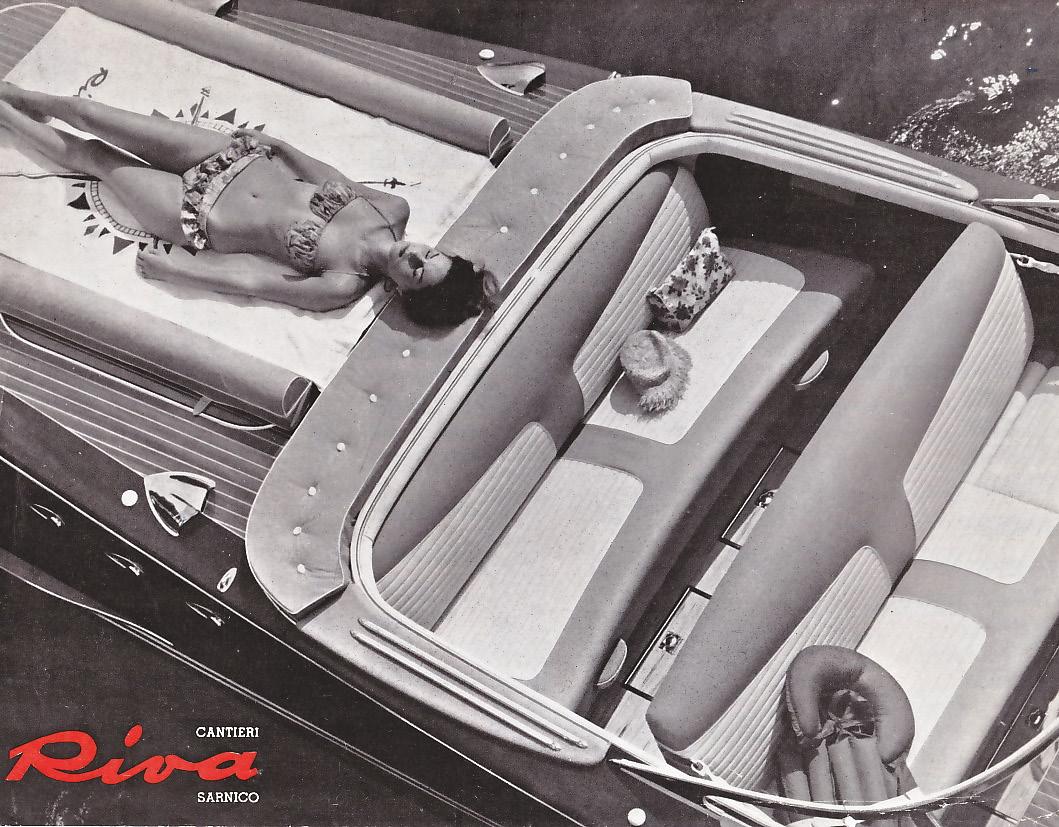
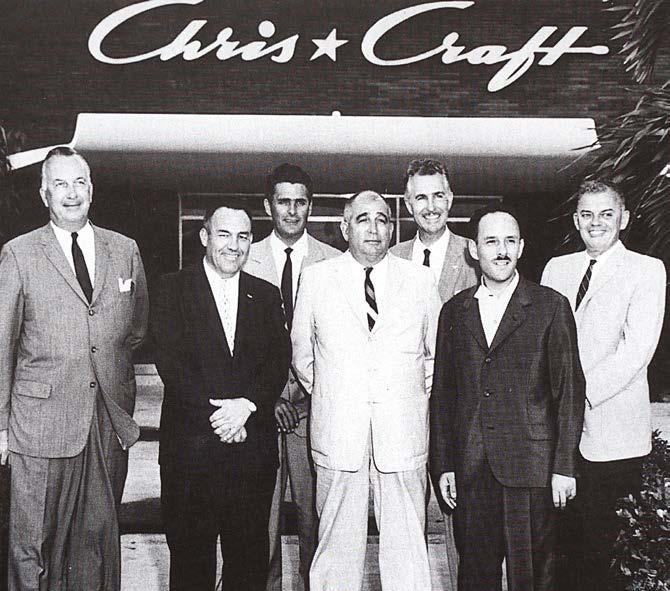

this fashionable, waterskiing clientele. The success of Riva is partly attestable to this rigour: from the start, the boats were noted for their good seakeeping. In terms of rubbing shoulders with the high bourgeoisie, the young Carlo had past form. His familiarity with some of the snobbery of the era stemmed from the early days back at the old Sarnico boatyard, where his father was sometimes badly treated by his wealthy clientele. Carlo’s solution was to reverse the roles by making Riva the brand of the elite.
Unlike its glamorous neighbouring lakes Maggiore, Garda or Como, Lake Iseo has long been associated with manufacturing. The area has a tradition of industry that Carlo was heir to, but he wanted to improve the area’s image, as well as that of his own brand. For the latter, instead of calling on some local photographers, in the second half of the 1950s he commissioned Federico Patellani, ‘the Italian Cartier-Bresson’, to do a photo shoot. Patellani had the then rare idea of taking aerial pictures of the boats and chartered a ferry upon which he installed a metal tower. The results were spectacular.
Above: The ultra modern new Riva factory, that Carlo managed to finance in 1953, at the age of just 31

Below: Rivas lined-up at mooring in the port of Golfe Juan on the french Riviera are among the most striking symbols of Carlo’s success
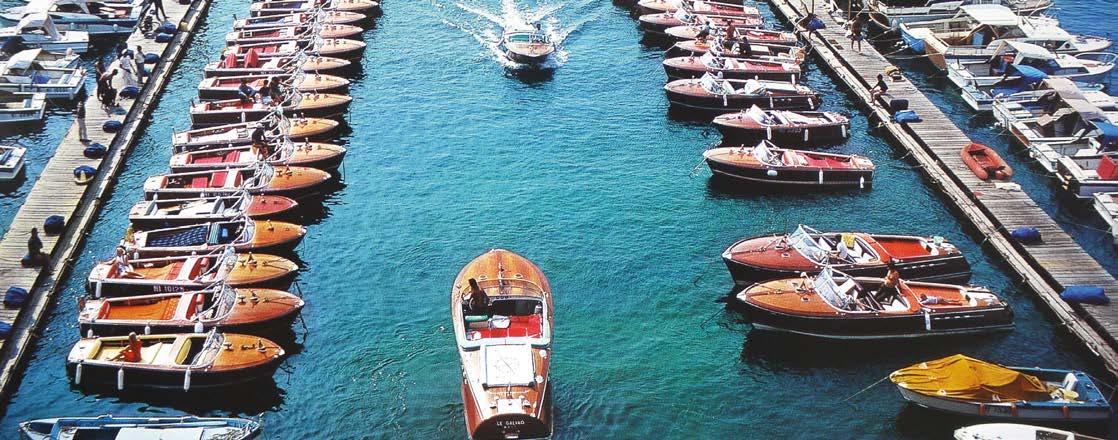
In terms of Lake Iseo, Carlo Riva has always thought big and far, with his avant-garde boatyard in 1954. Today, visitors to the Riva production site in Sarnico, part of the Ferretti group, always admire the astonishing ‘command bridge’ wanted by Carlo after the sale of his yard in 1970. This bold concrete post overlooking Lake Iseo is one of the most recognizable markers in the area.
Many compared Riva with another uncompromising Italian entrepreneur of the era, Enzo Ferrari; but while Ferarri was driven by racing, Carlo was motivated by perfect production. During his nocturnal boat inspections, if he noticed an imperfection, he would give it a good hammer blow to force the culprit to take it back. The architect Giorgio Barilani also experienced this kind of misadventure after working on sketches. Checking the project in the evening, Carlo would not hesitate to tear up a day’s work if a detail displeased him. Barilani still had his throat clenched more than 30 years on. It is probably at such cost that Riva built the brand we know, in an absolute imperative towards others and himself.

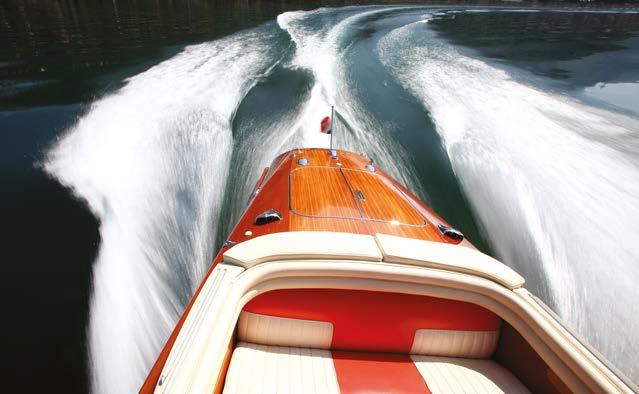

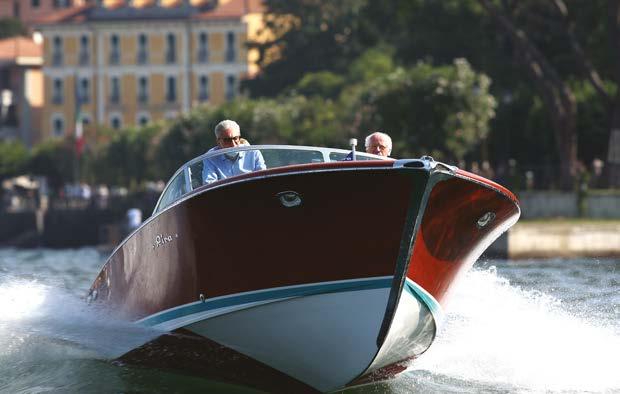
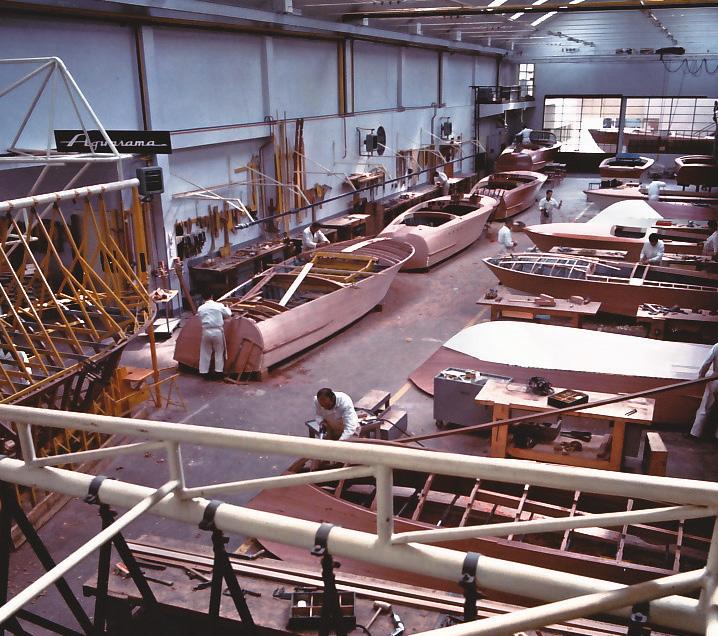

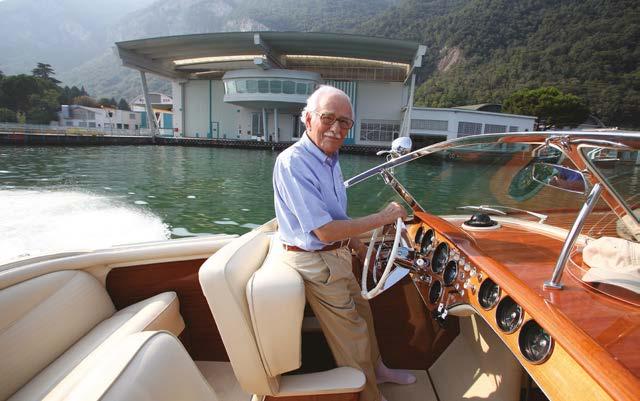
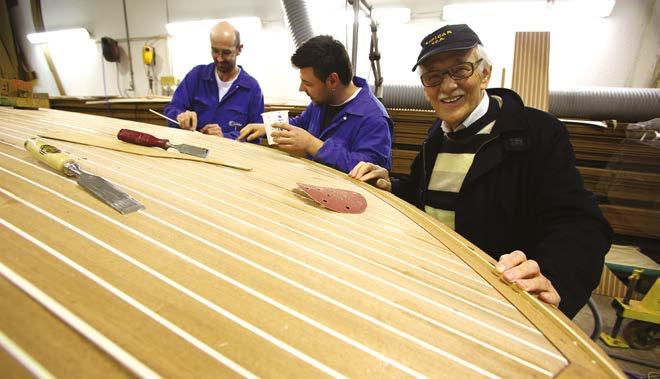


Rivas line the port in Monaco. On the left are classic mahogany runabouts. On the right, their modern-day counterparts, modern boats, but still built with a mirror held up to the past.
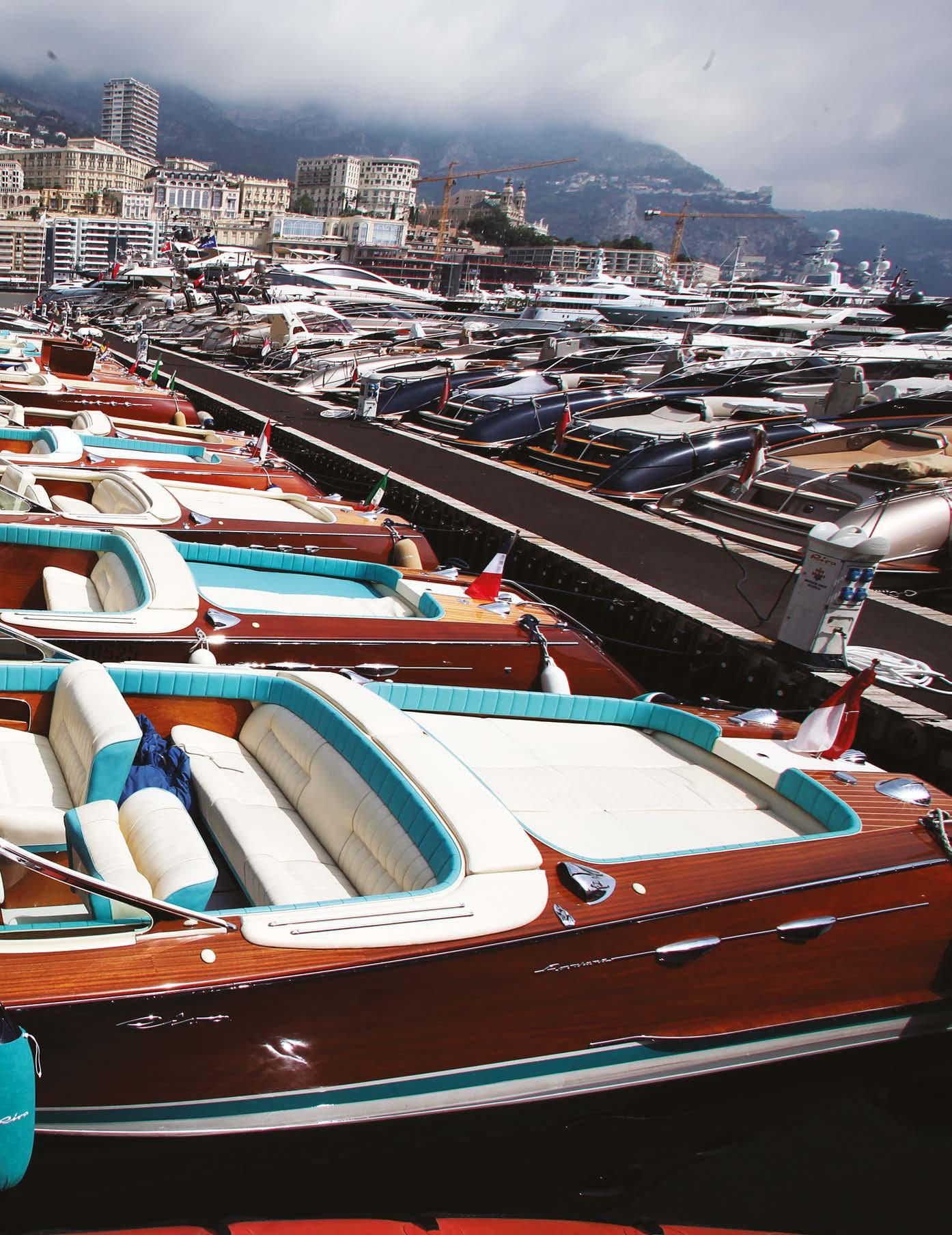















































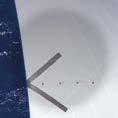

























Stunning traditional yachts,showcased through beautiful photography and expert editorial coverage


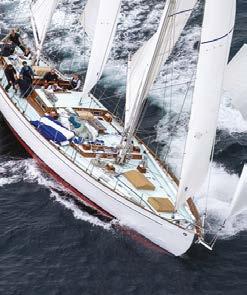







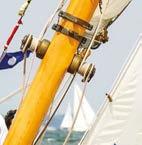

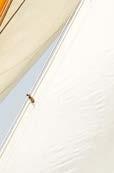



Expert advice In-depth examination at a practical level with credible advice above deck and below









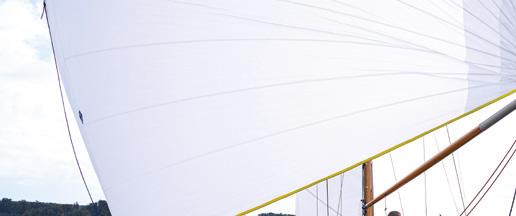







Featuring classics of all types, from J-Class yachts to traditional work boats and everything in between








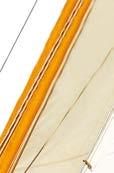








Overthe years, articles on advances in yacht design have invariably focused on hull form and rig, and very rarely on interiors – but it’s here that some of the most important changes have taken place, changes that affect not just the accommodation, but the entire vessel. The traditional yacht interior – at least up to around 30ft (9.1m), which was typical for cruising yachts of old – barely changed since it was standardised between the two wars by serial builders like Berthon, Hillyard and countless others.

Spirit Yachts founder Sean McMillan has designed at least 100 yacht interiors, and although these include the wildly futuristic, like his collaboration with Rhoades Young on the Spirit 111 Geist, he has mostly held the hard-won wisdom of the past tightly in his hand. “That classic inter-war yacht interior,” he says, “was just
Above: The 1957 Sangermani yacht Sahib’s interior was designed by yacht designer Stefano Faggione
Facing page: Original interior of the 1970 McGruer yacht Cuilaun (55ft), showing the outboard berths of the larger yacht
practical at sea or at anchor or on a mooring.” What we are talking about here is as follows: galley to port, chart table to starboard then, moving forwards, a settee each side for sitting or (with a lee cloth) for sleeping, with a folding table between. Forward of that would be the fo’c’s’le, with typically a fold-down pipe cot on one or both sides, and a mess of sails, ropes, anchors and buckets on the sole. The heads might be a bucket and chuck-it arrangement between those two pipe cots with a hatch above for headroom while using it. (The man whose head appears above deck on a beautiful morning is not just admiring the view.) On the larger yachts, you would get a separate enclosed heads to port and a hanging locker to starboard, between the saloon and fo’c’s’le. The cutaway of the Albin Vega overleaf gives a rough idea. Larger still, and you might get a quarter



berth or two. These are berths aft of the galley an/or chart table that extend all or part way under what would otherwise be the cockpit lockers. Siting the galley and (usually) heads to port, made life in those places more comfortable when heaving to in the usual fashion, on starboard tack. Narrow bunks were a necessity on vessels of limited beam, and they also meant that occupants could sleep wedged between settee back and lee cloth. Again, this suited the hull shape, as these earlier boats heeled more due to that narrowness in the beam, a narrowness that enabled them to sail well to windward.
Yachts grew beamier in the 1950s and 60s, as a result of new thinking on boat speed and, later, as a result of the IOR rule that encouraged broader vessels. That extra beam allowed additional saloon berths, outboard of and above the usual twin-settee arrangement. For decades, little else changed: a glance at a popular yacht of the 1960s or 70s, like a Westerly, shows much the same arrangement. It was only during the 1980s, when marinas took prevalence over the old swinging moorings, that things started to change radically.
“Once this happened,” explains Sean, “it became normal to design boats from the inside out. “You’d see how many bedrooms and bathrooms you could fit in for a given length of boat. This was the beginning of the really grotesque period in yacht design. Boats grew so much at the stern that they’d become unbalanced and they started needing two rudders and two wheels. Maxing out the beam like this for owners’ space made for very poor sailing yachts. It’s been a regression in design for over 30 years now. The holy grail, which is to make a boat sail upwind –anything can sail downwind after all – has been sacrificed for greater beam and the hotel-like accommodation that goes with it.” Of course, this reflects marina life, where most boats spend the great majority of their time tied to the pontoon, and where sailing, particularly to windward, has become a rarity. Sean’s own preference is to design the old way – from the outside in, and that goes for any good sailing yacht, modern or traditional.
Above: Cutaway of an Albin Vega with a traditional small-yacht interior, little changed since the early 20th century


Below: The electric Spirit 44CR is of similar beam/length ratio to a classic, and with much the same lay-out. The big di erence here is in the berth extending into space that would otherwise be taken up by a diesel
The other big change coming will have a more positive effect on yachts than marinas have had, and that’s the advent of electric propulsion. It’s long been common on smaller boats on the inland waterways, but it’s making big inroads into large sailing yachts with cabins too, particularly at Spirit, where already half of them are pure electric drive. The electric drive unit on, say, a 45-footer, is about the size of a shoe box, freeing up the space behind the companionway and opening it up for accommodation. The real bulk is in the batteries, which can be installed in the optimal position – below the sole boards and close to the centreline. At the same time, increasingly strong build methods and the judicious use of carbon fibre has the potential to reduce or eliminate the need for bulkheads. This is a blessing and a challenge, given that no yacht intending to go to sea should have an interior like a ballroom. For most of us, whether redesigning an interior as part of a restoration, or building a boat from new, those old rules from the yacht-building’s dawn will still prevail, and no one knows the game better than Roz Cunliffe, who has put together her thoughts for us, based on decades of passage-making at sea.
Clockwise from top left: The new galley on Sahib, in periodappropriate Formica with mahogany; New 8-M Starling Burgess and her stripped-out racing interior; Detail from schooner Altair, whch won the only ‘best below decks’ award we’ve given (in 2015); New Kim Holman 43-footer Cass, very trad, with outboard berths; White paint finish for the ex-workboat Angele Aline; Modern Nav panel on schooner Viveka rises out of a trad chart table






craft have been my home on the sea for more years than I’d care to admit. Back in 1972 my husband Tom and I sold our house to buy our first cruising boat, an original 32ft (9.8m) Colin Archer pilot cutter built in 1903, and I was determined it would be a place where I’d feel comfortable down below when the wind was shouting and the waves were mountains high. On that boat I could only stand up under the skylight, but she had a solid fuel stove, oil lamps and, in harbour, a sheepskin rug on the cabin sole.
Subsequently, I travelled many thousands of miles with no refrigeration and no shower on the Bristol Channel pilot cutter, Hirta. Her 1911 accommodation was long gone, but following up on what I’d learned already, I designed a new arrangement that served us well. From there I progressed to designing the
Above: Westernman under sail
Above right: Tom and Roz aboard Saari in 1976


Facing page, top: Roz mocks up the flue for the solid-fuel stove aboard Constance
Facing page right: The upgraded dinette on Constance serving as an o ce
accommodation for Westernman, a 40ft (12.2m) gaff cutter we commissioned for ourselves and, just a couple of years ago, I was asked to help with the interior of Charles Watson’s Saecwen which featured recently in CB. Not everyone has the opportunity to start from scratch and many may not want to. I remember when we were planning Westernman, I went around permanently with a ruler; measuring all sorts of things, lying under tables and inviting myself on other people’s boats just so that I could find out the width of their side deck and check whether or not you could actually sleep in their bunks at sea. I’m also a great one for mocking up a layout with cardboard boxes, tables, chairs, or whatever comes to hand, so that I can see exactly if it’s going to function. I’ll never build again, but if you decide to, then consider what the designer Ron Holland had to say. “There must be large open spaces so those on board feel
Tips on how to design a practical and functional cabin space while maintaining a homely feel
unrestrained and unaware of the limited dimensions of the yacht, but there must equally be intimate areas, where privacy can be maintained even in the midst of a large party. The simplest way of achieving this is to ensure that at standing eye level the visual space uses the full width and length available, but when sitting down the occupants are more enclosed, protected and supported.”

This is a great starting point, along with looking at loads of images of boat interiors. When we were constructing Westernman I amassed a huge file with cuttings of features and fittings I particularly liked on other boats; panels for locker doors, handles, types of wood, and so forth. On Westernman we were lucky to source pitch pine which, like Maurice Griffiths, we love for its grain. It was reclaimed from an old factory. This we used to panel the saloon and we finished it with a silk varnish. The shipwright who constructed it was a real character. He lived in a van and stowed his ‘stash’ above the vanity mirror in his ancient Cadillac, but he was a genius given a piece of wood.

Back in the real world of non-custom boat buying, you are going to be presented with someone else’s idea. If you can, live with it for a season to see what works before tearing it out. You might just be surprised.

This should be the heart of the ship where the crew come together to eat and yarn around the table, at anchor or at sea. I go on modern boats these days where designers have people sitting all scrunched in a sort of row on one side, sometimes even facing the galley. Who, I wonder, wants to look at the washing up while relaxing after a meal? It would just give me a guilt complex. For proper communication and, I suppose, a
spot of feng shui, nothing beats people facing other people across the table. And, above them, a hanging lamp casting a warm glow providing a focal point. Electric cabin lights have come a long way from the harsh beams of overhead bulbs and neon strips. Now you can read by bright LEDs, which dim on demand to create a relaxing atmosphere.
The table should have decent fiddles. On Westernman we ordered removable fiddles for the flaps. These were used at sea if need be, but they came off in harbour. Fiddles must be fashioned so that there’s a vertical edge on the inside. If they are ‘nicely curved’, which is quite common these days, then plates or cups that land against them will be scooped up to take off at sea and deposit their contents in your lap.
How are the table flaps? To enable you to eat easily the flaps must come out far enough, but not so far that when you raise them, you have to ask the occupants of the settee to move into the next cabin – before ushering them back to squeeze round the table.
At the end of a hard day’s sail, it’s good to lean back and stretch your legs out – make sure there’s space for this under the table. Many are impeded. When we bought our current boat, a classic cutter built in glassfibre, she had a dinette with upright seats, which would be more suited to a pew in church. We threw them in the skip immediately and used contoured cushions slightly angled to get the right back rake. Then
Above left: Saari
Above right: Looking aft in Saari’s saloon

Below left: Westernman Note the table with flap extended and holes for taking fiddles at sea


Bottom right: Pitch-pine panelling and William Morris fabric combine to bring warmth and cosiness below
we did away with the forward athwartships seat, dismantled the table and reinstalled it flush against the forward bulkhead, enabling us to move round it without having to breathe in and shimmy into position.
Nothing says ‘homely’ like a cabin heater. We’ve always had solid fuel stoves and I insisted on one for our modern yacht. You can’t beat them when it’s cold or wet and, should you run out of cooking gas, you can heat up soup and beans on them, or boil a kettle. However, you need to make sure you have space to store the fuel.
Some saloons, notably on race boats, feature pilot berths. These have never been a favourite of mine as the space always looks a bit forlorn and I’d rather see a shelf with books. Invariably pilot berths are narrow and climbing into them at sea on a rough night often means standing on the nose of the person kipping on the saloon bunk. On Saecwen the owner insisted on one, so I suggested he fashioned it after a real pilot berth on the original working cutters by enclosing part of it. This has the double benefit of helping the person sleeping there to feel it’s more his or her own space. It’s also tidier all round. A major downside of the pilot berth is that the settee underneath is narrower and more upright than a normal saloon berth.
If the saloon settees are regular size, they are the prime place to sleep at sea as the motion is best there, but they do need good leecloths. On Westernman we even went

so far as to arrange a removable wooden leeboard. This cunningly made up the bottom half of the back of the settee. When required, the top half hinged up, and the bottom board was lifted out and slotted into the front of the bunk. The cushion on the bunk stretched out under the back of the settee so it made a really decent berth. In addition, the bedding could be stowed out of sight behind the woodwork when not needed.
Should the main sleeping cabin be up forward or down aft? Each option has its drawbacks – there is either the creak of the anchor chain or, especially on modern boats, the noise of the stern slapping on the water. I’ve experienced both, but so long as I can sit up in bed, my back supported by a bulkhead, with a good reading light and a shelf to put my cuppa on, I’m happy.
Planning on living on board and going cruising? Then this needs to work – and work well. If you have to cook and wash up in any sea at all, a U-shaped galley with the open side at the aft end, rather than at the inboard end, is best in order that you can brace yourself when heeled. However, if you’re stuck with the open side athwartships as always seems to happen to me, make sure you have a good bum strap and a solid bar in front of the cooker.
Two sinks are a winner. I prefer these to be of the same size and really deep, so that you can wash up in one and drain in the other. If these are on the small side,
Above left: Solid fuel stove on Constance installed where a square locker containing the air-conditioning unit was once sited. Note the high fiddles

Above right: Westernman’s galley showing plate and mug stowage
Below left: Saecwen on launch day, with Nigel Irens (left), Tom Cunli e and Beth Richardson

Below right: Detail from Saecwen’s galley
you might find the large lobster saucepan, or the roasting tray won’t fit in, and the closer you can site them to amidships, the better for when the boat’s heeled. I’m always thinking about how life will be in a Force 9. A deep sink means you’ll only need a small amount of water to wash up in, so there’ll be no slopping over. With ready hot water on tap these days, I do all the clothes washing, except towels, on board – washing in one and rinsing in the other.
If you have pressurised water taps, it’s best to ensure there’s a separate hand or foot pump for drinking water. Fitted with an inline charcoal filter, it takes out any impurities and makes the water taste good. With such a system, the electric pressure faucets don’t need a filter and, should the batteries fail, you won’t die of thirst. On one ocean-going vessel I crewed on, there was even a seawater tap. These days with water-makers there’s not so much call for them, but if I were planning an extended circumnavigation I would certainly consider it.
Sinks should be covered. This not only makes the galley look tidy when not in use, it increases space. If both sinks are the same size, you can cover just one at a time and move the cover from side to side. You can always make the back of one of the covers a chopping board if you’re tight on room.

It always amazes me how much gear a boat can swallow, but it pays to have good stowage. Tom and I have never been fans of using plastic plates, so we have

wooden ones for use at sea, which help keep the food warm. In harbour we favour china. Our Denby ware was given to us for our wedding in 1972 and it’s been with us at sea for all these years crossing many oceans. In half a century we’ve only broken one. Our secret? Well thought-out stowage. Three of our boats have had what I call the ‘slot’ method. A set of open boxes with a properly finished face is located just under the beam shelf above the lockers. These are made to fit the plates. The front has a slimmish slot down the middle so that you can literally ‘post’ the plates in over the top, then slide them down. They aren’t going anywhere.
We also like china mugs, with each crew member having an individual one. Tom’s features the USS Constitution. He picked it up in a yard sale in America back in the 1970s. It’s still with us and no chips to date! On some of our boats, we’ve hung mugs on hooks underneath a shelf, on others they have been stacked one above the other, while at present they are sitting snug on a dedicated shelf.
It’s the same with glasses. We keep a few large plastic ones for when nothing else will do, but wine just doesn’t taste right out of them and, if you ask Tom to drink malt
Above left: Tom, with his long-surviving favourite mug

Right: Roz produces her bread, fresh out of the oven.
There’s nothing to beat the smell of newly baked bread on board

Below: Glass stowage made from a wooden wine rack aboard Constance

whisky from plastic, he’ll stop your rum ration for a week. That problem was solved by stowing them on a wooden wine rack screwed down horizontally inside a locker.
I love to cook, so for me a stove with an oven is a must. There’s nothing like the smell of fresh bread at sea, but I despair of finding a decent boat cooker nowadays. I’ve been shipmates with some ghastly examples. My current cooker has four rings, a separate grill and an adequate oven. The easy-access grill allows you to brown omelettes or cook things like cheese on toast without fuss, whereas if you had to open the oven door and wrestle with the broiler in a gale you probably wouldn’t bother. A cooker such as mine is nigh-on impossible to buy these days as the company that made them stopped production 20-odd years ago. I’d had them on previous boats, but foolishly let them go. So I was really fortunate that a friend of mine found a left-over new one on eBay. I’m hanging on to it.
One way to make your boat individual and reflect your taste is by thoughtful use of textiles. Instead of standard blue settee covers, why not try some chintz, or Jacobean fabric by William Morris, such as we had on a couple of our boats. They look great against wood and, because they are patterned, they don’t show spills. If you’re worried about them getting salty in mid-Atlantic, make them up as loose covers and have vinyl underneath for use at sea. In 1880 Morris famously declared: ‘Have nothing in your houses that you do not know to be useful or believe to be beautiful.’ Perhaps sailors should make it their mantra to have nothing on their boats that they do not know to be functional, believe to be beautiful and is thoroughly seamanlike.









Dartmouth broker Wooden Ships has two exceptional workboats on its books right now – “similar but di erent” as broker Richard Gregson put it. The first of these, the Falmouth pilot cutter yacht Pellew, will be familiar to CB readers and beyond. She was built by Luke Powell and team in 2020 as a replica of the original Vincent and was, at the time, the most talked-about new-build for years, not least because of her size. At 68ft (20.72m) on deck, she’s the biggest pilot cutter in the world. She was built solely with charter and sail-training in mind and constructed to Category 0 standards, enabling her to sail worldwide with charter guests or trainees and crew. The hull is oak on oak, bronze fastened, and the solid oak accommodation features eight guest berths and a crew cabin.


On deck, two electric bronze capstans help handling the rig and mooring lines. Pellew, which is coming to the end of a second successful charter season, is, says Richard, “a hugely impressive and elegant sailing boat, proven to be fast, easily handled, and an excellent charter platform. She is an ‘as new’ sailing yacht for half the new build price.” She’s lying in the west country and her asking price is £695,000.
The other boat is the well-known 1904 west country trading ketch Bessie Ellen, which “could be considered the flagship of UK traditional sailing boats” says Richard. She’s even more boat than Pellew at 84ft (25.60m) on deck and has been refitted for charter by her current owner, of 20 years’ standing. She’s exceptionally well suited to the role, with a ‘commercial grade galley’, plenty of seating, and a separate crew cabin for up to six crew members. Her obvious charm and comfort aside, what makes Bessie Ellen a “gold mine” is her certification, which would be very di cult to achieve today, if starting afresh. She’ Category 0 coded for 12 passengers and 6 crew, with a Class VI passenger licence for no fewer than 60 day passengers. She’s also coded to carry up to 50 tonnes of cargo, for anyone who is interested in joining the active sail-cargo movement. The owner and broker are keen for Bessie Ellen to find a British buyer to keep her in home waters. She’s lying in the west country and on the market at £599,000.
For information on both of these yachts, contact Richard Gregson, Tel: +44 (0)1803 833899, woodenships.co.uk




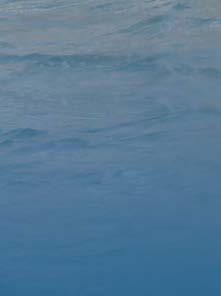




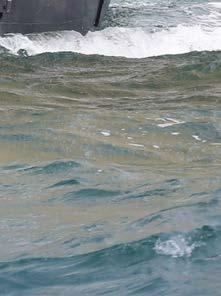





Every year the Shipwrecked Mariners’ Socie pays over £1M in grants to the dependants of those lost at sea, as well as sick, disabled and re red seafarers s uggling to make ends meet.

For the o en marginalised and forgo en mari me communi we serve, the economic and indirect health implica ons across the last two years have been severe and con nue to blight the lives of many, including some who are feeling helpless and vulnerable. Please help us to con nue our important work - thank you




With 30 years of experience specialising in traditional and electric boats we will do our best to nd the ideal craft to suit your individual needs — for a day or for a lifetime.
‘Albatros’ - an exceptional 48 motoryacht built in Berlin in 1928

To receive a copy of our new 2022 brochure and order form please contact: SMS,1 North Pallant, Chichester PO19 1TL | Tel: 01243 789329 e-mail: general@shipwreckedmariners.org.uk
To view and order cards online, visit: www.christmas-cards.org.uk/shipmariners/

suit your individual needs — for a day or for a lifetime.
For more information contact
With 30 years of experience specialising in traditional and electric boats we will do our best to nd the ideal craft to suit your individual needs — for a day or for a lifetime.
With 30 years of experience specialising in traditional and electric boats we will do our best to nd the ideal craft to suit your individual needs — for a day or for a lifetime.

For more information contact
HENLEY SALESAND CHARTER LTD +44 (0) 1491 578870 | sales@hscboats.co.uk www.hscboats.co.uk
HENLEY SALESAND CHARTER LTD +44 (0) 1491 578870 | sales@hscboats.co.uk www.hscboats.co.uk




For more information contact HENLEY SALESAND CHARTER LTD
With 30 years of experience specialising in traditional and electric boats we will do our best to nd the ideal craft to suit your individual needs — for a day or for a lifetime. With 30 years of experience specialising in traditional and




For more information contact HENLEY SALESAND CHARTER LTD


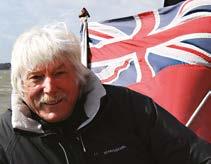
Lastyear, I think it was, I was invited to make a video aboard a yacht called Overlord. Overlord is an important classic that can be seen sailing the south coast of England and further afield under the burgee of the Offshore Cruising Club (sailoverlord.org). I have some history with this fine 58ft (17.7m) sloop that was built for the Luftwaffe in 1935 by Abeking and Rasmussen to the German 100 Square Metre rule. How she ended up in England is an unlikely yarn that starts when she was found in Kiel with a number of her sisters by the occupying British forces in 1945. Being owned by the German state, she was fair game as what might be called a ‘prize of war’. Back then, she and her sisters were simply known as ‘windfall yachts’.
None of the windfall yachts had engines, but they were performance craft and after some colourful passages to England they were welcomed by the armed services for training and racing. As they aged, most of them were sold off and faded away. Only a few remain. Among them are Sea Scamp, a fine 50 Square based on the Solent, and Overlord, the last 100 Square sailing in the UK.
My own time with Overlord was short but spectacular. I was invited to cruise along the D-Day beaches during the 70th anniversary of Operation Overlord. We weren’t involved with the main event because, despite the boat’s historical significance, she was still in Kiel under the swastika when the invasion fleet sailed for Normandy, but even so, who would turn down such an opportunity?
I hopped off the ferry from Portsmouth to Caen the day before the core festivities and trudged along to the marina. Every yacht except one American seemed to be flying some form of British ensign and they were crammed in four deep, but finding Overlord wasn’t difficult. Time teaches a sailor to spot an unusual mast at a glance, and among the roller furlers, swept spreaders and in-mast mainsails was only one that could be her. The spar was aluminium, but it was tall, raked and fractionally rigged with a proper set of jumpers. Downright elegant, I thought, as I made my way around to her. Why don’t modern fractional riggers have that sort of arrangement? The thrust of the jumpers triangulates the forestay so that the runners only need be set up for maximum performance or if the sea is shaking
the boat like a terrier. One similar rig stood out on the next dock. It was Sea Scamp, dressed in her best for the occasion.
To see Overlord in that marina with a modern race boat rafted up inside her emphasised where yacht design has gone in 80 years. As I climbed onto the racer to cross to Overlord, I had to step up a long way and the whole yacht tipped over to meet me. Boarding the 100 Square, my weight had so little effect that I might as well have been walking into the office. With a beam of a mere 11ft 6in (3.5m), Overlord’s waterline length is only 38ft (11.6m), giving 10ft (3.1m) of overhang at either end. When she heels, this lengthens her waterline in an unmeasured way while the buoyancy reserves prevent pitching. The long ends also allow her buttock lines to run out to a natural conclusion instead of being cut off short. Abeking and Rasmussen’s house designer made the most of his opportunity and did a fine job. How his creation would sail was still to be discovered.
Taking the boat out on the actual anniversary day was a non-starter because of the zealous security men who also contrived to lose my press pass, but there was plenty of time for my shipmates and I to don fancy dress uniforms for a World War Two party. This was to be held miles away behind the once strategically vital Pegasus Bridge. The evening started disastrously when our cab driver, a man clearly in league with whoever was in charge of the press passes, failed to show until 2215. Fortunately, the binge was running late. By the time we’d eaten our fill and were bopping to the Memphis Belles who, decorative and harmonious, turned out a classy revival of Andrews Sisters swing, our interest in life was revitalised. The night was made by two veterans who had to be the far side of 90 years old. One, clad in blazer, tie and medals grabbed the prettiest girl in the place and whirled her around in a full-on 1940s jive to ‘The boogie-woogie bugle boy of company B’. His mate bided his time until the trio took a break. Then he stood quietly by the mic and delivered well-rounded nostalgic songs of that age that brought a tear to many a younger eye.
By 0200 me and the boys were ready to toss in the towel. Although the old soldiers were still going for broke, we called our cabbie, only to find that once again, the wretch had defected. I slept like a brick after a three-mile walk home rounded off by a rum issue that would have stunned a buffalo.
As for the yachting, that happened the next day and it was worth the grief with security and the blisters. We decided to sail Overlord westward along Sword, Juno and Gold Beaches to Arromanches and the so-called Mulberry Harbour. Channel sailors know that this is an entirely man-made structure of concrete barges towed 100 miles across to France from England and sunk to form breakwaters. ‘Port Winston’ gave shelter to transports bringing supplies for the troops advancing into Normandy without yet having taken any major havens. It was a vital part of the campaign and seemed an appropriate goal for our cruise down the shores of history.
We awoke at 0600 after three hours sleep to a thunderstorm and torrential rain. I had lost a borrowed oilskin and my only socks the previous day – probably blown up by security since they were tucked into a rucksack I had set down and which vanished without trace. As we locked out, however, the rain eased off and all clouds were banished from a glorious day. We hoisted the big main to a light northwesterly breeze and hanked on our largest jib. The engine was shut down and we bore away onto a close-hauled heading. It is a rare thing to have such a thrill from simply sailing a boat. As we accelerated to six knots, Overlord began to stride across the easy swell with the gentlest of motions. She heeled just so far as to show she was about her business, but not enough to bother anyone. Her helm was so light you could let it go for half a minute while she kept right on slicing to windward. When the breeze piped up a notch she
settled into her stride at something over seven knots. There is a grace about Overlord’s progress through the water that I’ve rarely experienced. Her motion has a velvety texture that is hard to describe. Modern boats with similar pretensions to performance will, of course, be faster and will point higher, but they will never approach Overlord’s powerful, loping gait. It’s a physical thing, far more than mere nostalgia in the face of living history.
Arromanches was close abeam by lunchtime. The plan was to enter and lower the dinghy so I could take photos. As we shaped up for the gap in the caissons, however, our old friends the security men came speeding up in a launch waving their arms and making unmistakable ‘go away’ gestures. In despair, I looked around. On our other side, also arriving at high speed, was a RIB crewed by two handsome young gendarmes. As I explained the position, their faces lit up. They were both sailors, they said, and our treatment was an outrage. The security boat was summarily dismissed and the RIB became my private press boat as Overlord strutted her stuff magnificently. We were reaching out through the gap in the sunken barges as the rising growl of four Rolls-Royce Merlins announced the first Lancaster buzzing the beach at low altitude, watched over by a Spitfire and followed by a pair of DC3 Dakotas. The crowd cheered as rousing military music faded astern and we realised that this was a time to live in the moment. Sailing such a yacht against so rich a backdrop will not come again.
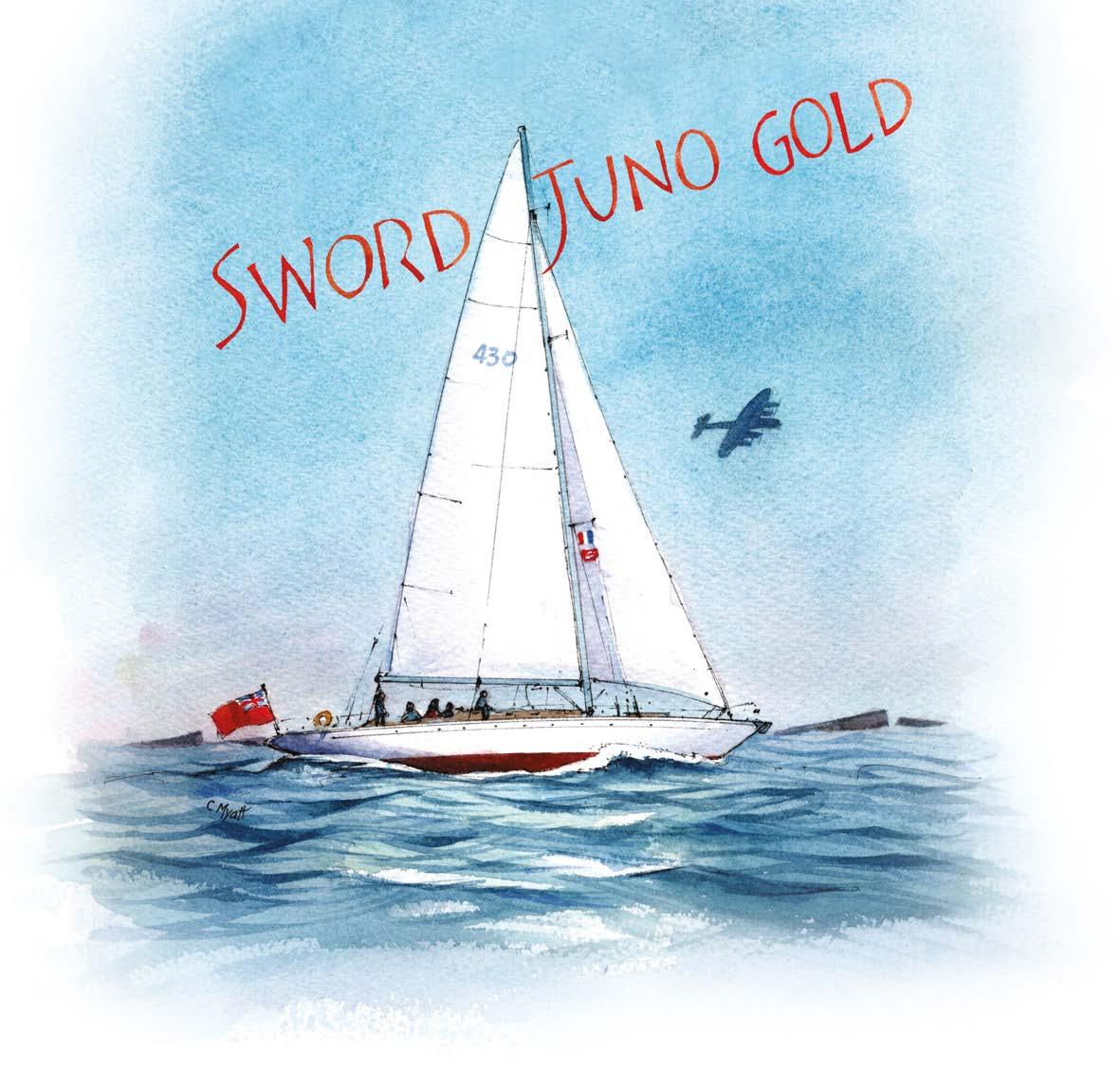
French ga cutter, LOA 12,60m, length on deck 9,60m, Beam 3,30m, Draft 1,80m, engine Volvo Penta. Built in Granville, Normandy 1964. Hull iroko on oak frames, coachroof mahagony, teak deck. Successes in several Classic Boat regattas. Well maintained with boatsmancare and in first class condition. Owner selling now for reasons of age. Location Andratx, Majorca. GBP £49.900. Contact: canvey@hagengrote.de Phone: 0034 606379226
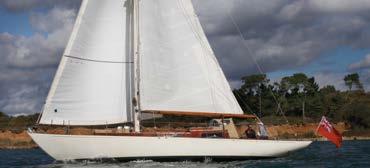
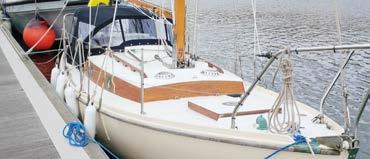




sale Sibyl of Cumae, a 51 ft. William Fife from 1902. She is a very beautiful and fast boat. She sleeps 5. Sibyl has always been maintained to a high standard. Recently all the electricity and navigation instruments have been renewed and updated. She is double planked mahogany and ceder under the waterline, oak frames and a lead balast keel. She will be ready to sail in the Fife Regatta in Scotland in the Spring of 2022. Laying in S.W. England.
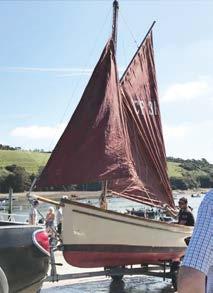
Asking price £235.000. For more information, please contact Cornelius van Rijckevorsel on 0044 (0)7816932312 or email at: corneliusvanrijckevorsel@ googlemail.com


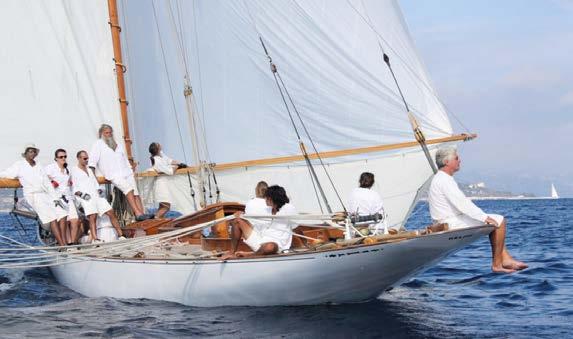
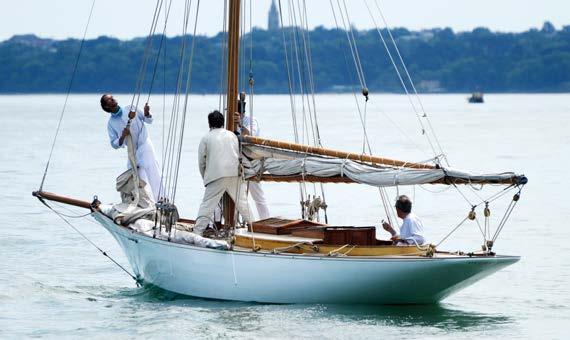
Mere mention of her name imparts a legendary tone to any yachting conversation: HALLOWE’EN was always guaranteed fame by pedigree - she is among the most beautifully proportioned of all Fife yachts - and subsequently earned it in four quite distinct lives. Starting with a record setting line-honours win only two months from launching in the second edition of what became the Fastnet Race, and more recently in winning overall the Panerai Mediterranean Championship. Moreover, while most Fifes of this size are gaff rigged, HALLOWE’EN’s beautifully conceived Bermudan rig, as original, allows relatively easy sail handing for short-handed racing and cruising with friends instead of a team of professionals. €975,000 Lying France
PEGGY BAWN’s exceptionally authentic restoration is recognised in her CIM rating’s almost unrivalled coefficient of authenticity. Cruised and raced since, she is noted for perfect balance and good manners. In 20 knots under fingertip control her toerail kisses the water, and up to 17 knots, a flutter in her jackyard topsail marks optimum groove. Easily rigged and sailed by two, this perfect Victorian cruiser/racer offers the opportunity to step back in time into the shoes of her illustrious designer, then at the peak of his career.
UK
KELPIE is a race and regatta winner: one of the most beautiful and fastest classic yachts of her size. Late in the intense 2018 Mediterranean classic regatta season she notched up 1st overall in the Vintage Gaff Class at both Cannes Régates Royales and Les Voiles de St-Tropez - only typical of the way this superb Golden Age survivor has been cared for and campaigned under present ownership, including restorations 2009-2012 at Fairlie Restorations - the rebuilders of

Any yacht featured in the superb pre-Second World War series of ‘Uffa Fox books’ is without question a special one, and DRIAC may be best known these days from her inclusion in Fox’s ‘Sailing, Seamanship and Yacht Construction’ (1934). From a time when the design of the ideal offshore sailing cruiser was still evolving and much discussed, Uffa waxed lyrical about this characterful Charles E. Nicholson design which had comfortably reeled off well over 5000 miles in her first two seasons, including Portsmouth to Malta and back, under the command of her redoubtable first owner, A.G.H. Macpherson. DRIAC is still taking people on sailing adventures and, as she has always done, entrances with her looks, presence, and no-nonsense sailing ability.
Market
On 4 June the Woodbridge Boatyard (formerly Everson’s) hosted the OGA (Old Ga ers Association), enjoying a long Jubilee weekend cruise on the Deben, for a celebratory barbecue. Toasts of honour, after the Queen of course, were Clytie, centenarian this year, and the yard’s own beautiful new dinghy La Mouette.
The 30ft (9.1m) high-peaked ga cutter Clytie, surely the longestserving and oldest resident dame of the Deben, was not only built at the yard but has been kept and maintained here, and sailed by the same family, ever since Sir Cli ord Paterson (great grandparents of the current owners Jo and Paul Masters) commissioned her in 1922. She is often cited as the inspiration for the Deben Cherubs. The Masters are active
The 124-year-old Norfolk wherry Albion, one of only two remaining commercial wherries built specifically for the Broads, and the only known example in carvel (the others are in clinker), has been re-launched after some work at Cox’s Boatyard in Ipswich, Su olk. She’s 58ft (17.7m) with an unstayed mast of 42ft (12.8m) finely counterbalanced on a tabernacle for sailing under the many bridges of the Broads. She served as a trading vessel until the beginning of World War II and then as a lighter, until acquired by the Norfolk Wherry Trust for restoration in 1949. Since 1981 she has been moored at the Norfolk Wherry Trust base at Ludham.
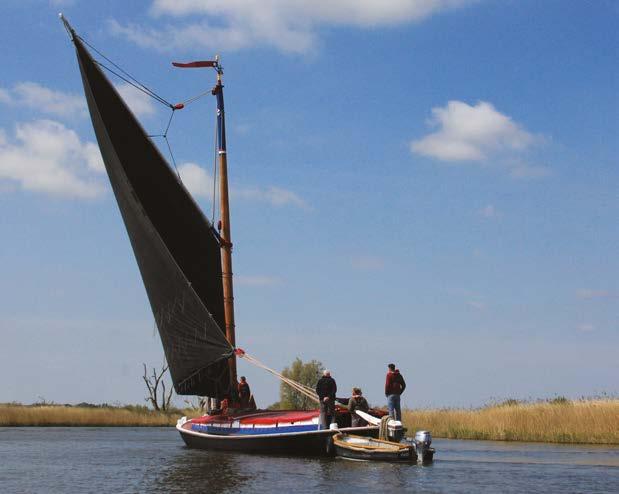
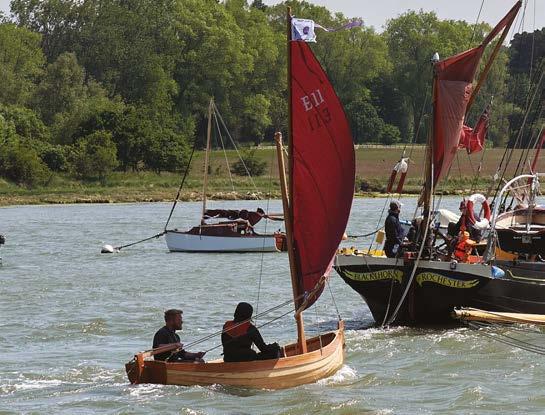

Albion has been into Cox’s several times over the years. This time, it was for a quick lift out for a few leaking seams between her planks. “It was a quick job to caulk and Sikaflex the planks and re-tar the hull before lifting her back in,” according to the yard, who also spoke of their pride to be associated with the Albion: “It’s always a special day when she is in our boatyard.”
with the OGA and over 25 boats joined them for the weekend, together with an assortment of local ga ers, including two Deben Luggers.
La Mouette is the first traditional new-build at the yard for 50 years. She is a replica of an Everson’s 11ft (3.4m) clinker dinghy, designed, built, rigged and finished in-house. Lines were taken from yard manager Matt Lis’ dinghy, originally built here some time between the 1920s and 1950s, and she has larch planking with African mahogany sheer planks and transom, oak keel, stem and apron, and an iroko centreboard case.
It was a breezy day and Matt took her out for a spin in front of the yard with her new owner, much to the pleasure of spectators on the waterfront. He hopes she will be the first of many.
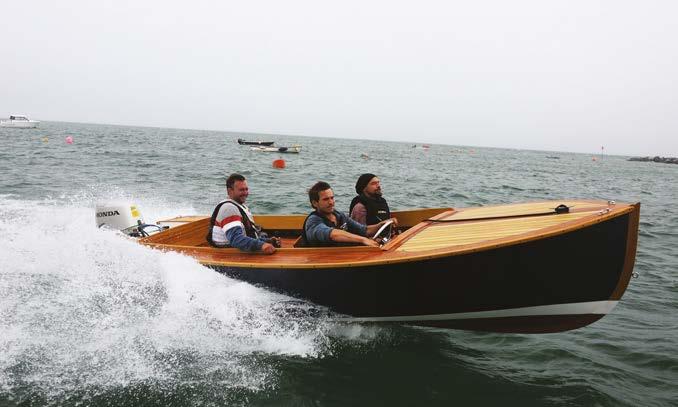
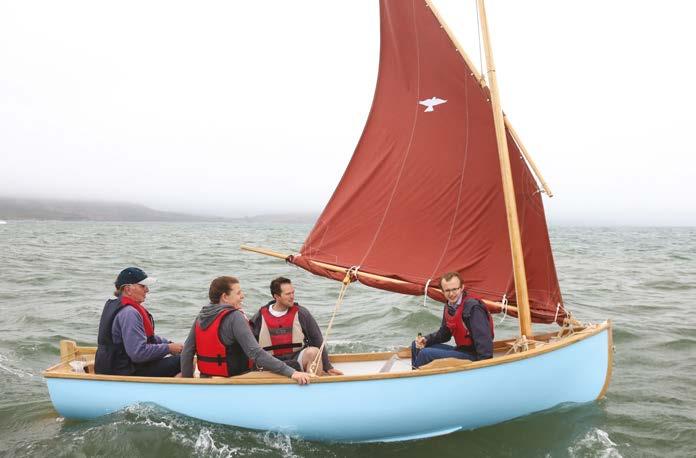
Four boats built by the 15 students of the Class of October 2021 were launched at the BBA’s Launch Day in August. First in was Lorraine McGowan’s Paul Gartside-designed Skylark(top left). Academy students have previously built four of these in traditional clinker, but this one was built of glued carvel construction with 3/8in yellow cedar planking (epoxy/glass sheathed inside and out) and sapele centreline. Blustery conditions in Lyme Bay prompted the crew to reef the standing lug rig.
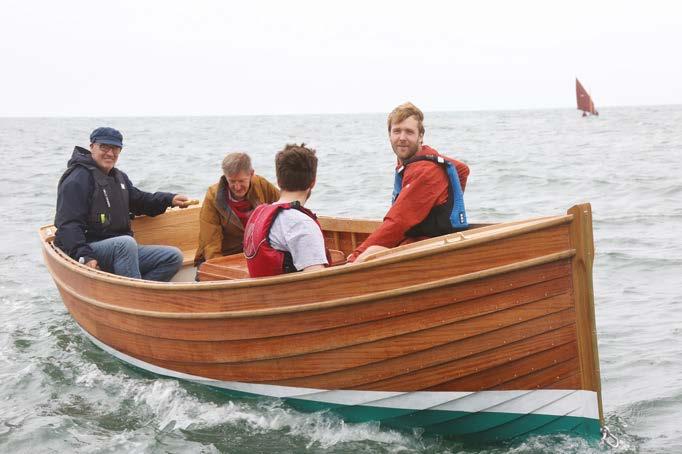
Tony Stringer’s 18ft traditional clinker launch (top right) is based on lines provided by Salcombe boatbuilder Nick Smith. With khaya planking, a sapele centreline and the timbers, outer stem and fit-out in oak, she is powered by a Beta Marine 14hp diesel. Dom Burger’s 16ft speedboat Snooks(bottom right) is the first boat ever built at the BBA to a design
by the commissioning student. Naval architect Dom was allowed to do this after convincing the tutors that he had thoroughly researched the planning of the construction process as well as the design. Built from a combination of plywood and cold moulding on ring frames, Snooks has a 115hp Volvo Penta petrol engine, and Dom hopes to get her up to 40 knots after further trials.

Tim Odling’s 17ft Gartside design 221 (bottom left) was the last boat in. Strip planked in 5/8in yellow cedar, she has a laid deck with sapele covering boards and king plank, and iroko for the rest. She was designed for a 20-30hp outboard but supply problems forced an upgrade to 50hp. On launch day she reached 21 knots with three people on board and with a bit of a swell in Lyme Bay. Report and photos by Nigel Sharp
BRISTOL, UK
Bristol-based merchant Robbins Timber has recently added TMT Marine to its list of products. TMT is a sustainable alternative to Burmese teak aimed at the marine market. TMT starts out life as American maple, selected and cut at source to achieve a straight, quarter-sawn grain. It is then kiln-dried before undergoing a thermal modification process.
“The result,” say Robbins, “is a rich brown, quarter-sawn timber with a Class 1 durability rating.” It is apparently suitable for decks, margin boards and, like teak, most other applications on board a boat. It also “o ers a very viable alternative to traditional teak sourced from Myanmar, which can no longer be imported into the UK.” Robbins Timber is the sole distributor of this product in the UK and Ireland, and will supply TMT in any quantity, rough sawn or machined to decking or other profiles, in a wide range of lengths and widths.
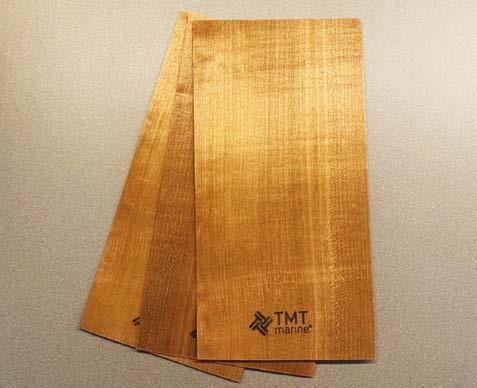




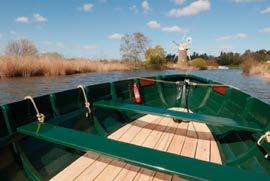
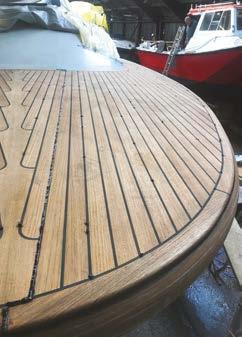

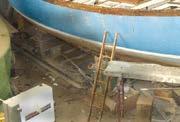




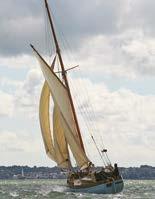

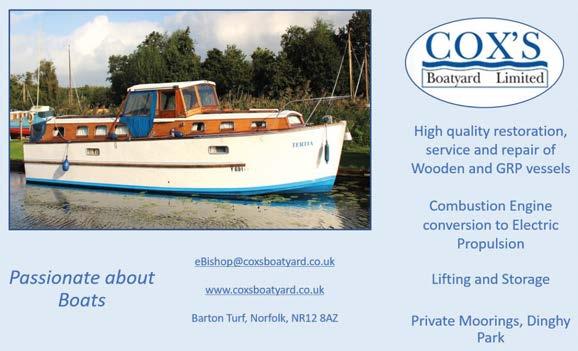

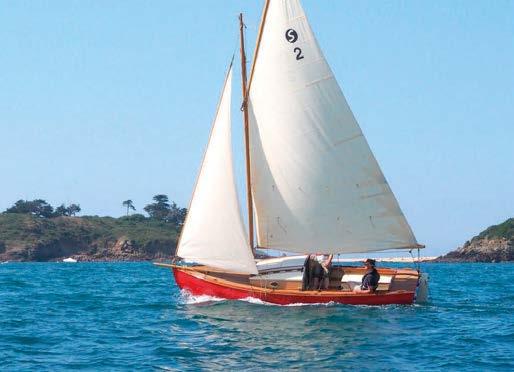

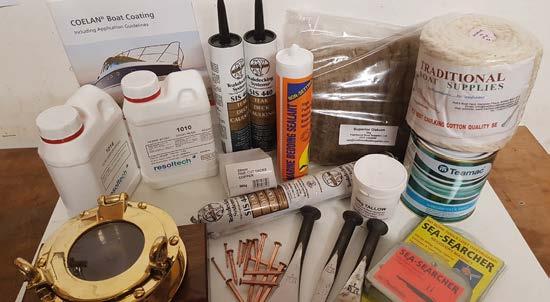





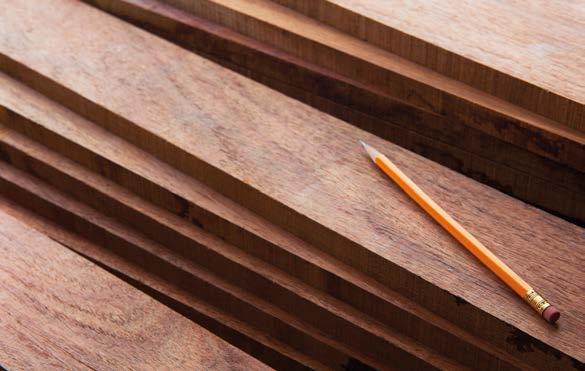
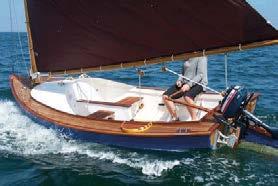
Howdo you keep traditional boat repair skills alive? One answer is to pass them on to the next generation. Within the Maldon Marine Boat Yard on the River Blackwater is fatherand-son team Adrian and Sam Riva who have worked together for 14 years. Over this time, Adrian has passed his knowledge to his son. He says that it takes that long to develop all the skills required to run a boat yard that o ers repairs and rebuilds of classic yachts and boats. Their hard standing and slip is full of boats that are in for maintenance, repair or restoration.
Adrian himself learned his skills initially via an apprenticeship, which took in an assortment of di erent craft from clinker dinghies to classic yachts, under the guidance of shipwright John Yardley. He worked for John for five years, starting in 1984. John Yardley started work in 1949 and learned from his father who began in 1922. After the apprenticeship, Adrian then became a journeyman for five years working in di erent yards.

In the final yard, Adrian worked in as a journeyman, they were restoring West Solent One-Designs, 6-Metre yachts and various other classic day racers. In 1999, Adrian had the opportunity to work with John Yardley again. The first job was to rebuild the 28ft (8.5m) Falmouth quay punt Dorothia. This was carried out in the yard that, for many years, was known as Dan Webb and Feasey’s. It is now known as the Marine Store Boat Yard at the Shipways, which was taken over by the Lodge family in 1992. It was here that in 2001 Adrian set up on his own working on classic restorations at the old blacksmith workshop, right opposite the yard along Maldon’s waterfront.
Adrian and his family look after the boatyard side of the business for the Lodge family with whom they have a very good relationship.
In 1990 Adrian met, then married Mari, with the arrival of their son Sam in 1993. Sam left school part time at 14 to join his father’s business in 2007 as an apprentice – which after another 14 years he has now completed! Adrian’s view is that while a one-year boat building course is a good start, it takes much longer to learn all the skills required to maintain classics yachts. “This job is about bevels and understanding a bevel card,” he says. It’s about practical skills and strength too: “Driving keel bolts out, for example – if you are not using a 14lb sledgehammer on a 1in keel bolt, you ain’t going to move it. So, you’d be inside someone’s beautiful boat with a 14lb hammer trying to get it high enough and hit it hard enough so as you can drive it through the floor, hog and keel and hopefully get it moving.”
Above: Mari, Adrian, Sam, Katy, with twins Freya and Lyra
Sam’s first project at the age of 16 was to restore a 22ft (6.7m) gun punt, followed by a 1936, two and a half tonne Johnson and Jago called Dozb Bah. She is still afloat in the marina and was once owned by Adrian himself, when he too was 16. The patronage and kindness of Dozb Bah’s owner Peter Hall paid for Sam’s early apprenticeship. Many customers enjoyed Sam learning on their boats, allowing him to advance his skills.
Now Sam and his partner Katy have their own family, two-year-old twin girls, Freya and Lyra, and, who knows, they may well continue the classic yacht traditions.
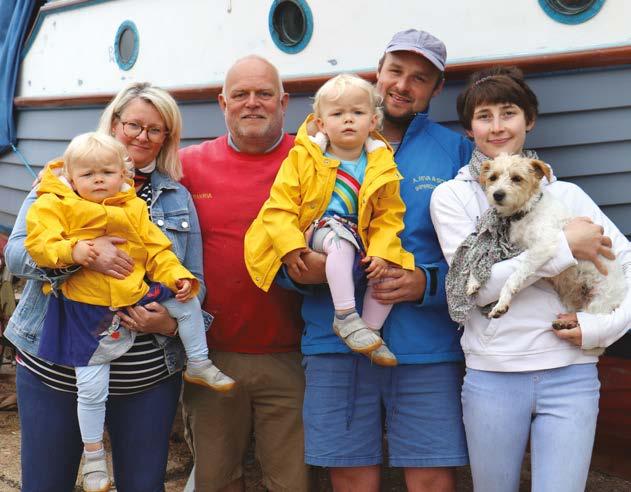
Adrian and Mari have lived afloat since 1991 and now Sam and his family are also liveaboards, having converted a trawler yacht to their needs. I went on board Sam’s, and it clearly shows his skills and thoughtful designs. He has made a limited space into comfortable accommodation, using walnut and oak wood to create lovely interiors for his family. It’s still a work in progress, but it started with gluing frames inside on the concrete hull with foam insulation followed by lining panels and new, larger deckhouse. This was soon followed with oak sole boards and the fit out of the galley/saloon, two bedrooms and the heads with a bath, all carefully planned.
Meanwhile Adrian and Sam are both passionate about passing on their skills. They are looking out for an apprentice who does not mind getting dirty, wet or kneeling in bilges, or working at the bench doing joinery, and also prepared to learn and understand bevel boards.
Top left: On the slip is Empress, a Morecombe Bay Prawner, built in 1928 and now owned by Stephen Caunter, which has been rebuilt from the beamshelf upwards including new deck beams and new deck and coachroof Top right: In the shed is the West Solent One-Design Hyacinth, which when relaunched will return to her original name of Quiz of 1924.
Owned by Phil Plumtree, who also has Arrow in the yard for maintenance, Hyacinth is going to be a complete restoration. Already the deck and ballast keel have been taken o , before new stem and sternposts and frames are fitted, followed by hull planks and new deck beams and deck
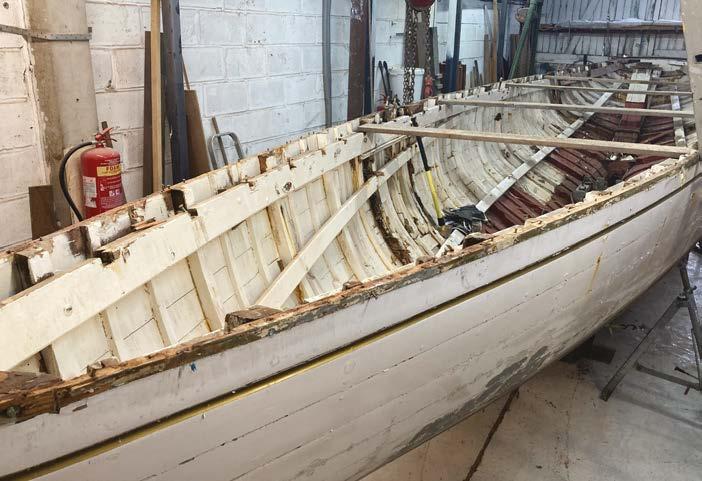

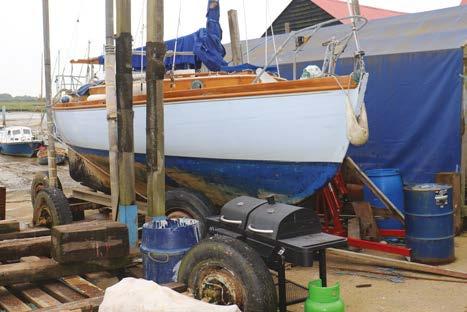
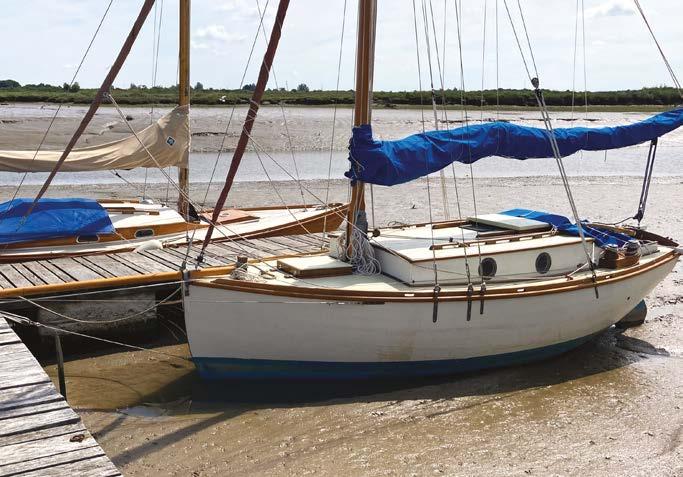
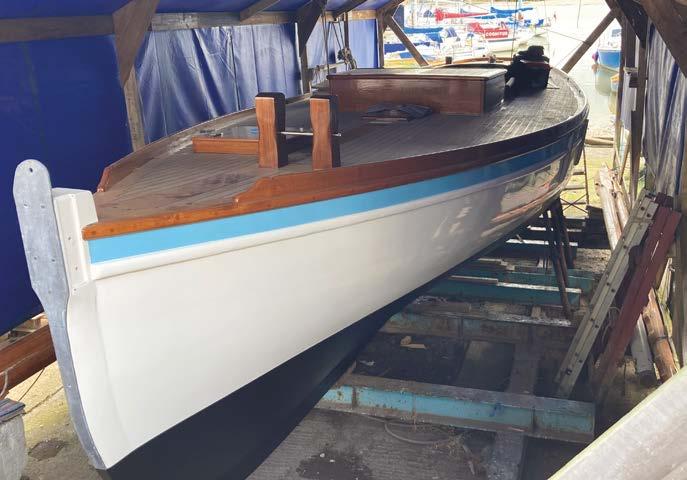
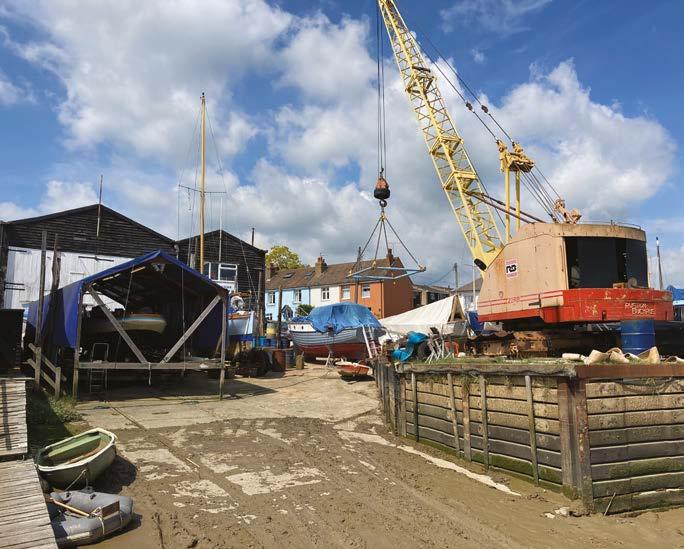
Above Left: 1936 two and a half ton Johnson and Jago Dozb Bah
Above right: On hard standing, the Vertue Dolly has had her teak deck re-caulked, a job that was completed by a combination of Adrian’s skills, and owner Ruby and her friends

Left: A view of the yard
Below left to right: Sam’s fitted out houseboat; Gudrun, a 26ft (8m) double-ender had a new deck 10 years ago and is currently ashore for running maintenance; Morgan Giles 32ft 6in (9.9m) motor launch
Springfield awaiting restoration
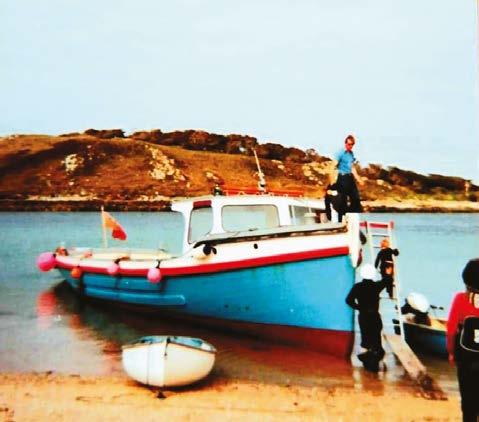
1
The mini-bevel gauge we made from an old hacksaw blade in April (CB 406) is normally used for transferring bevels while planking the hull but is also handy for noting unknown angles when out and about.
Whereas a carpenter’s sliding bevel is too bulky a tool to be counted among the
standard inventory of the pocket, not to mention conspicuous in use, our slim 3in bevel stows easily in the wallet and may be discreetly deployed wherever an angle arouses curiosity.
Here the mini-bevel is used to note the dovetail angle at corner joints of a sailor’s


ditty box. For future reference the angle is noted on a straight-edged card, likewise carried in the wallet.
1 Mini-bevel adjusted to the dovetail angle
2 The angle is recorded on a straightedged card
Not the least of many factors a ecting the holding power of a wood screw is the angle of its long axis relative to the wood fibres; the holding power of a screw driven into end grain may be as little as half that of one driven into side grain. The species of wood is also significant – screws of equal length and gauge hold better in dense hard woods than in light soft woods. And for a given timber, longer, larger diameter screws hold better than shorter, thinner ones. The metal itself has a significant bearing in the long run: in a saline environment brass screws lose their grip as electrolysis wastes their zinc, while steel screws used in woods rich in tannins not only rust but destroy the wood around them. Technique has also to be taken into account, since every screw must have the right clearance hole for its shank and a pilot hole ensuring optimum bite for its threads.
In light of that, it can only be a rule of thumb which says the length of a wood screw should be at least one-and-a-half times the thickness of the part (such as a garboard) that it’s fastening to another (such as the hog) but it’s a rule that’s held good down the years.

When the Bailey-pattern metal plane, bristling with screw adjustments, arrived in the UK from America, the wooden hammer-adjusted plane was pushed aside like the horse-and-cart before the motor car. Solid beech plane stocks were retired as door stops or went to the fire in a last blaze of glory warming the inglenook. But a renaissance in hand skills has stirred a hunger for these old ‘woodies’ which – for the traditional shipwright especially – are as symbolic as they are practical, with wood as a boatbuilding material having rebounded from near extinction during the age of plastic.

As surviving wooden planes are dusted o for us to marvel at their scars and improvised repairs bespeaking a lifetime of hard graft, their historical interest often outweighs their potential as feasible working tools. Meanwhile commercial wooden plane-making in the UK has all but disappeared such that an English-pattern jack plane costing ‘thirty bob’ in 1960 could set you back £300 if sourced from a boutique maker now. Finding new wooden planes that are high quality and a ordable isn’t easy.
Fortunately our woodworking colleagues across the North Sea
were less easily convinced by Bailey’s new-fangled planes, perhaps because their preference is for a prominent front handle or ‘horn’ di ering markedly from the English pattern, and wooden plane-making has survived there without interruption. In Remscheid, Germany the firm of E.C. Emmerich founded by master craftsman FriedrichWilhelm Emmerich in 1852 has not only persevered with the wooden plane but developed and improved it, with today’s range running from a pocket-sized adjustable block plane through smoothers, jacks, routers, rebate and plough planes, to a handsome try plane and specialist veneering tools.
Comprising just the wooden body, wedge and single iron, it appears this
ECE and English-pattern jack planes
Making wooden planes since 1852
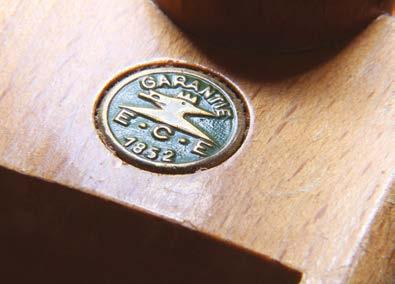
Tapping the strike button
model 105S jack plane, used for squaring timber and smoothing away saw marks, could hardly be more simple. Closer investigation reveals the precise fitting of abutments against the wedge, subtle shaping of the horn to suit a right-handed worker (a left-handed version is available) and an intriguing ‘castellated’ joint between the hard-wearing hornbeam sole and the stock. Work has burnished the hornbeam to glide effortlessly over the wood. By contrast, the effort of overcoming an iron jack’s inertia soon grows tiring. Today’s equivalent of this plane with a redesigned wedge support costs around £65, and there’s an even better version with a lignum vitae sole.
NEXT MONTH: Glazier's diamonds

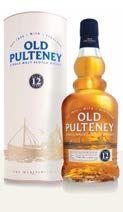

Thank you for your magazine, my husband has been subscribing for years and it inspired us to buy our classic yacht Boojum from 1909 four years ago (she is on the National Historic Ships Register). We launched a refit that took us longer with covid but last summer we raced her in the Round the Island Race and in Cowes Classics Week. After that we went on a trip with the whole family (children two and four years old then) from Cowes to the Channel Islands, then along the West Country. We decided to move her down to the Mediterranean but she su ered a mechanical failure in Porto, so another refit. We are just on board her again: the family are cruising down to the south of Portugal (no sights of Orcas, so far thankfully). There don’t seem to be many families who sail a classic yacht; we are having some great family times cruising and living on board her for a whole summer (we rent out our house in the meantime in Cowes, Isle of Wight). It has not been easy with all the repairs, but throughout it all we have really met several very passionate people that have shown dedication to this classical yacht, which has been heartwarming. Well thank you for the good read, and inspiration. I’ve attached some pictures.
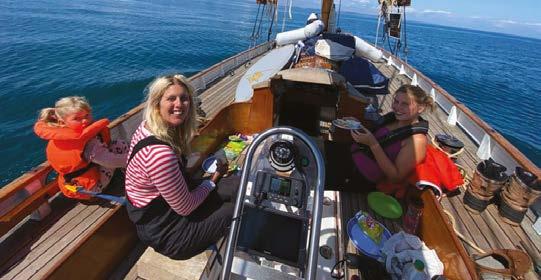
 Elisabeth McLean
Elisabeth McLean
My name is Jack Romano, editor of Viva Lancia! , the magazine of the Lancia Motor Club UK and one of our members has written in with the story of the Insam-Lancia powered boat that featured in your September issue. We were already aware of the boat and its Lancia Aprilia engine. In fact it’s a precursor (for want of a better word) to a whole series of Lancia-powered boats, most notably the ‘Flaminia’ class boats (Lancia V6) built by Timossi. Three of these survive, one was restored circa 2017 and is in regular use. The owner managed to have it restored by the very same man who built it at Timossi in 1969.
Jack RomanoMemories flooded back when CB reported that Coral of Cowes still languished on the Souda Bay seafloor. I helped Captain Hugh Roberts get the old girl around the track at the 2017 Spetses Classic Yacht Regatta. With racing ended, we sailed home to Souda Bay, where I spent a couple of weeks onboard, shooting the breeze and re-stowing some heavy kit. The press, speculating about his mysterious death, described the captain as an eccentric aristocrat. The howling dog clinging to the crosstrees bewailing his master’s fate added colour to the story. He certainly came from a privileged background. Fine-tuning the family’s E-types before his teens led to racing at Goodwood. Landing his Tiger Moth on the house lawns as a 13-year-old caused trouble with the estate gardener. After training with the Royal Navy, he gained his Master’s Ticket with the P&O Line. Needing ready money, he bought single-engine planes in America then flew them solo across the Atlantic, landing on fumes in Europe. Handsome profits were invested in buying an old DC3 and running a cargo operation in the Amazon Basin. At one point he and a group of pals sailed an ancient ga -rigged yawl down to the South Georgias for a lark to see if money could be made from salvaging iron shipwrecks. After auctioning his English percussion revolver collection at Christie’s, he bought Coral with an eye to the Grand Pacific Adventure. It was not to be! Now they lie in their respective graves, Coral and her captain, both scuppered by fate. One has gone the way of all flesh, RIP. The other, made from finest Burmese teak, awaits a miracle.
Martin van der Wal

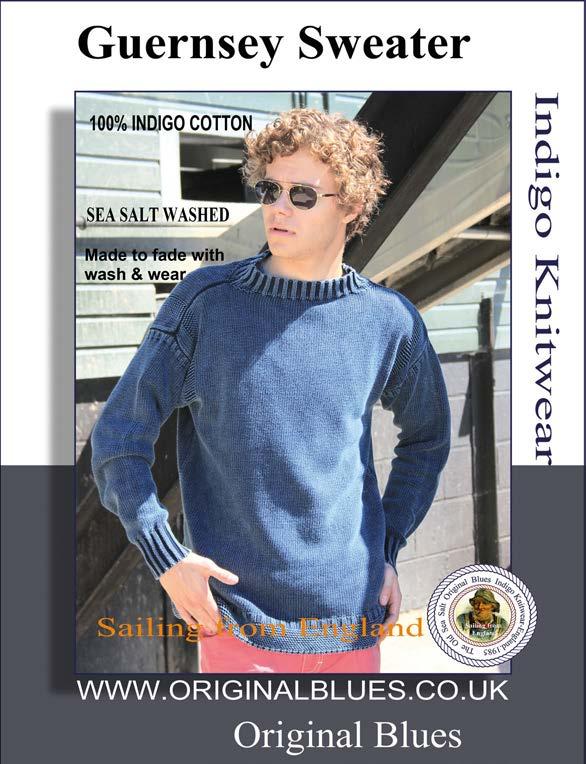


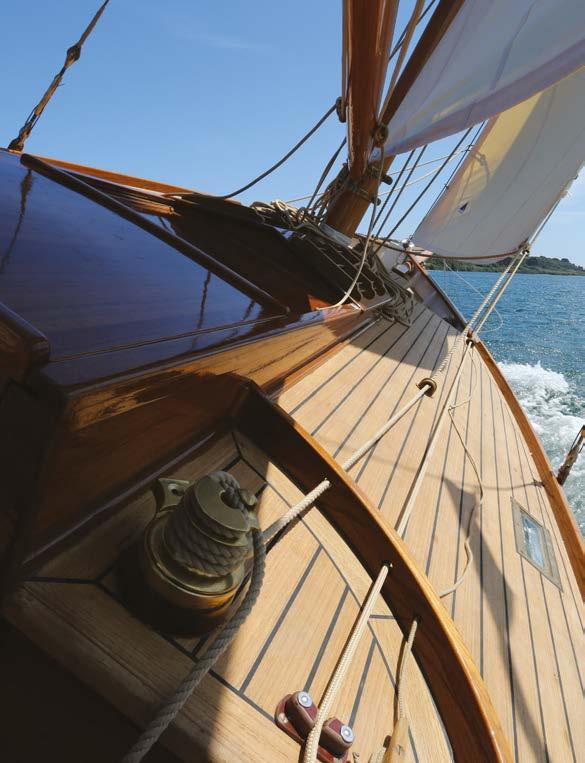


Penetrating
Penetrates deeply -




Flexes with
Epoxy strength

Made largely
Flexes with
Totally
For decades, these little launches designed by Ettore Bugatti were forgotten. Now, three more have been built new
A sturdy yacht with a sturdy name, built in steel to go anywhere, and now rebuilt as strong as ever
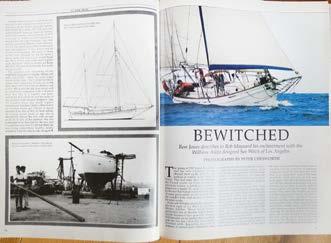
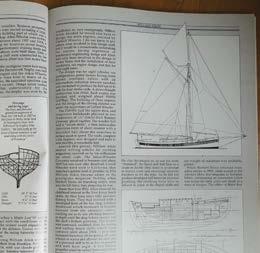


Charles Nicholson’s iconic development class at Bembridge Sailing Club, celebrating 125 years this year

Atlantic crossing: voyage of self-discovery
Around Britain and Ireland: thrills and spills
British Yachting Awards 2022



Grenadies: insider’s guide to this paradise
Solent Weekend: Plan the perfect getaway
Boat test: Windelo 54 AND Viko S35
Photographer James Robinson Taylor, late summer action at Saint-Tropez, Washington, Geneva and Essex, racing in the 12-M class and more


Three decades ago, the cover boat had a strong, double-ended, working look – the sort of vessel that you might imagine had descended from a Scandinavian fishing boat of some sort. She is, in fact, Sea Witch, a 45ft design by the American William Atkin, not a well-known name even today, but the man behind the design of Sir Robin Knox-Johnston’s Suhaili, which also featured in the issue, alongside a biography of the Atkin by our technical editor at the time, John Leather. Mark Fishwick looked at the Finesse 24 in our intermittent ‘A ordable Classics’ series, and recalls a childhood meeting with the builder, when his father was considering buying one (he went for a GRP yacht in the end). In the ads, Loran plotters vied with Walker towed logs in a stand-o between old and new technology. It is interesting to note that while most of the world was following German reunification in 1990, a much smaller news story (the world’s first web page) would have far greater ramifications for the future. It seemed sailing was not far behind the technological curve, with the early GPS sets coming out around the same time.


Available online or ordernow post-freefrom chelseamagazines.com/shop



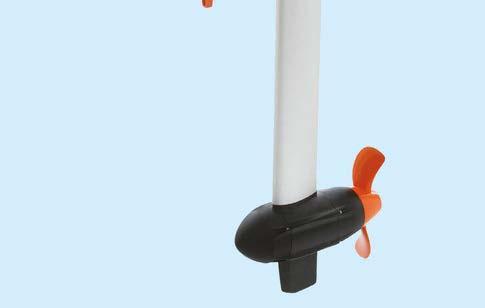


In the popular 2-4hp category, the latest electric outboards – with their integral and rechargeable lithium batteries – have transformed the market, rendering petrol motors all-but obsolete. Advantages include:
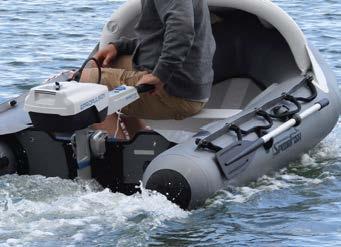

› Ease of Use Switch on, twist the tiller handles, go. Almost anybody can do it; no experience, strength or mechanical knowledge is needed.
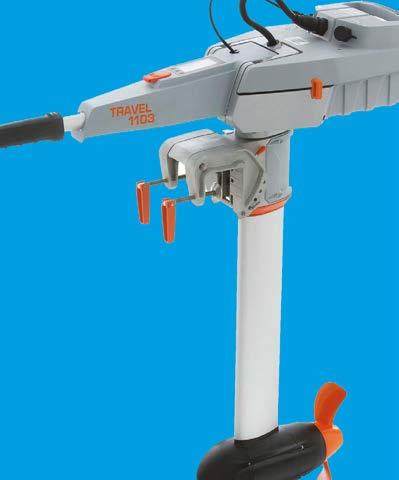

› Ease of Handling The batteries are removable, and the “pass up and down” weight (the shaft/motor assembly) is then 10kg or less.

› Ease of Storage These electric motors divide into components, don’t leak oil or petrol, and don’t mind which way up they’re stored.


Electric motors are a delight to use.
› Power Forget slow speed “trolling motors”, these 1kW electrics have huge torque (more like a 3hp petrol).

› Range There are many variables, but most users achieve at least 9 to 10 nautical miles per charge, at 4 to 5 knots (2.5m inflatable dinghy). Much more if you slow down a little.

› Reliability Many outboard motors don’t get used very often, and small petrol motors hate this. Electric outboards have fewer parts in general, and in particular there’s no carburettor to “gum up”.
Of course, it’s not all perfect. The range may still not be enough for some users. And they’re undeniably More Expensive than petrol outboards, mostly because lithium batteries are expensive. But that extra upfront cost is largely offset by their Lower Lifetime Running Costs, including (almost) No Servicing.

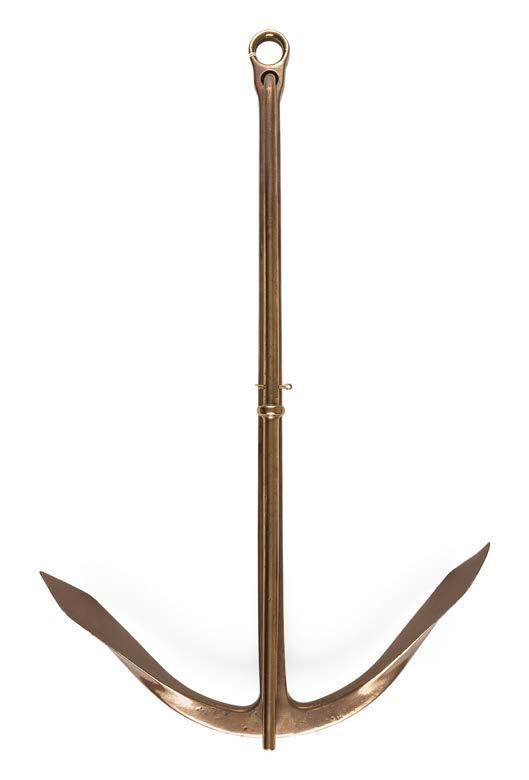
As with varnish, we’d caution against using anchors near any kind of marine environment, such as water for example. True, a rusty, barnacleencrusted anchor protruding menacingly from the bow of a yacht also festooned on its stern with ironmongery of the type made popular in the Spanish Inquisition does lend a measure of blue-water been-there done-it salty sea-dog swagger and makes a considerable impression on entering a marina – usually a moment or two before making a rather larger impression on the topsides of a yacht whose owner has just sat back to admire his 15th coat of varnish.
This is generally considered poor etiquette, but understandable considering that after 10 months at sea avoiding anchoring long-term, live-aboards often forget their manners in their haste for a Cornish pasty and shower. That said, if the varnisher had been a little more vigilant they might have noticed the double yellow Q flags flying from the shrouds of the new arrival. As a result of a typo in the Rules of the Road, many leisure sailors mistakenly take these to mean “I require health clearance” when in fact they spell out loud and clear: “I require a healthy clearance.”
The same also applies when encountering such boats in so-called anchorages, which are marked on so-called charts in close proximity to wreck symbols. That should be warning enough to avoid them, but nevertheless anchorages remain notorious for anchoring.
Take Pyefleet Creek, which is “highly recommended” by the otherwise excellent and contradictory East Coast Pilot and East Coast Rivers pilot guides. While one says that Pyefleet “offers that sense of remoteness for which so many of us feel a need” and “everyone except the waterskiers is there for peace and quiet,” the other reckons it “a favourite among east coast yachtsmen, which means it can become very crowded.” Such riotous solitude!
While holding is “good” this is by no means at odds with the fact that “in places the mud is very soft and boats do drag their anchors unexpectedly.”
It’s also part of the “charm” that “Pyefleet mud seems to have a character of its own and a delight in sticking firmly and in great quantities to both anchor and chain, making recovery a messy business. It is common to see boats motoring seaward as their crews expend much energy dipping buckets and scrubbing the mud off their ground tackle, decks and topsides.” What larks!
Another thing that makes it a “favourite” is that in an “east or west blow against the tide, the whole creek can cut up rough with boats pitching and tossing all over the place. It can become so bad that a boat will dip its head under.” How relaxing!
So much for peace and solitude. I anchored once and used a transit, as recommended by Tom Cunliffe and others, but ended up dragging to a lay-by on the A12 when the Transit headed back to Billericay. On the Thames I find the safest, and best holding is provided by tying up to the SS Montgomery, a World War II munitions ship that broke its back when it dragged its anchor with 1400 tonnes of high explosive on board. While providing the solitude I crave – as there were no jet-skis or even other boats nearby – it did make me a little anxious.
Of course, when it comes to dragging there are heated debates about the best anchor for the job. Some of the popular types include the CQR, the In-Secure, the Dang-Thing, the Dead-Loss, the Drag-Fast and similar Last-Gasp, the Bruce, Brian and the Stuart Turner engine-shaped anchor and the Seagull outboard. It’s strange though, that people still persist in developing new kinds when the perfect anchor was developed more than a century ago by American Nathanael Herreshoff, one of the greatest naval architects of all time. As well as designing a string of America’s Cup winners, he crafted his own Herreshoff anchor, a development of the firsherman-type in lustrous, twinkling bronze and a thing of beauty that would grace the wall of any study or shop window of Tiffany’s on Fifth Avenue. Indeed, considering that a 26in Herreshoff anchor just sold at auction for $812 only a fool would risk getting it wet. If you can’t afford that I’d suggest an anchor tattoo.
Dropping the hook is the without doubt the best way to anchor, as Dave Selby reveals
“When it comes to dragging, there are heated debates about the best anchor for the job”





